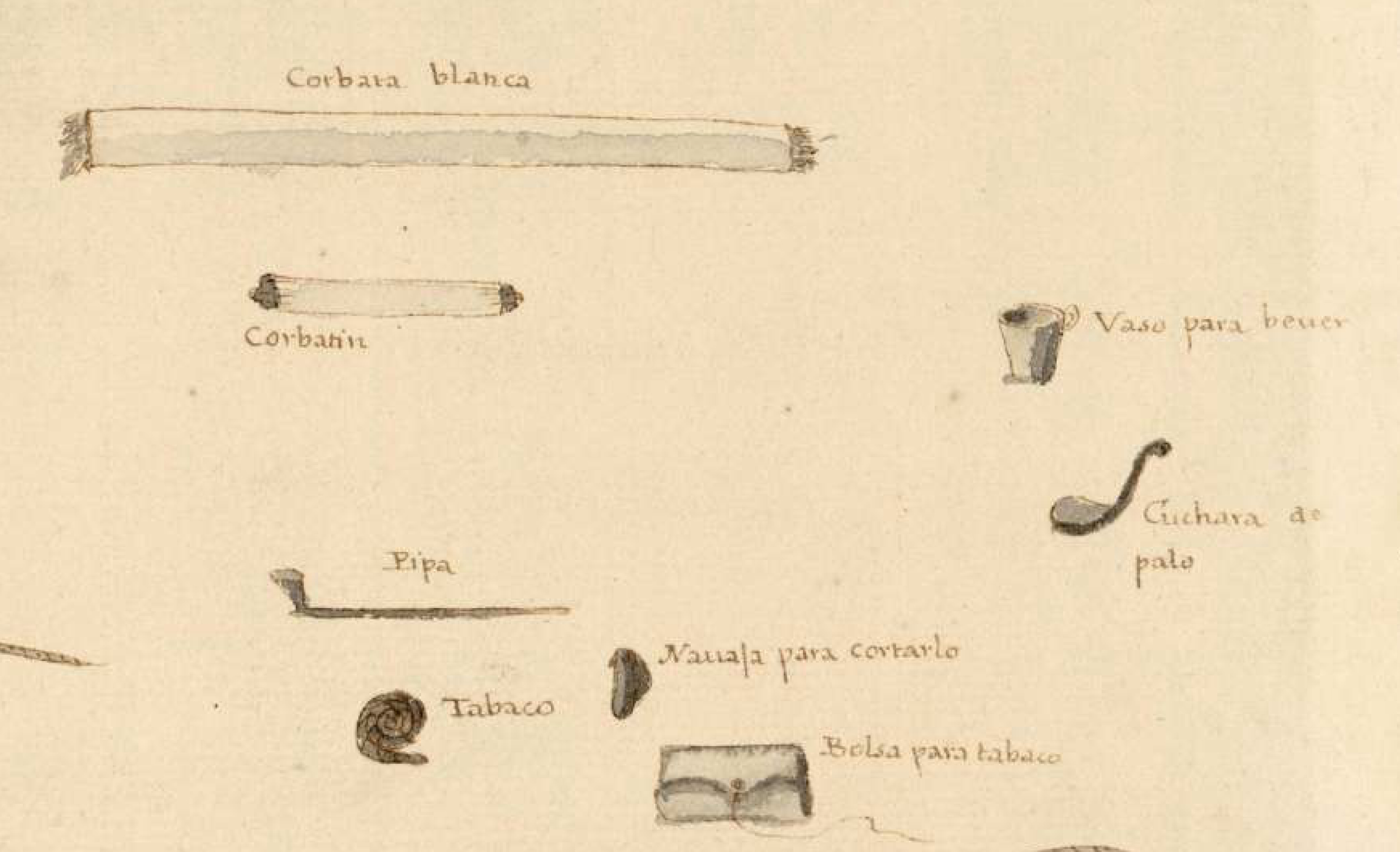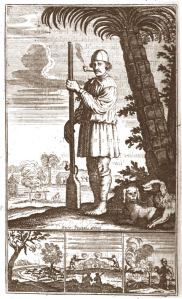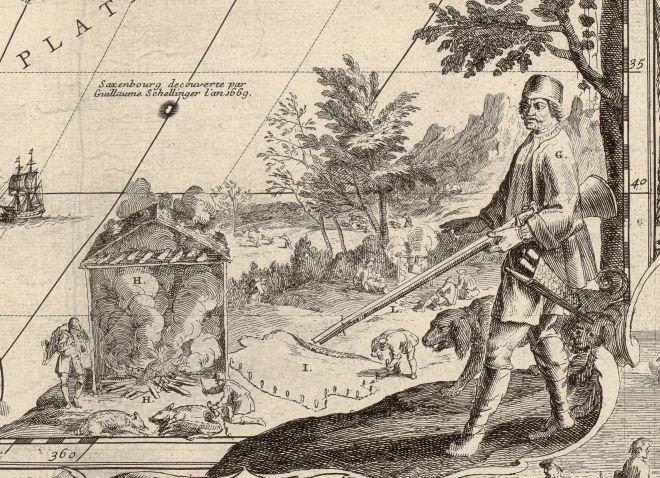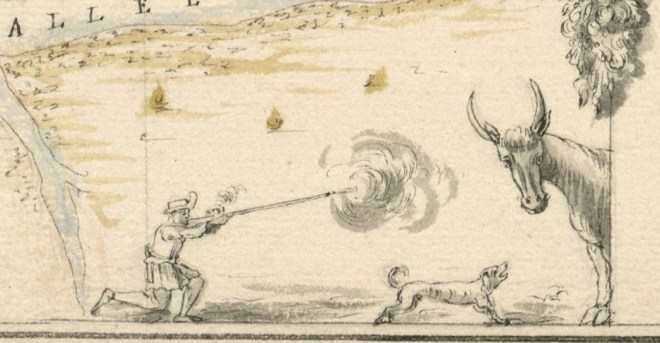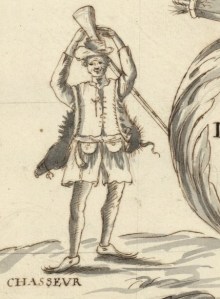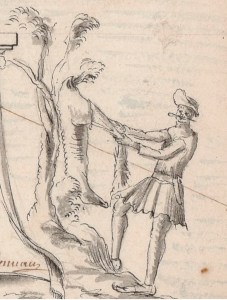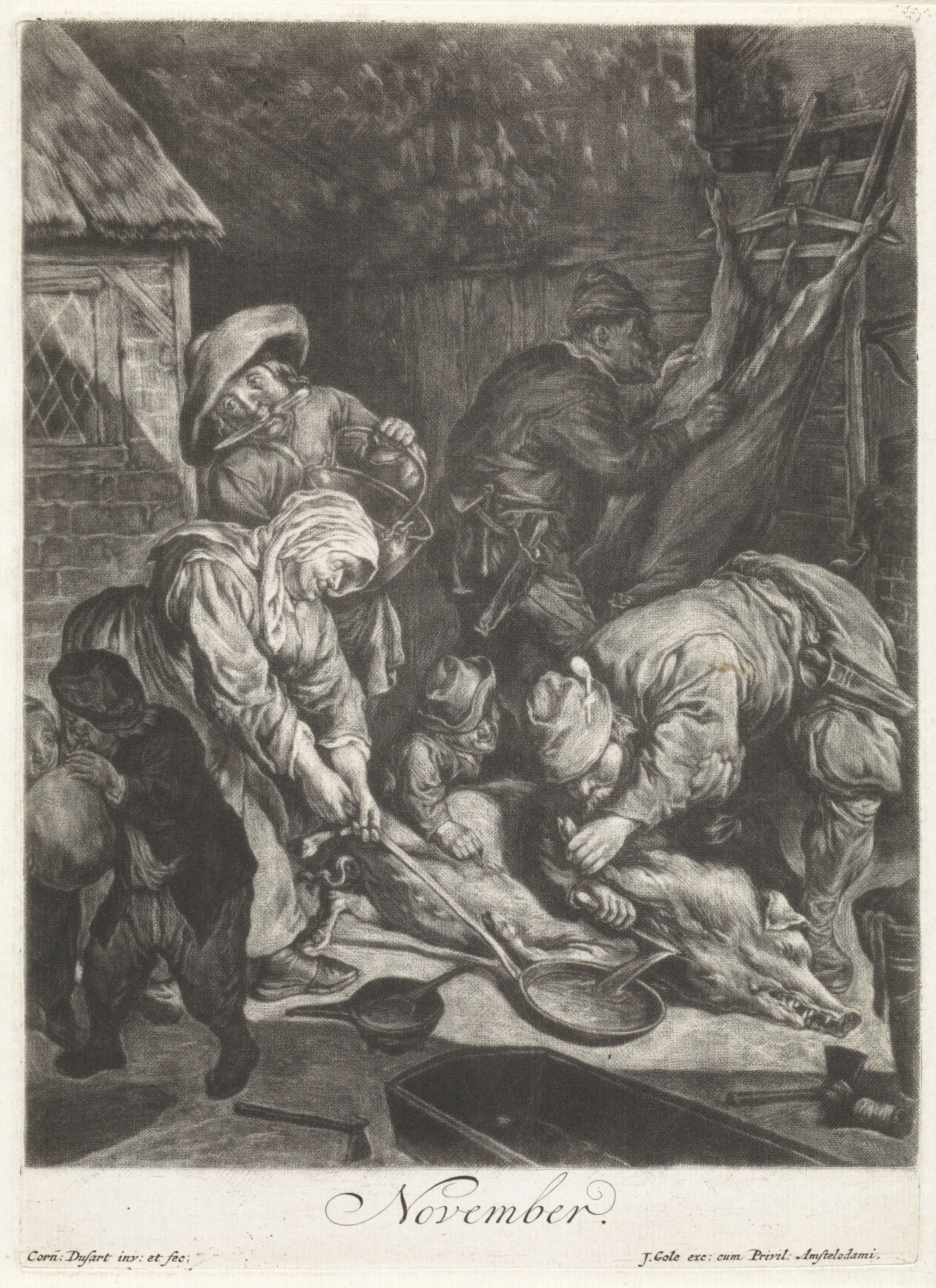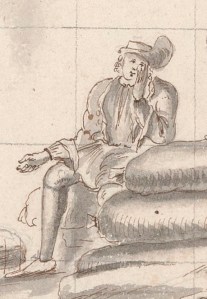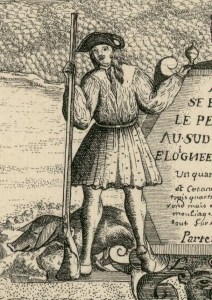Home » Pirate Myths (Page 3)
Category Archives: Pirate Myths
Pirate Versus Privateer
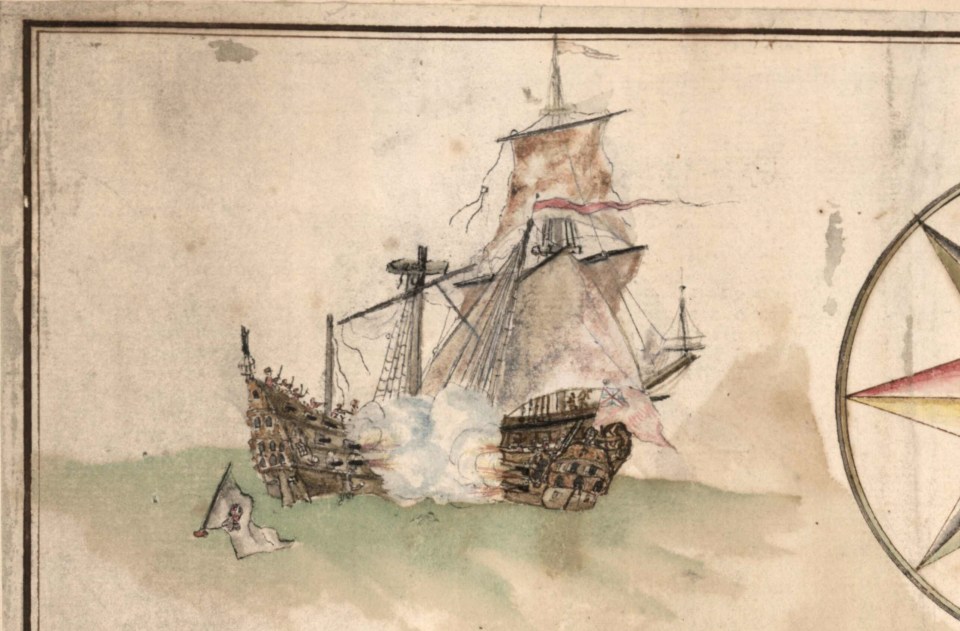
English privateer sloop engaging a Spanish merchantman during the War of Jenkins’ Ear. Detail from a chart of New Providence, 1751. Library of Congress.
A few quick notes on the use of the word pirate when the term privateer is appropriate.
It’s a minor issue, I know, this particular instance of the practice known today as “click-bait.” The practice has been around a long time, not only in political rhetoric but in marketing as well. But it has grown much worse over the past decade, and, given the state of affairs today in regard to the truth, in which outright lies often pass with too little outcry, and, almost as bad, in which mere unfounded opinion is often given equal time with solid expertise, any egregious usurpation of fact or meaning should be shunned–even in such a trivial-seeming matter of pirate versus privateer.
I am not entirely innocent of the charge myself, but in my defense it’s not been an egregious offense, and one generally committed by my publishers primarily because the word pirate is so marketable, not to mention that publishers invariably retain the right to change or even outright reject the author’s title.
For example, The Sea Rover’s Practice: Pirate Tactics and Techniques is actually about the tactics of pirates, privateers, and commerce-raiding men-of-war. But pirate is the word used in the subtitle, a decision made by my publisher. Likewise The Buccaneer’s Realm: Pirate Life on the Spanish Main 1674-1688: buccaneers were often pirates, but also often legitimate privateers as well as what might best be termed “quasi-privateers” or “quasi-pirates” operating without a legitimate commission but with a “wink and a nod” from their respective governments. Pirate Hunting: The Fight Against Pirates, Privateers, and Sea Raiders From Antiquity to the Present also discusses privateers, commerce raiders, and even early submarines. The Golden Age of Piracy is the most accurate, but, as noted already, even buccaneers were often privateers.

English privateer sloop with Spanish prize in tow during the War of Jenkins’ Ear. Detail from a chart of New Providence, 1751. Library of Congress.
Strictly speaking, piracy is armed robbery on the open seas. In the past, it was armed robbery pretty much anywhere there was ocean or land touching the ocean, at least if the thieves came by sea. Not just a crime, but a hanging crime, in other words.
Privateering, however, derives from private man-of-war, a vessel commissioned by a legitimate state to attack enemy shipping and profit from it. Lawful plundering, in other words, an entirely legal practice. A privateer might be imprisoned by the enemy if captured, but he wouldn’t be tried and hanged for piracy.
I’ve made plain in print many times that there is plenty of overlap among the various sorts of sea rover, that is, among pirates, privateers, and commerce-raiding men-of-war. That said, in most cases during the Golden Age of Piracy (circa 1655 to 1725) and afterward, the overlapping is much less common. In particular, the distinction is readily apparent everywhere except in the case of Caribbean buccaneers during the Golden Age (and strictly speaking, the only period in which true buccaneers existed).
In other words, in the majority of cases the distinction between pirate and privateer is obvious. Privateers in no ways considered themselves to be pirates, nor did anyone else except in a figurative sense by some of their their victims. Only if a privateer had overstepped his lawful authority and entered the realm of piracy might he be considered a pirate. Privateers did not claim to be pirates. Rather, they rejected the term outright. You’d get into a fight if you called a privateer a pirate, quite possibly a fatal one in the form of a duel.

“An English Indiaman Attacked by Three Spanish Privateers.” Willem van de Velde the Younger, painting dated 1677. Strictly speaking, the privateers were Ostenders commissioned by Spain. Royal Collection Trust.
So how does the use of the word pirate in the title of my books, and in similar books, differ from books and articles in which pirate is used as a term for privateer? Because my books and others like them are largely about piracy. Were they largely about privateering, the word privateering, not piracy, would appear in the titles.
Pirate and piracy have become romantic words, so it’s easy to see why they’re used whenever possible, however tenuous the connection to the subject. They’re therefore commonly used as umbrella terms for anything resembling plundering at sea, lawful or not. And they’re used in spite of the reality of piracy being anything but romantic to the usually entirely innocent victims: common seamen, coastal inhabitants, free people of color taken and sold as slaves by pirates, not to mention slaves captured by pirates and sold elsewhere, often away from their families.
In fact, it should be privateering and pirate hunting that convey the most romance, with piracy conveying revulsion, as it did in the past.
But it’s the caricature that matters: the word pirate conveys the image that draws the eye, and the description the ear.
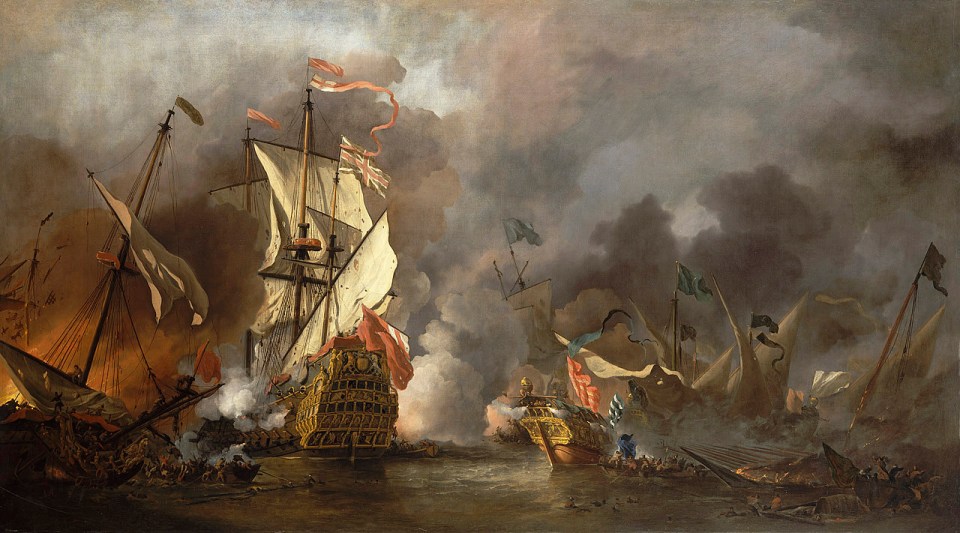
“An English Ship in Action with Barbary Vessels” by Willem van de Velde, 1678. National Maritime Museum. The Barbary vessels were privateers, commonly known as Barbary corsairs. They were not pirates, notwithstanding that the term was sometimes, and often still is, applied. They were actually legitimately commissioned privateers. The reason they are often referred to as pirates is because (1) they were not Christians, and (2) they captured and enslaved white Europeans. The irony that white Europeans enslaved black Africans (and other people of color as well) seems to have been lost. (Note: This painting was used for the Pirate Hunting dust jacket.)
Part of the problem with the lure of the word is that piracy has been re-interpreted as a form of rebellion against injustice. Pirates, we are told by too many scholars both amateur and professional, were rebels against empire, against unfair corporate practices, even–falsely–rebels against slavery. They are mostly the “good guys.” We are told that they may even have helped inspire the American Revolution and that they even threatened the existence of the English and other empires. Although there are occasional fragments of related truth in these claims, none of them are profoundly true or even slightly more than less true. They are not even as true as the suggestion that privateers were a form of pirates.
The fact is, we’re attracted to pirates so we sanitize them, we invent reasons, and let others invent reasons, why they weren’t as bad as they were. We make them palatable.
But to reemphasize, pirates were sea criminals, and in no way did their victims view them as heroes. Simply reading through a list of pirate cruelties and other depredations should be enough to correct the false image–but seldom does it. Privateers, although some did break the law at times, were by comparison Boy Scouts.
There are periods in history in which some groups of commissioned privateers behaved piratically: Spanish Caribbean privateers in the Golden Age, French and English buccaneers in the Golden Age, Colombian privateers during the South American wars of revolution (and likewise Spanish men-of-war fighting Colombian privateers), for example. But they are in the minority as compared to the enormous number of commissioned privateers, and when privateers did commit piratical acts, they were considered to be pirates. However, the majority of privateers behaved lawfully or largely lawfully, restricting their attacks to enemy shipping as permitted by law. The majority of privateers should never be referred to as pirates, nor should the term pirate be a catch-all for any sea rover, legitimate or other.
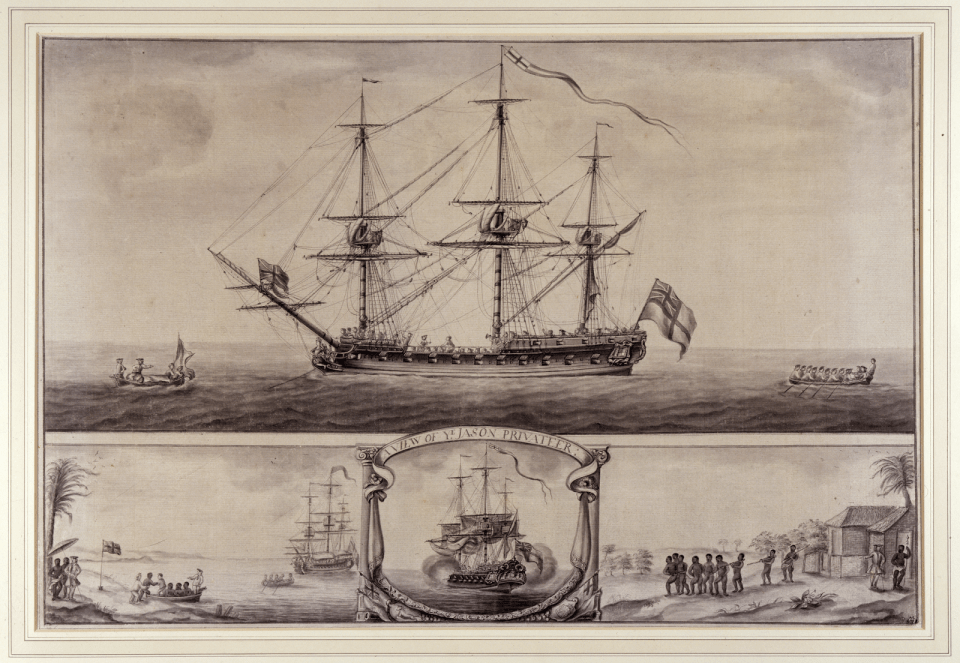
A View of ye Jason Privateer by Nicholas Pocock, circa 1760. Bristol City Museums. Downloaded from British Tars 1740 -1790.
The inspiration for this post–not that it hasn’t always been on my mind in a small, usually resigned, way–was a recent NPR “All Things Considered” segment: How Pirates Of The Caribbean Hijacked America’s Metric System. The segment does note that:
“And you know who was lurking in Caribbean waters in the late 1700s? Pirates. ‘These pirates were British privateers, to be exact,’ says Martin. ‘They were basically water-borne criminals tacitly supported by the British government, and they were tasked with harassing enemy shipping.'”
But the privateers were not tacitly supported by the British government, that is, with implied consent. Rather, they were officially supported, they had explicit consent. They were not pirates, notwithstanding some critics who considered that privateering was in some ways piracy legitimized.
Bad history and click-bait are a common combination these days, although the example above is not by far one of the many egregious examples. Still, it is hard to imagine that the word pirate was used for any reason other than to draw the reader or listener in. Worse, the phrase used in the title is “Pirates of the Caribbean,” conjuring up images of romantic buccaneers, not to mention fantasy pirates like Jack Sparrow.
The correct title of the NPR segment should have been “How Privateers Hijacked America’s Metric System.” But this has much less cachet, and is far less likely to get someone to click on the published article and read it, or tune in later to listen. The title is actually a bit doubly misleading: did the capture of a metric weight really keep the new US from considering the metric system? Or was it, as the segment does note it might have been, just a missed opportunity?

The capture of the lesser Manila galleon, the Nuestra Señora de la Encarnación y Desengaño, in 1709 by the Duke, an English privateer commanded by Woodes Rogers. From the French edition of Woodes Rogers’s description of the voyage. Voyage autour du monde, commencè en 1708 & fini en 1711 (Amsterdam: Chez la veuve de Paul Marret, 1716). Image downloaded from the John Carter Brown LUNA library.
I emailed All Things Considered on this minor matter several days ago. I haven’t heard back, even though I noted my several works on the subject of piracy and privateering. Perhaps the editors found the word click-bait offensive, or the fact that I pointed out that pretty much the same article ran in The Washington Post this past September on Talk Like a Pirate Day.
I’m not singling out NPR, this is just the most recent example I have at hand. I like NPR and have been a listener off and on for decades (mostly depending on how often I’m in my Jeep). But facts are facts, and when they’re imposters it doesn’t matter who the offender is–the offense needs to be pointed out.
The difference might be a non-issue with an educated audience, one that understands the difference between pirate and privateer. But today too many people are getting their education, such as it is, from click-bait articles on social media–articles that are ultimately misleading.
While this may seem to be nothing more than quibbling, it remains vital for the sake of truth to get facts straight. And this includes word definitions because they’re the primary means of conveying factual meaning, aka facts. We’re overwhelmed today not only with obvious liars and subtle liars, but with a large segment of society who excuse loose meaning and interpretation as a means of getting attention. It’s not only ideologues and Mammon’s imps who play fast and loose with the truth anymore, but every know-nothing and know-a-little know-it-all considers his or her wrong-headed opinion to be equal to that of the knowledgeable, facts be damned. And the disease is spreading to mainstream educated society: the Internet is making everyone lazy. How to stop this? By using facts to point out errors, misconceptions, and outright falsehoods.
For the privateer, definitions and facts made all the difference: it’s what kept him from being hanged as a pirate.
Copyright Benerson Little, January, 2018. First posted January 2, 2018.
Novels with Swordplay: Some Suggestions

Illustration by N. C. Wyeth from “The Duel on the Beach” by Rafael Sabatini, a short story soon published as the novel The Black Swan. The illustration was also used on the dust jacket of the first US edition of the novel. (Ladies Home Journal, September 1931.)
For your perusal, a list of a handful of swashbuckling historical novels–pirates, musketeers, various spadassins and bretteurs–with engaging swordplay, even if not always entirely accurate in its depiction. If you’re reading any of my blog posts, chances are you have friends who might enjoy reading some of these books, thus my suggestion as Christmas, Hanukkah, or other gifts this holiday season.
Three caveats are in order: all of the following are favorites of mine, all are set in the seventeenth and eighteenth centuries, and all are not “all” in the sense that the list, even narrowed strictly to my favorites, is quite incomplete. Without doubt I’ll add to it every holiday season. And maybe one day a list of swashbuckling films, another of table and board games, maybe even of video games too…
Upon reflection, perhaps a fourth caveat is in order as well: simply enjoy the stories and their swordplay for what they are. Don’t be too critical, especially of the latter. Except for the case of the reader who is an experienced fencer with a strong understanding of period fencing terms and technique (far more rare than you might think), complex historical fencing scenes cannot be written simply and just as simply understood. Nor can technique and actions in general be explained sufficiently for the neophyte to understand, at least not if the writer wishes to keep the action flowing. The writer must strike a middle ground, one that won’t lose the tempo and thus the reader. This is not so easily done.

Victor Hugo–Hugo to most of us, an adopted Norwegian forest stray–with a pair of late nineteenth century French foils with Solingen blades, and a Hungarian mask made in Budapest, dating to the 1930s. Because cats and swords. Or cats and swords and books.
It’s possible the Moby Dick technique would work–explain and teach prior to the event–but it’s just as likely that many readers would shun this, unfortunately. For what it’s worth, Moby Dick is by far my favorite novel and I consider it the greatest ever written. It is not, however, a book for readers who cannot step momentarily away from the narrative. As I’ve discovered after the publication of two of my books in which narrative history is interspersed with analysis and explanation, there are quite a few such readers, some of whom become plaintively irate and simultaneously–and often amusingly–confessional of more than a degree of ignorance when the narrative is interrupted for any reason. To sample this sort of reader’s mindset, just read a few of the negative reviews of Moby Dick on Amazon–not those by obvious trolls but those by apparently sincere reviewers. Put plainly, using Moby Dick as a template for swordplay scenes would probably be distracting in most swashbuckling novels.

Cover and frontispiece illustration by N. C. Wyeth for the first and early US editions of Rafael Sabatini’s Captain Blood: His Odyssey.
In regard to acquiring any of these enjoyable titles, note that some are out of print except perhaps as overly-priced modern print-on-demand editions. Even for those still in print, I highly recommend purchasing earlier copies from used or antiquarian dealers–there are plenty of highly affordable copies, just look around for them. Abebooks is a great place to start, but only if you have no local independent used or antiquarian bookstores available to try first. And these days, alas, there might not be any…
Why an older edition? Because the scent of an old book helps set the period atmosphere. Add a comfortable chair, a sword or two on the wall, a fireplace in a reading room or a fire pit on the beach nearby, and, if you’re of age to drink, perhaps some rum, Madeira, or sherry-sack on a side table, and you’re ready to go. Or Scotch, especially a peaty single malt distilled near the seaside, it will evoke the atmosphere of Sir Walter Scot’s The Pirate. Scotch always works.
So just sit back and let the writer carry you along. Don’t forget to imagine the ring of steel on steel and the sharp smell of ozone after an exceptionally sharp beat or parry. And if you really enjoy scenes with swordplay, there’s no reason you can’t further your education by taking up fencing, whatever your age or physical ability. If you’d rather begin first by reading about swordplay, you can start here with Fencing Books For Swordsmen & Swordswomen. And if you’re interested in how swashbuckling novels come to be–romance, swordplay, and all–read Ruth Heredia’s outstanding two volume Romantic Prince, details below.
Captain Blood: His Odyssey by Rafael Sabatini
Better known by its short title, Captain Blood, I list this first even though there’s really no significant description of swordplay, not even during the duel that is one of the best parts, of many, in the 1935 film version starring Errol Flynn. You must imagine the sword combat, yet in no way does it detract from this great swashbuckling romance that has inspired readers and writers worldwide, not to mention two major film versions (1924 and 1935). It is truly a modern classic. If you really want to judge the quality of the prose, read a few passages out loud: they’re wonderfully lyrical and evocative.

Photoplay edition from 1935, with Errol Flynn as Captain Blood on the cover. Although technically a photoplay edition, the only film images are to be found on the end papers. A nearly identical dust jacket was included with a non-photoplay edition at roughly the same time, the only difference being that the three small lines of film production text are missing.

Wonderful artwork from a 1976 US paperback edition of Captain Blood.
Captain Blood Returns by Rafael Sabatini
If it’s a description of swordplay in a tale of Captain Blood, you’ll have to settle for the “Love Story of Jeremy Pitt” in Captain Blood Returns, also known in UK editions as the Chronicles of Captain Blood. Great Captain Blood fare, follow up it with The Fortunes of Captain Blood.

Dust jacket for the first US edition. Artwork by Dean Cornwell.

Endpapers in the first US edition of Captain Blood Returns, artwork by Dean Cornwell.
The Black Swan by Rafael Sabatini
One of the greatest of swashbucklers whose plot leads, line after line, to a dueling climax. The 1942 film of the same name, starring Tyrone Power and Maureen O’Hara, doesn’t do the book justice, not to mention takes great liberties with both plot and character.

Dust jacket, first and early US editions. Art by N. C. Wyeth.

Front cover of dust jacket of first UK edition (Hutchinson).
Fortune’s Fool by Rafael Sabatini
An embittered former Cromwellian officer reassessing his life during the early days of the Restoration–and proper use of the unarmed hand in a sword fight too!

Frontispiece by Aiden L. Ripley to early US editions of Fortune’s Fool.
Venetian Masque by Rafael Sabatini
A novel evoking many of the elements of my Hungarian fencing masters’ own history: spies, duels, intrigue, war, revolution, narrow escapes, and above all, courage. Plus Venice!
“With delicate precision he calculated the moment at which to turn and face them. He chose to do it standing on the lowest step of the bridge, a position which would give him a slight command of them when they charged. As he spun round, he drew his sword with one hand whilst with the other he swept the cloak from his shoulders. He knew exactly what he was going to do. They should find that a gentleman who had been through all the hazards that had lain for him between Quiberon and Savenay did not fall an easy prey to a couple of bully swordsmen…”
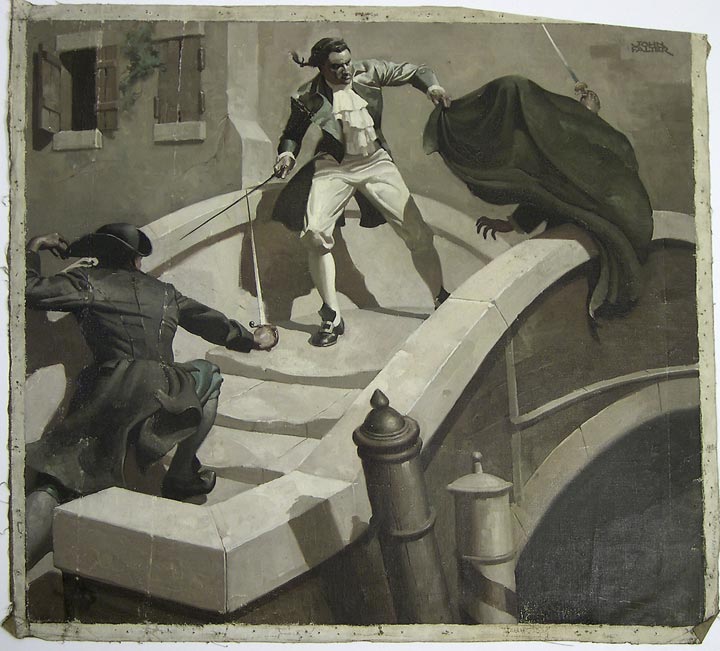
Illustration from “Hearts and Swords” in Liberty Magazine, 1934. The story would become the novel Venetian Masque. The illustration has been copied from the John Falter collection at the official State of Nebraska history website. Rather sloppily, in both instances in which Rafael Sabatini is referenced, his name is spelled Sabitini. Even the State of Nebraska must surely have fact checkers and copy editors.
Scaramouche by Rafael Sabatini
“He was born with the gift of laughter and a sense that the world was mad.” Add a sword and you have Scaramouche.
To my mind, a tie with The Black Swan in regard to a novel built around swordplay, and far superior in its scope. Easily has the best–most evocative, that is–description of a fencing salle, hands down.

To Have and To Hold by Mary Johnston
Listed here primarily as representative of the genre at the time (the late nineteenth century) and because it influenced Rafael Sabatini, the novel has most of the classic clichés of the genre, including the duel for command of a pirate ship, something that never actually happened. A gentleman swordsman, pirates, Native Americans, a damsel incognita in distress… The duel takes place, as best as I can tell, on Fisherman’s Island off Cape Charles, Virginia.

Frontispiece by Howard Pyle.

Dust jacket from the 1931 US edition. Illustration by Frank Schoonover, a student of Howard Pyle. The painting is an obvious homage to Pyle’s painting for the original edition.
Adam Penfeather, Buccaneer by Jeffery Farnol
The prequel to the following two novels, you may either love or hate the style in which it’s and the rest are written, the dialogue in particular. Even if you don’t much care for the style–I don’t much–the series are worth reading anyway for the adventure and swordplay, often including sword-armed women in disguise. Farnol will never come close to replacing Sabatini to me, but this doesn’t stop me from enjoying Farnol’s swashbucklers. And at least Farnol’s dialogue doesn’t sound like, to paraphrase a friend of mine, suburbanites chatting inanely at a PTA meeting–a problem with much dialogue in modern historical fiction and television drama.
As for swordplay, Farnol often takes the evocative approach, providing broad strokes to give a sense of the action without providing detail which might confuse non-fencers:
“Once more the swords rang together and, joined thus, whirled in flashing arcs, parted to clash in slithering flurry, their flickering points darting, now in the high line, now in the low, until Adam’s blade seemed to waver from this line, flashing wide, but in that same instant he stepped nimbly aside, and as Sir Benjamin passed in the expected lunge Adam smote him lightly across broad back with the flat of his blade.”
Non-fencing authors take note of the critical vocabulary for swordplay scenes: rang, flashing, slithering, flickering, darting, flashing…

Dust jacket for the first US edition. The first UK edition has a boat instead…
Black Bartlemy’s Treasure by Jeffery Farnol
Great swashbuckling fare, the first part of a two novel series.

Easily one of the most evocative dustjackets on any pirate or swashbuckling novel.
Martin Conisby’s Vengeance by Jeffery Farnol
This quote alone sells this sequel to Black Bartlemy’s Treasure: “So-ho, fool!” cried she, brandishing her weapon. “You have a sword, I mind—go fetch it and I will teach ye punto riverso, the stoccato, the imbrocato, and let you some o’ your sluggish, English blood. Go fetch the sword, I bid ye.”

The Pyrates by George MacDonald Fraser
Enjoyable parody of swashbuckling pirate novels and films, much influenced by the works of Rafael Sabatini and Jeffery Farnol. Fraser, an author himself of wonderful swashbuckling adventure, was a great fan of Sabatini.

The Princess Bride by William Goldman
Requires no description. The swordplay, like that in The Pirates above, is affectionate parody, and much more detailed than in the film.

25th edition, with map endpapers of course!

Nicely illustrated recent edition.
Rob Roy by Sir Walter Scott
Excellent if mostly, if not entirely, historically inaccurate tale of Rob Roy MacGregor told through the eyes of a visiting Englishman. It has a couple of excellent descriptions of swordplay, ranging from a duel with smallswords to action with Highland broadswords.

Le Petit Parisien ou Le Bossu by Paul Féval père
I’m going to pass on Alexandre Dumas for a variety of reasons, not the least of which is that I’ll eventually devote an entire blog to him. If, however, you feel he should be represented here, The Three Musketeers series is where to begin, but you must read the entire series of novels. Be aware that many such series are actually abridged. For a slightly different Dumas take on the swashbuckler, try Georges (an exception to the seventeenth and eighteenth century rule, an almost autobiographical novel in its focus on race and prejudice) or The Women’s War (or The War of Women, in French La Guerre des Femmes). Both are favorites of mine.
Instead, I’ll suggest a great swashbuckler by one of Dumas’ contemporaries. Le Petit Parisien ou Le Bossu is a true roman de cape et d’épée (swashbuckling novel) of revenge from the which the line, “Si tu ne viens pas à Lagardère, Lagardère ira à toi!” (“If you will not come to Lagardère, Lagardère will come to you!”), has passed into French proverb. The novel has been made into film at least nine times, plus into a couple of television versions as well as several stage versions. Unfortunately, I’m aware of only one English translation, and it is excessively–an understatement–abridged. Alexandre Dumas, Paul Féval, Rafael Sabatini are the trinity who truly established the swashbuckler as a significant literary genre.

Bill advertising Le Petit Parisien ou Le Bossu by Paul Féval, 1865. ( Bibliothèque Nationale de France.)
Cyrano de Bergerac by Edmond Rostand
Not a novel, but mandatory reading nonetheless, with one of the two greatest stage duels ever written, the other being that in Hamlet. Wonderful drama, philosophy in action, and sword adventure, including a duel fought to impromptu verse. Like Captain Blood, it is one of the truly inspirational swashbucklers. To be read at least every few years, and seen on stage whenever available. There are several excellent film versions as well.

Theater program, 1898. (Bibliothèque Nationale de France.)
The Years Between &c by Paul Féval fils & “M. Lassez”
Two series of novels of the imagined adventures of the d’Artagnan of Alexandre Dumas and the Cyrano of Edmond Rostand, filling the twenty years between The Three Musketeers and Twenty Years After in the first, and immediately following Twenty Years After in the second. The books are filled with the expected enjoyable affrays and other adventures of the genre, including the usual improbable circumstances and coincidences. The first series consists of The Mysterious Cavalier, Martyr to the Queen, The Secret of the Bastille, and The Heir of Buckingham, published in English in four volumes. The second includes State Secret, The Escape of the Man in the Iron Mask, and The Wedding of Cyrano, published in English in two volumes as Comrades at Arms and Salute to Cyrano.
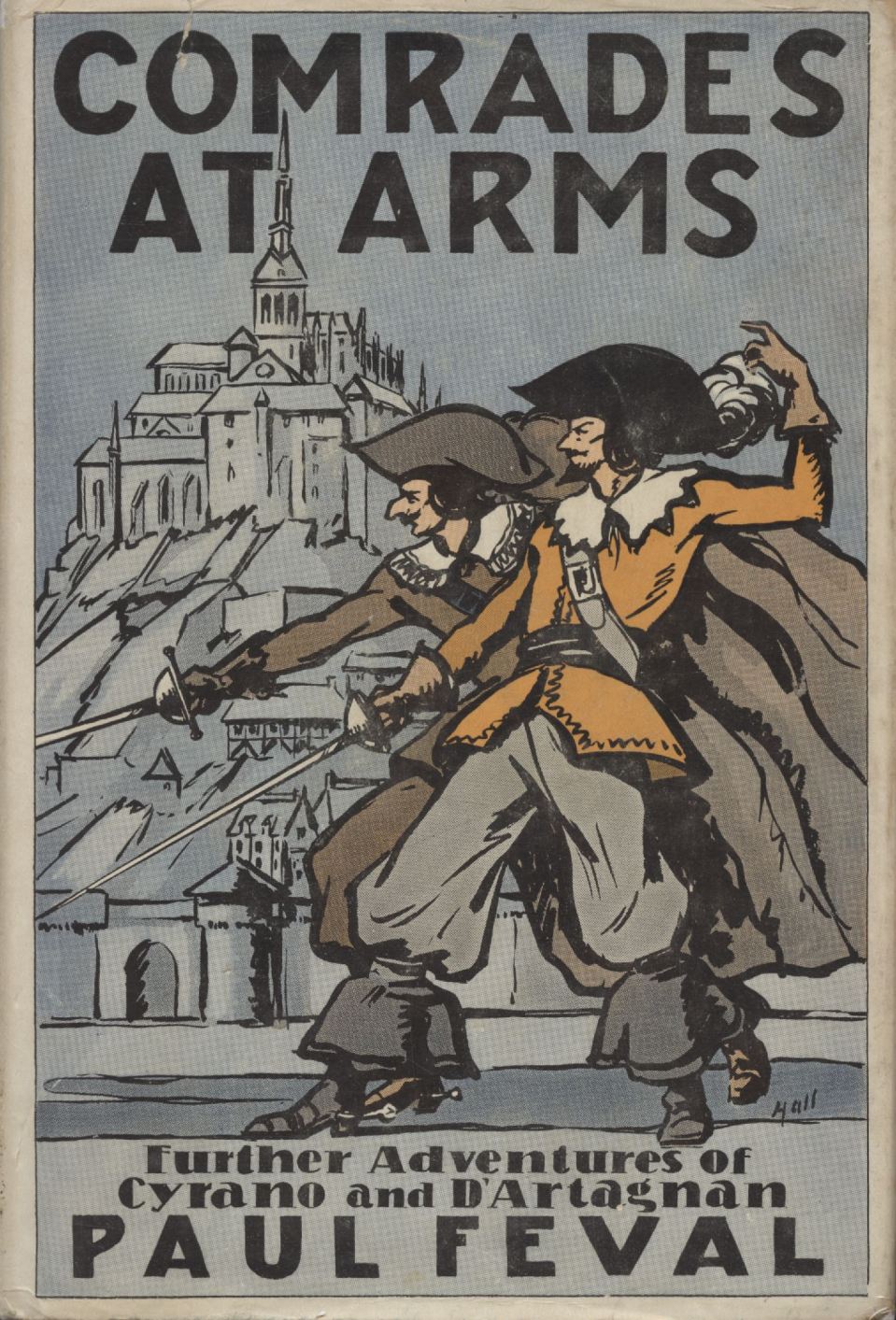
Comrades at Arms dust jacket of the US and Canada edition (New York and Toronto: Longmans Green and Co, 1930).
The Devil in Velvet by John Dickson Carr
Fully enjoyable read about a modern history professor who travels to the seventeenth century via a bargain with the devil. The professor discovers that his modern swordplay is superior to that of the seventeenth century–a wonderful idea for a novel but otherwise flawed in reality. At best, if the professor were a “modern” epee fencer, there might be parity. But who cares? After all, who can travel back in time anyway except in the imagination? If you’re a fencer well-versed in historical fencing versus modern (again, not as many as you might think, including some who believe they are), suspend your disbelief. And if you’re not, just enjoy the novel for what it is.


Wonderful endpapers!
Most Secret by John Dickson Carr
Pure genre by the famous mystery writer, this time entirely set in the seventeenth century. Cavaliers, spies, and a damsel in distress!

Dust jacket, Most Secret (London: Hamish Hamilton, 1964).
The Alatriste Novels by Arturo Pérez-Reverte
Leaping forward almost two hundred years, the Alatriste novels are a highly recommended recent series by one of Spain’s great novelists, although some critics note that the books are a bit dark. I’d call them realistic. Unfortunately, the latest of the series, El Puente de los Asesinos (The Bridge of the Assassins or The Assassin’s Bridge) has not been translated into English and doesn’t appear likely to be anytime soon, if at all, an apparent casualty of insufficient sales of the previous volumes and a reflection upon the state of the genre at the moment. That the genre should not have a larger readership given the times we live in is curious, but perhaps the audience awaits a few real-life swashbuckling heroes to reappear first. I have read The Assassin’s Bridge, but in French, and enjoyed it. My Spanish is simply not up to the task. The first six volumes are available in English translation. I also suggest The Fencing Master (El Maestro de Escrima) by the same author.

Romantic Prince by Ruth Heredia
For readers seeking to understand how written romances come to be, you can do no better than to read Ruth Heredia’s two Romantic Prince volumes: Seeking Sabatini and Reading Sabatini. The first is a biography of Rafael Sabatini, the second a guide to reading his many works, including some discussion of swordplay. Ruth Heredia is the preeminent expert on all things Rafael Sabatini. Long an officer and significant contributor to the Rafael Sabatini Society, she is a gifted writer in her right, and, in my own experience, an eloquent voice for sanity, empathy, and justice in a mad world. Originally published in now hard-to-find soft cover, her two volumes are now available in revised editions for free for personal use by requesting them from the author. You can find details at attica-ruth.


Fortune’s Whelp by Benerson Little
Last, a blatant effort at self-promotion, although I honestly did enjoy writing the swordplay scenes (not to mention working them out sword-in-hand), and I do enjoy re-reading the associated passages, or at least as much as I’m able to enjoy my own writing (the urge to revise and improve, even after publication, is quite distracting). A sequel, Fortune’s Favorite, is forthcoming, and at least another after it. Then, if all goes well, a series of prequels.

Fortune’s Whelp (Penmore Press, 2015).

A swashbuckling descendant of sea roving Norse felines. Because cats and swords. If it’s one thing a swordsman or swordswoman can always use, it’s feline grace, tempo, and speed, not to mention sardonic cold-blooded cool.
Copyright Benerson Little 2017. First published December 14, 2017. Last updated April 14, 2020.
Of Pirates & Wooden Legs

“Pirate Dreaming of Home” by Norman Rockwell, Saturday Evening Post cover, June 14, 1924. Although the painting evokes the popular caricature of the pirate (the “pirate boot” is the most egregious cliché), it does contain a few elements of truth, as much in attitude as in the wooden leg, although the latter would be career-ending for most sea rovers. The painting is also clearly based on Howard Pyle’s famous painting, “The Buccaneer Was a Picturesque Fellow,” and may be intended to represent the same buccaneer later in life, or perhaps is simply an homage to Pyle. (Norman Rockwell Museum.)
“[B]y which Means we were in hopes to have out-sailed the Privateers, but one them still came up with us; which we were preparing to engage, when the Seamen came to me in a Body, and told me they would not fight, by Reason they said they did not understand there was any Provision made for them, in case they were wounded; that if they lost a Leg or an Arm, they must be Beggars all their Life after.”
So wrote Capt. Nathaniel Uring, commanding the “Packet-Boat” Prince George (a swift frigate used for mail, passengers, and light cargo), of his crew’s response when called upon to prepare to defend against two French privateers near Scilly in December 1707. Without disability compensation, the great danger of losing a limb in battle was not worth the risk to them, even though while in the Caribbean they had fought against a single, smaller privateer at long range. From A History of the Voyages and Travels of Capt. Nathaniel Uring, 2nd ed. (London: John Clarke, 1727).
So associated with sea battles were timber legs, that even song lyrics mentioned them:
Now, Boys, who wins a Golden Chain?
Ne’er fear a Wooden Leg.
–Anon., “The Sea-Fight, A Song,” 17th century
And indeed, between round shot, large splinters (size-wise, think various lengths of 2x4s, see damage images below), and small shot, it was not uncommon for more than one crewman to lose a leg, arm, or digits after a protracted combat, either immediately due to bone and tissue damage, or later due to gangrene:
“When [wee] came to see what damage [wee] had sustained found our Cheife Mate, Mr Smith, wounded in the legg, close by the knee, with a splinter or piece of chaine, which cannot well be told, our Barber had two of his fingers shott off as was spunging one of our gunns, the Gunner’s boy had his legg shott off in the waste[,] John Amos, Quartermaster, had his leg shott off at the helme[,] the Boatswaine’s boy (a lad of 13 years old) was shott in the thigh, which went through and splintered his bone, the Armorer Jos Osbourne in the round house wounded by a splinter just in the temple[,] the Captain’s boy on the Quarter Deck a small shott raised his scull through his cap and was the first person wounded and att the first onsett. Wm Reynold’s boy had the brim of his hatt 1/2 shott off and his forefinger splintered very sorely. John Blake turner, the flesh of his legg and calfe a great part shott away.” From the letter by eyewitnesses Solomon Lloyd and William Reynolds to Sir John Gayer describing the battle between the ship Dorrill and the pirate ship Mocha in 1697.
The most famous English surgeon of the 17th century, Richard Wiseman, wrote in his famous text on surgery that “In our Sea-fights oftentimes a Buttock, the Brawn of the Thigh, the Calf of the Leg, are torn off by Chain-shot and Splinters.”
Worse, some surgeons were too quick to amputate. Again, Richard Wiseman: “Amongst the Cruisers in private Fregats from Dunkerk, it was complained, that their Chirurgeons were too active in amputating those fractured Members [arms and legs]. As in truth there are such silly Brothers, who will brag of the many they have dismembered, and think that way to lie themselves into credit. But they that truly understand Amputation and their Trade, well know how villanous a thing it is to glory in such a work.”

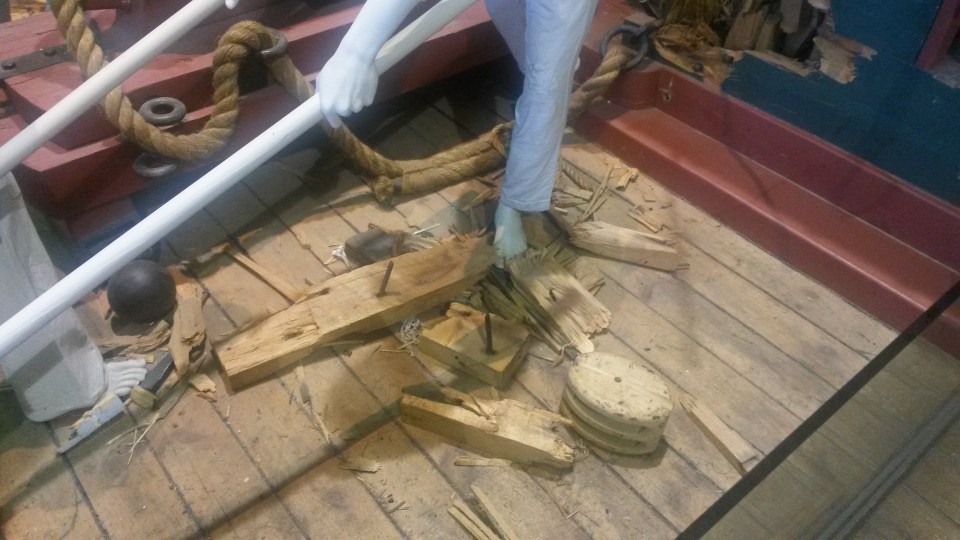
Photographs I took two or three years ago at the Erie Maritime Museum (Erie, Pennsylvania), home base of the Flagship Niagara, on board which was one of my daughters as crew. The damage was caused by test shots against an authentically constructed section of a British man-of-war. Not only could various shot and falling spars cause the loss of limbs, so could large splinters, either via immediate damage or via gangrene. For those of you who may be confused by a Mythbusters episode suggesting that splinters caused little damage, remember that the show is entertainment, not legitimate research and evaluation. There are literally hundreds if not thousands of documented cases of the great damage to crew done by splinters, from death to maiming, including loss of limbs. Further, it was common practice in men-of-war with large guns (cannon) to decrease the amount of powder in order to increase the smashing and splinter-producing effect of round shot (cannonball). A seaman was more likely to be injured or killed from peripheral damage caused by a round shot–splinters, especially–than by the shot itself.
Much of the origin of the idea that wooden legs were common among pirates may be due to buccaneer articles of the second half of the seventeenth century:
“Lastly, they stipulate in writing what recompense or reward each one ought to have that is either wounded or maimed or maimed in his body, suffering the loss of any limb, by that voyage. thus they order for the loss of a right arm 600 pieces-of-eight, or 6 slaves; for the loss of a left arm 500 pieces-of-eight, or 5 slaves; for the right leg 500 pieces-of-eight, or 5 slaves; for the left leg 400 pieces-of-eight, or 4 slaves; for an eye 100 pieces-of-eight, or one slave; for a finger of hand the same reward as for the eye.” (Alexandre Exquemelin [John Esquemeling], The Buccaneers of America. London: Crooke, 1684.)
A copy of flibustier articles dating to 1688–“Copie de la charte-partie faite entre M. Charpin, commandant la Sainte-Rose“–includes the following article: “Item. Tout homme estropié au service du bâtiment aura 600 pièces de 8 ou 6 nègres a choix s’il s’en prend.” The injured, whether he lost an arm or leg, had the choice of six hundred pieces-of-eight or six slaves.
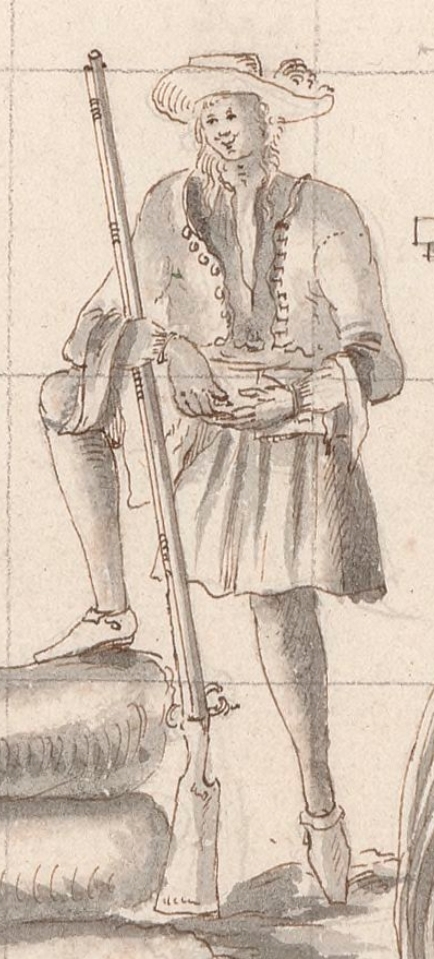
Eyewitness image of a French flibustier of the 1680s. For information on this and similar images, see The Authentic Image of the Real Buccaneers of Captain Blood: His Odyssey by Rafael Sabatini.
Similarly, writing of the year 1694, Caribbean chronicler Father Jean-Baptiste Labat noted that among French flibustiers, “Ceux qui sont estropiez du’un bras ou d’une jambe emporteé, ou rendu inútiles, ont six cens écus pour chaque membre…” That is, six hundred pieces-of-eight for the physical loss of an arm or leg, or of the use of it. The original buccaneer and flibustier articles were still in use even though true English buccaneering had disappeared and French buccaneering–la flibuste–would not last much longer. (Jean-Baptiste Labat, Voyage aux Isles, 1722, vol. 1:22.)
It is important to point out that buccaneers were not the originators of this compensation. It was often part of merchant seamen agreements, and usual among navies as well. For example, in 1685 in the English navy, the “Chatham Chest” for pensioners would pay an annual stipend of 6 pounds, 13 shillings, and 4 pence for the loss of an arm or leg, and twice that for the loss of two legs. For the loss of two arms, 15 pounds per annum, for the loss of the use of an arm (but not the loss of the arm itself), 5 pounds, and for the loss of an eye, four pounds. (From A Descriptive Catalogue of the Naval Manuscripts in the Pepysian Library at Magdalene College, Cambridge, vol. 1.)
But back to pirates! William Dampier, during his voyage with buccaneers across the Pacific from the Spanish Main under Captain Swan, mentions buccaneer William Williams “that had a wooden Leg.” Charles Johnson (a pseudonym), famous chronicler of pirates in the early eighteenth century, describes one of the pirates of Captain Edward England: “a Fellow with a terrible pair of Whiskers, and a wooden Leg, being stuck round with Pistols, like the Man in the Almanack with Darts, comes swearing and vapouring upon the Quarter-Deck, and asks, in a damning Manner, which was Captain Mackra…” From A General History of the Pyrates (London: T. Warner, 1724).
So here are at least two “Golden Age” pirates with a wooden leg. Doubtless there were at least a few common seamen and mates, perhaps some of them pirates as well, who remained at sea in spite of disability. Naturally, such service was easier for officers, the most famous one being Cornelis Corneliszoon Jol, aka “Pie de Palo.” A privateer captain, later admiral, in the service of the Dutch West India Company in the first half of the seventeenth century, one of his subordinate captains was the famous Diego the Mulatto. Another famous wooden-legged admiral was Blas de Lezo y Olavarrieta who successfully defended Cartagena de Indias from English attack in 1741. Early in his sea-going career he lost an eye, a leg, and the use of an arm from wounds received in battle.

Bronze sculpture of Blas de Lezo in the Museo Naval de Madrid. Author’s photo.
The reality, though, is that the loss of a leg ended the career of most common seamen, including sea rovers. In most cases a common seaman who had lost a lower limb or was otherwise lamed could no longer climb aloft, and if he could it was only with great difficulty. A seaman needed to be able to move quickly on deck and aloft aboard a platform that was constantly pitching, sending, rolling, and yawing. Boarding actions would be precluded, as would a number of other combat actions, although certainly there were some that a wooden leg would not entirely restrict.
The naval, or more generally, maritime profession most suited to disabled seaman was doubtless the ship’s cook, and there are a number of period illustrations showing sea cooks with one legs, although “greasy” is probably the most commonly applied adjective.

Ship’s cook aboard an English man-of-war. Thomas Rowlandson, 1799. (National Maritime Museum, Greenwich, England.)
However, the most famous of these one-legged sea cooks never existed. Created by Robert Louis Stevenson for Treasure Island, Long John Silver, also known as Barbecue, epitomizes the modern idea of the iconic one-legged–but not wooden-legged–pirate, although he was probably inspired by Captain England’s wooden-legged pirate crewman described above. In fact, Stevenson’s original title was “The Sea Cook”–a subtly accurate title but one entirely lacking in romance and adventure.
Early in the book Billy Bones, the old rum-soaked pirate inspired, according to Stevenson himself, by the old buccaneer in “Tales from a Traveller” by Washington Irving, asks Jim Hawkins to keep his “weather-eye open for a seafaring man with one leg.”

An N. C. Wyeth illustration from the 1911 Scribner’s edition of Treasure island.
Stevenson imagines accurately how he might move about at sea. “Aboard ship he carried his crutch by a lanyard round his neck, to have both hands as free as possible. It was something to see him wedge the foot of the crutch against a bulkhead, and propped against it, yielding to every movement of the ship, get on with his cooking like someone safe ashore. Still more strange was it to see him in the heaviest of weather cross the deck. He had a line or two rigged up to help him across the widest spaces—Long John’s earrings, they were called; and he would hand himself from one place to another, now using the crutch, now trailing it alongside by the lanyard, as quickly as another man could walk. Yet some of the men who had sailed with him before expressed their pity to see him so reduced.”
But Long John Silver is not the only iconic fictional seafarer. There’s an unfortunate natural inclination to believe that anything maritime must therefore be pirate, and worse, must be predominately pirate. Ahab’s “wooden” leg–actually whale bone–at least subconsciously reinforces the notion that pirates often had wooden legs. Ahab, of course, was the ship’s captain, and therefore special arrangements could be made for his disability, unlike in the case of common seamen.

Gregory Peck as Captain Ahab in Moby Dick (Warner Bros. Pictures, 1956).
And what did prosthetics and crutches look like in this era? The following images show the variety, based on the extent of permanent injury. The fact that the majority of wooden legs in period images begin just below the knee is due to surgical practice at the time. As “Serjeant-Chirurgeon” Richard Wiseman explains it in Several Chirurgicall Treatises (London: E. Flesher and J. Macock, 1676):
[Speaking of bullet wounds here], “If the Ancle be thus maimed, you shall then cut off the Leg within three or four Fingers Breadth under the Knee, in regard so long a Stump would be troublesome. But if the Leg be shattered off by the Calf, do not put your Patient to the Pain of new Amputation, for the shortening it a Hand’s Breadth, or a little more. Save what you can of a fluttered Hand. And if the Toes, with Part of the Foot, were shot off, cut off the lacerated Parts smooth, but with Care to save as much of the Foot, with the Heel, as you can; it being much better than a Wooden Leg. But if the Arm or Leg be not so shattered, tho’ the Wound be large on one side, and hang gaping down with great Fracture of Bones, yet be not discouraged, the Largeness of the Wound will make for your better pulling out those extraneous Bodies, Shivers, Splinters, Rags, or ought else, and for the easier Discharge of Matter. Dress it as a Wound by a Splinter.”

Similarly, Dr. Benjamin Bell in A System of Surgery, 5th ed., vol. 4 (Edinburgh: Bell and Bradfute, 1791), writes that “In amputating the thigh we observed, that as much of the limb should be saved as can be done with propriety; for the longer the stump the more utility is derived from it: But in the amputation of the leg, it has hitherto been almost a general rule to take it off a little below the knee, even where the disease for . which it is advised is seated on or near the ancle, and where accordingly the operation might be performed much lower. The reason given for this is, that a few inches of the leg being saved, answers as a sufficient rest to the body in walking when the limb is inserted into the box of a wooden leg; and when much more of it is left, that it proves troublesome both in walking and fitting, without being attended with any particular advantage.”

Detail from an illustration of surgical instruments in a sea chyrurgeon’s chest, including “dismembering saws” (7), “dismembering knives” (2), and an “incision knife” (1). From The Surgeons Mate by John Woodall (London: Edward Griffin, 1617).
However, times were changing and with them surgical and prosthetic practice. Bell goes on to note that, “Were we to conclude, that the common practice of bending the joint of the knee and resting upon the anterior part of the leg was necessary, this method of operating a little below the knee would be admitted as the best: But as we have now had many instances of patients walking equally well with machines so contrived as to admit of the use of the knee-joint; as these machines, by resembling the human leg, are much more pleasing to the eye than the wooden ones in common use; and as the operation may be done with much more ease and safety to the patient a little above the ancle, I am of opinion that it should always be advised to be done here whenever it is practicable, instead of the ordinary place a little below the knee.”
Below are a few images of what leg prostheses looked like in the era. Not that many of the men in these images are depicted as beggars, for, as Capt. Uring’s men noted, without some sort of pension they would likely become so if they lost a limb.
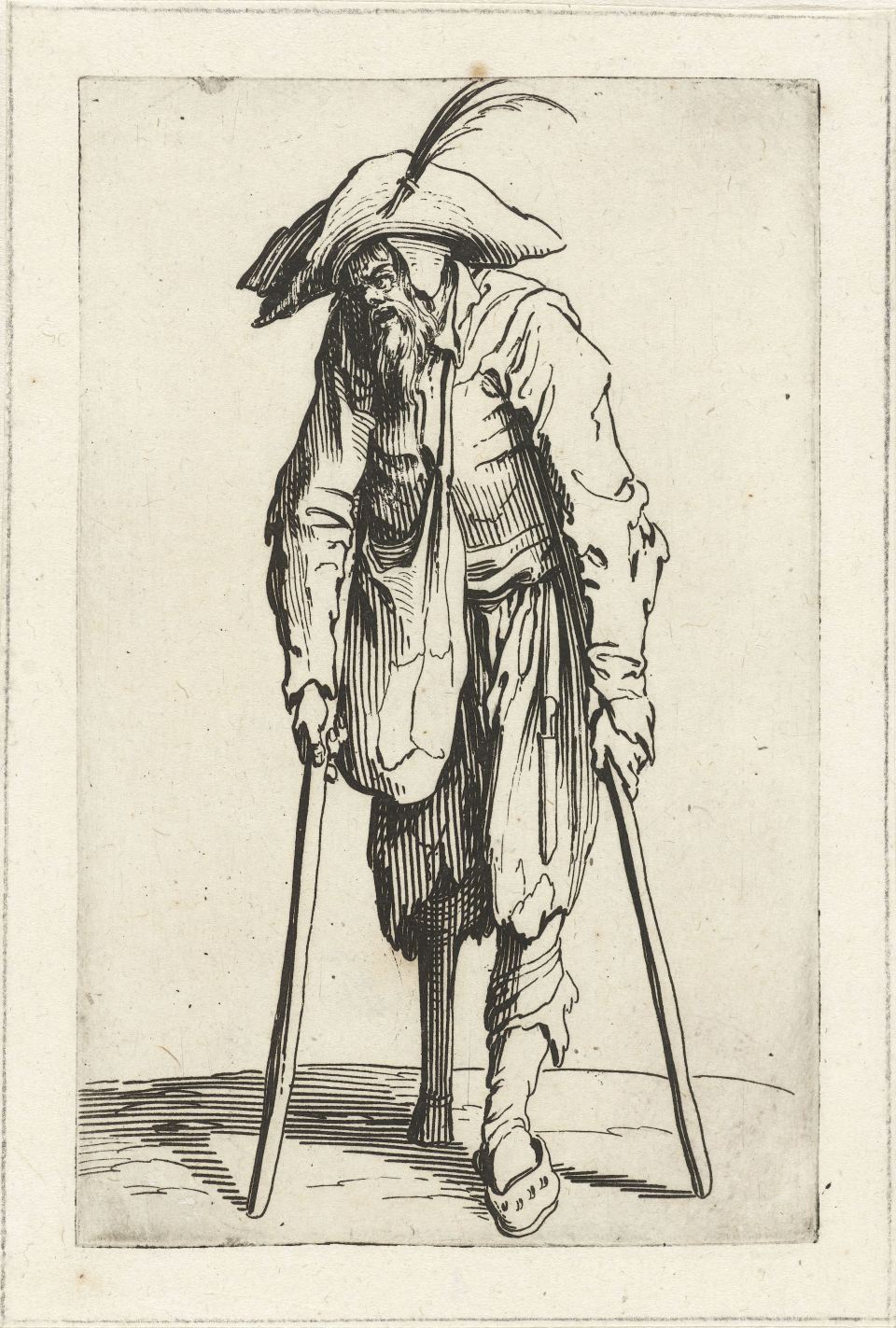
Probably the most iconic image of a beggar of the seventeenth century. Jacques Callot, 1622 – 1623. (Rijksmuseum.)

Beggar with child by Pieter Jansz Quast, 1634 – 1638. The man is using a common form of wooden leg when the lower leg was intact or was longer than a few inches below the knee. (Rijksmuseum.)

Beggar with a cripple leg, using a wooden leg and two crutches. Jan Georg van Vliet, 1632. (Rijksmuseum.)

A disabled man begging. He has a wooden right leg and a crippled left leg. Pieter Langendijk, after Pieter Barbiers (I), 1727 – 1756. (Rijksmuseum.)

Late eighteenth century beggar, clearly a former soldier, with two wooden legs. A. Smit after Pieter Barbiers. (Rijksmusuem.)

“A Sketch of a beggar from the life, 1770” by Mrs. Mary Hartley. Note the use of a single walking stick, rather than a crutch or two. (British Museum.)

Le Vendeur de Souliers. Not all those who lost a leg could afford a wooden one. This street shoe seller has improvised a means to support his handicapped leg. Jacob Gole, circa 1670 to 1724. Rijksmuseum.

“The Greenwich Pensioner” by Charles Dibdin, late 18th century. Many of our modern ideas of wooden legs on mariners descend from a series of images, many of them caricatures, of this era. (National Maritime Museum.)
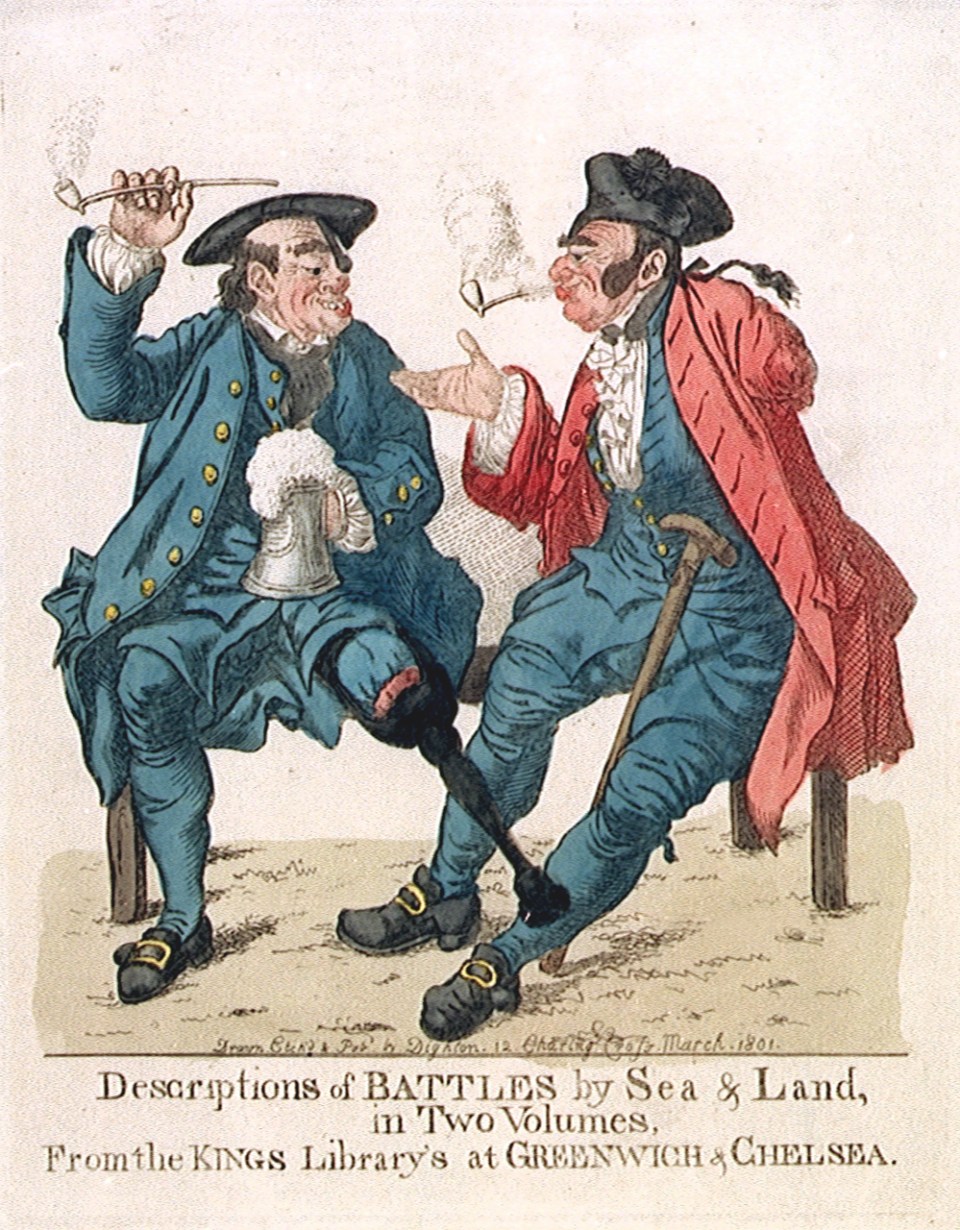
Caricature of two pensioners, one a former seaman (Greenwich pensioner), the other a former soldier (Chelsea pensioner). Land service was probably as likely to result in limb loss as naval service. Robert Dighton, 1801. (National Maritime Museum.)

Caricature of two Greenwich pensioners. Note the prosthesis on the left individual. John Thurston circa 1800. (National Maritime Museum.)
I’ll close with a few images of Hollywood wooden-leg or one-leg pirates, thanks (Thanks, Antón!) to a suggestion by Antón Viejo.

Robert Newton in Disney’s Treasure Island (1950). Newton is perhaps the most iconic Hollywood pirate with one leg, not to the classic modern caricature of the pirate, accent included.
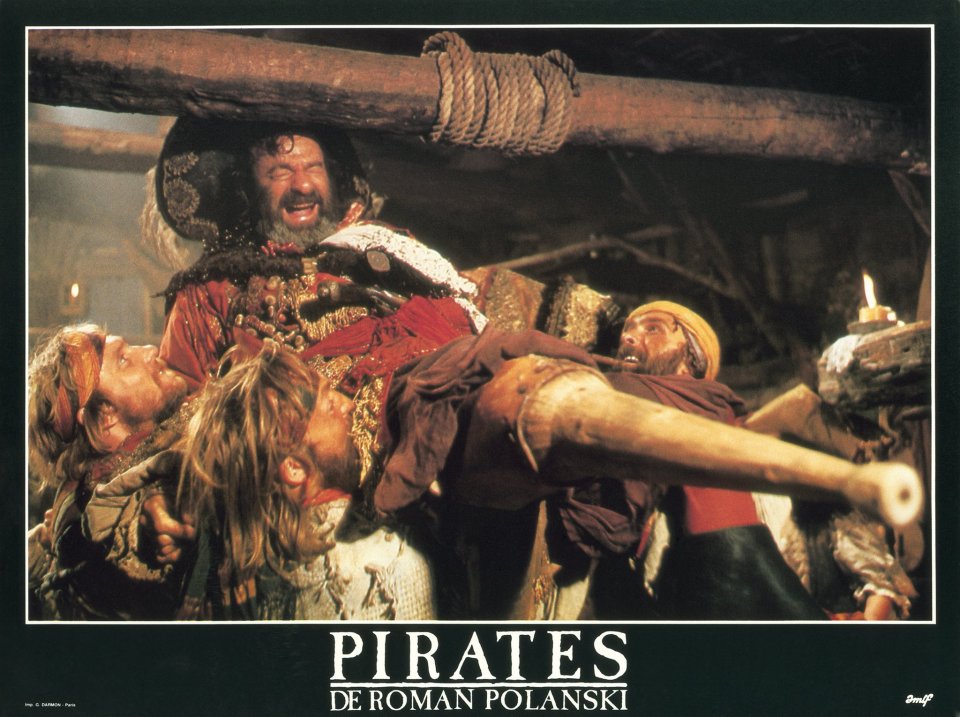
Walter Matthau as Captain Red in Pirates! (Cannon Film Distributing, 1986). A film and performance often disliked by film critics (Roger Ebert gave it one star), but I find both oddly endearing, perhaps due to the excellent film sets, and because I know a couple of men exactly like Captain Red, one of whom is my brother (who actually hates Matthau’s performance, probably because it’s too close to home). (Thanks for the image, Antón!)

Charlton Heston in Treasure Island (Turner Pictures, 1990). The film is arguably the best of all the various versions.

Geoffrey Rush as Captain Barbossa in Disney’s Pirates of the Caribbean: Dead Men Tell No Tales (2017), with crutch.

Barbossa’s peg leg, including hollowed wooden leg for use as a flask. Image from The Prop Store’s auction (sale price £4000 as I recall).

Luke Arnold as Long John Silver in Black Sails (STARZ). His “peg leg” is iron. Although I was the show’s historical consultant, I had virtually no input into costumes and accessories.
Copyright Benerson Little 2017-2019. Created 4 December 2017. Last updated January 25, 2023.
Gunpowder Spots: Pirates & “Tattoos”

Tatoos or “gunpowder spots” on the arms of seamen from Taranto, Italy, in 1778. Note that one of the tattoos is of a chain around the wrist. Also around the wrist is a Turk’s head, probably of marline. Many tall ship sailors wear Turk’s heads on their wrists today. From “Figures imprimées sur les bras de nos matelots,” part of a series of images entitled “Voyage en Italie, en Sicile et à Malte – 1778” by Louis Ducros. Rijksmuseum.
It’s a simple question: Did pirates have tattoos? And the answer is simple, too–and complex as well.
Evidence for the simple positive answer is easy: buccaneer-surgeon Lionel Wafer, writing probably of the 1680s, noted that “One of my Companions desired me once to get out of his Cheek one of these imprinted Pictures, which was made by the Negroes, his Name was Bullman; which I could not effectually do, after much scarifying and fetching off a great part of Skin.” (Lionel Wafer, in A New Voyage & Description of the Isthmus of America. Oxford: Hackluyt Society, 1934, page 83.)
What Wafer was trying to do was surgically remove a “gunpowder spot,” as tattoos were then known in English. The term came into use via the process: prick holes in the skin and rub finely crushed gunpowder in to make a permanent mark. A simple enough process, not much different than that used by professionals today, and pretty close to those who use a homemade process (not recommended, of course).
So, without further analysis or discussion, we know that at least one late seventeenth century buccaneer was tattooed. What we do not know is whether such gunpowder spots were considered part of sea roving or maritime culture. In other words, did pirates or other seafarers view tattoos as identifying marks of their trade?

Typical example of a cliché’d “Hollywood” pirate with tattoos. Illustration by Howard McCormick. Author’s Collection. The image is discussed in further detail in this post: Jack Sparrow, Perhaps? The Origin of an Early “Hollywood” Pirate, Plus the Authentic Image of a Real Buccaneer.
We also know that at least some other seamen of the era were well-inked: one “saylor” in 1720 Virginia had “on one hand S. P. in blew Letters and on the other hand blew Spots, and upon one arm our Savior upon the Cross, and on the other Adam and Eve, all Suppos’d to be done in Gun powder.” (The American Mercury, 17 March 1720, no. 13.)
Others are known as well, close enough to our period (circa 1655 to 1725) to be relevant. My thanks to maritime historian David Fictum, preeminent student of English maritime clothing in this period (you can look him up on Facebook), for providing me with these two instances:
From The Virginia Gazette, September 22 – 29, 1738: “RAN away from the Subscriber, in Caroline County on the 27th of August last, a Convict Servant Man, named John Coleman, alias, John Nabb…[he] has these 3 Letters on one of his Hands, I c M, but cannot be certain they stand thus; and has on one of his Arms, the Picture of our Saviour on the Cross…[He] has been a Sailor.”
And from The American Weekly Mercury, June 24 – July 1, 1736: “RAN-away from Patrick Creagh and William Medcalf, of the City of Annapolis in Maryland, on the 17th of May 1736 Three Servant Men, Viz. John Thomas, belonging to the said Creagh. He is a Ship-Carpenter or Caulker by Trade…I think he was mark’d on one of his Arms with some Letters & the resemblance of our Savoir, and on the other with Adam & Eve.”
Buccaneer, naval captain, privateer, world explorer, naturalist, and author William Dampier wrote of European tattooing while describing the manner of tattooing at Meangis, Indonesia during his circumnavigation of the world after a South Sea buccaneering voyage:
“By the Account he [Prince Jeoly] gave me of the manner of doing it, I understood that the Painting was done in the fame manner, as the Jerusalem-Cross is made in Mens Arms, by pricking the Skin, and rubbing in a Pigment. But whereas [gun] Powder is used in making the Jerusalem-Cross, they at Meangis use the Gum of a Tree beaten to Powder…” (William Dampier, A New Voyage Round the World, volume 1:514. London: James Knapton, 1699.)

“Prince Giolo” (Jeoly) of Meangis, the “Painted Prince,” as an adult. British Museum.
Dampier’s description of the Jerusalem cross alludes to Christian pilgrims whose tattoos often served to ensure Christian burial in foreign lands, as well to create a permanent “souvenir” or proof of pilgrimage. Constantin-François Volney in the late eighteenth century described these pilgrims and their journeys to and from Jerusalem:
“Easter over, each returns to his own country, proud of being able to rival the Mahometan in the title of Pilgrim, nay, many of them, in order to distinguish themselves as such, imprint on their hands, wrists, or arms, figures of the cross, or spear, with the cypher of Jesus and Mary. This painful, and sometimes dangerous, operation is performed with needles, and the perforations filled with gunpowder, or powder of antimony, and is never to be effaced. The Mahometans have the fame practice, which is also to be found among the Indians, and other savages, as it was likewise among several ancient nations with whom it had a connection with religion which it still retains wherever it prevails.” (From Travels through Syria and Egypt, in the years 1783, 1784, and 1785 by Constantin-François Volney. London: G. G. J. and J. Robinson, 1787, pages 311-312.)
This practice had apparently been around for centuries prior, and was probably picked up in the Middle East. It is quite likely that Christian seamen in the Mediterranean often had religious tattoos, if only to identify themselves as Christian in case of drowning or other death during their travels. More on this in a moment.
Pirates, mariners, and marooners who had lived among Native Americans were sometimes inked, and Native American and African mariners were probably often inked. Those who hailed from certain lands in the Mediterranean or in the East beyond were likewise probably often inked as well.
Lionel Wafer, while recovering among the Darien (Cuna) after burning himself severely when drying gunpowder, noted that “I went naked as the Salvages [sic], and was painted by their Women; but I would not suffer them to prick my Skin, to rub the Paint in, as they use to do, but only to lay it on in little Specks.” He described the process further: “But finer figures, especially by their greatest artists, are imprinted deeper, after this manner. They first with the Brush and Colour make a rough Draught of the Figure they design; then they prick all over with a sharp Thorn till the Blood gushes out; then they rub the place with their Hands, first dipp’d in the Colour they design; and the Picture so made is indelible. But scarce one in forty of them is painted this way.” (Wafer, op cit, pages 22 and 83.)
Two French seamen, one from Brittany, the other from La Rochelle, who had been members of the sieur de La Salle’s failed Texas colony, survived by living among a Native American tribe. In 1687 both men had “[T]heir Faces and Bodies with Figures wrought on them, like the rest [of the people they were living with].” In the same year a Spanish boy from Mexico, who had escaped on the Gulf Coast with other Spanish prisoners captured by buccaneers at Apalache, Florida, survived likewise by living with a Native American tribe. The boy, when found by Spanish Capitáns de Mar y Guerra Don Martín de Rivas and Don Pedro de Yriarte who were looking for La Salle’s colony, had tattoos like those of the people among whom he was living. (See Henri Joutel, The Last Voyage Perform’d by La Salle. London: A. Bell et al, 1714, page 173. And Enríquez Barroto, “The Enríquez Barroto Diary,” in Weddle, La Salle, the Mississippi, and the Gulf, 1987, page 180 &c.)
The evidence of Bullman above and other records as well indicate that at least some Africans were also tattooed, although most historians studying the subject note that scarification and similar processes were more common among Africans than tattooing. There were sea rovers of African origin in the Caribbean.
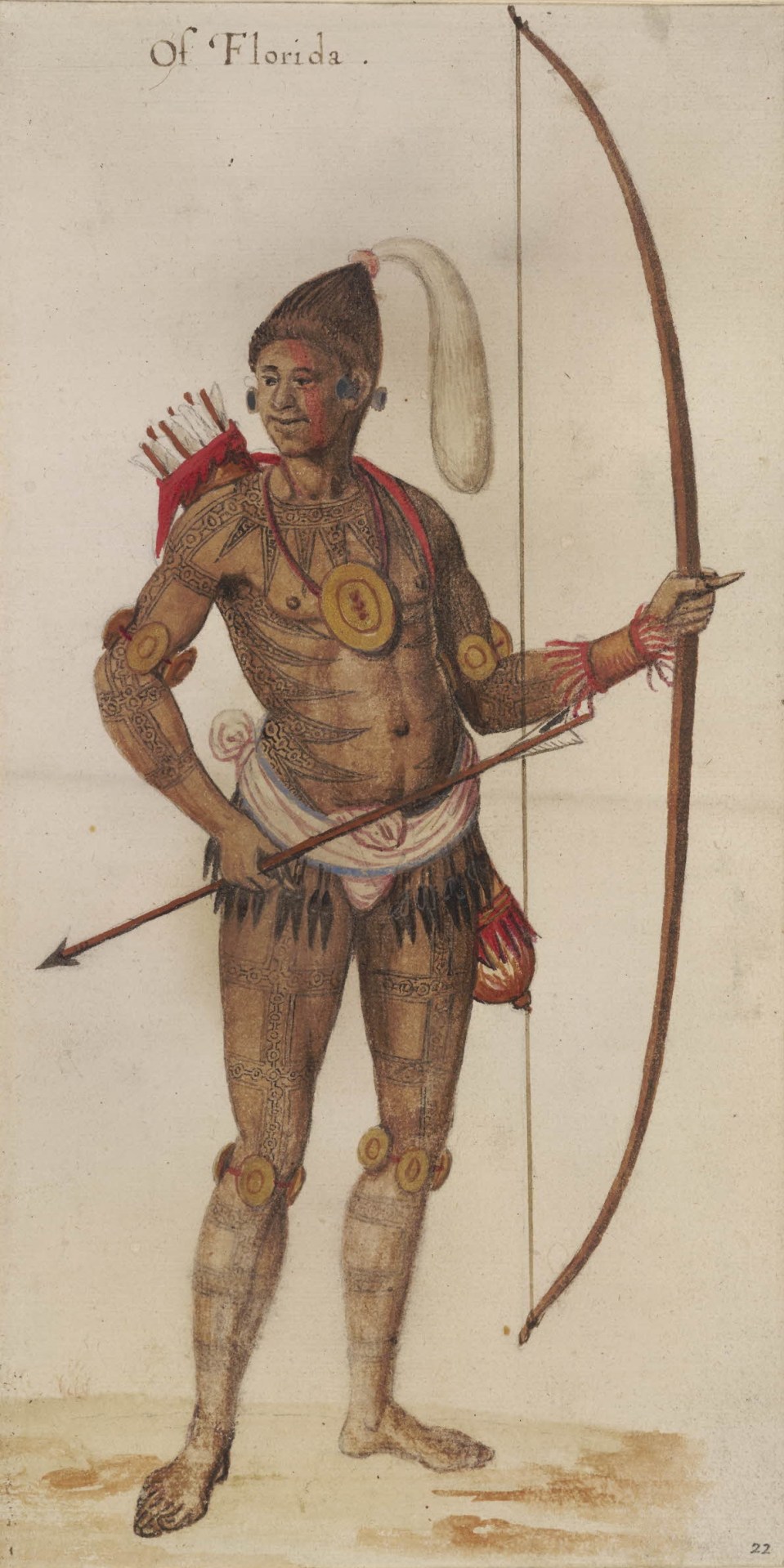
Late sixteenth century watercolor of a Timucuan casique of Florida, by John White. Note the extensive “tattooing,” common among many Native American peoples. British Museum.
There is a general consensus among some researchers that the tattoo has long been a part of maritime culture, while others are hesitant to make this argument. Certainly it was a distinct part of maritime culture in the nineteenth and twentieth centuries, and is today as well, although possibly to a somewhat lesser extent. In 1900, US Navy surgeon A. Farenholt discussed the number and variety of tattoos of seamen aboard the USS Independence, and made some observations on tattooing in the navy in general. He estimated that roughly sixty percent of enlisted sailors had tattoos, with roughly one quarter of seamen in their first enlistment having them, and roughly half in their second enlistment having them. He noted that the forearm was the most popular location for tattooing among the Independence sailors, and the penis the least, with only seven instances of the latter. For readers who thought that penis tattooing was a modern curiosity, please be advised that there is not much that is really new. (See A. Farenhold, “Tattooing in the Navy, as Shown by the Records of the U.S.S. Independence.” United States Medical Bulletin, vol. 2, no. 1 (January 1900): 37–39.)
N.B. David Fictum, noted above, recommends Ira Dye, “The Tattoos of Early American Seafarers, 1796-1818,” in Proceedings of the American Philosophical Society 133, no. 4 (1989), as an excellent source that helps put tattooing and seafarers in context.
In my most recent book, The Golden Age of Piracy: The Truth Behind Pirate Myths, I wrote the following, based on current general understanding, at least among a number of authorities published in English: “But the tattoo as a definite part of maritime culture probably did not exist until seamen began visiting Polynesia in the late eighteenth century.”
However, the images by Louis Ducros at the top of the page and just below clearly belie this. It may be that in the English navy and merchant marine, and in the American as well, tattoos did not become popular, in particular as an identifying mark or rite of passage, until after voyages to Polynesia became more regular (and from here we have the word “tattoo”), but clearly this was not the case among seamen of other nationalities, at least of those from Taranto. And this may not have been the case among English and American seafarers either. Further, it is entirely possible, even probable, that the degree tattooing was purely cultural–and culture changes over time. For example a Ducros watercolor of several Maltese seamen shows no tattoos on their arms, although it’s possible he simply chose not to depict them.
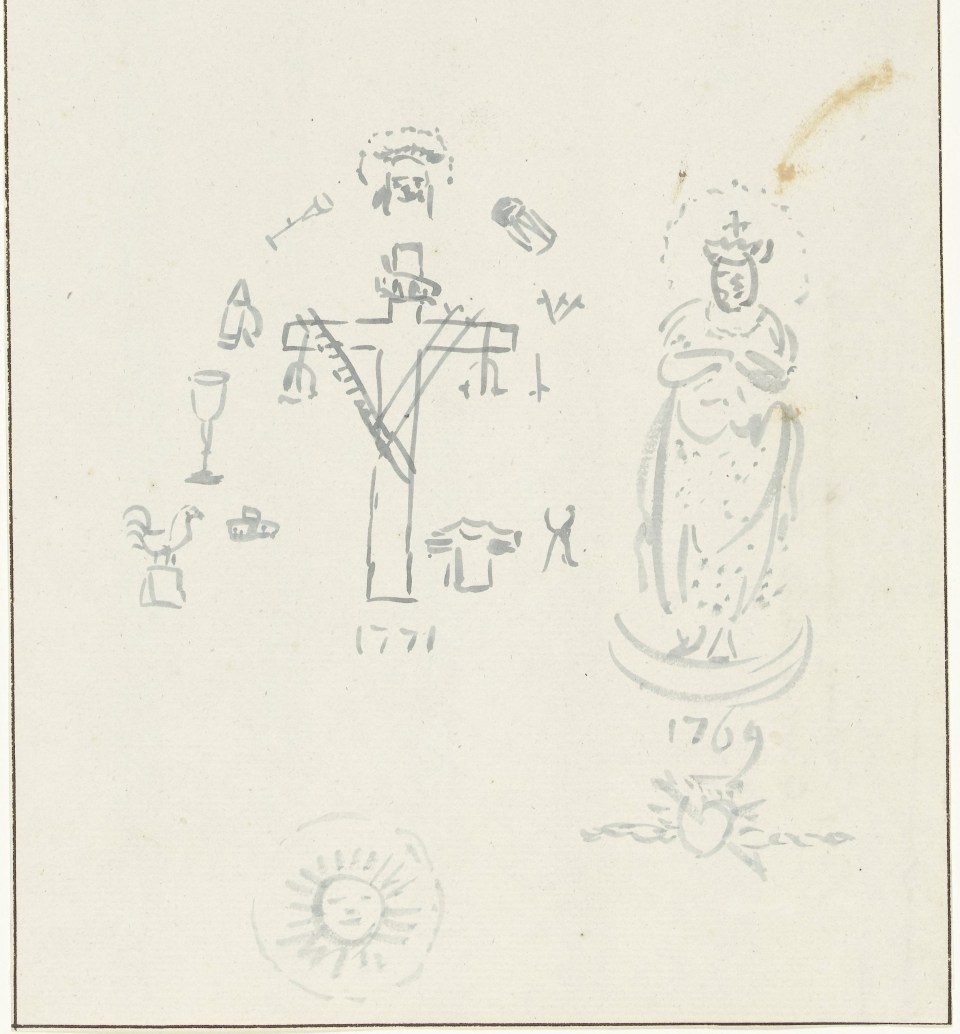
The rest of Louis Ducros’s image, reversed for proper orientation, of tattoos on the arms of seamen from Taranto,
In the image at the top of the page we see the tattooed arm of an Italian seaman from Taranto in 1778. Tattoos belonging to other seamen are also shown, and also immediately above, with some dating to the 1760s, clearly before the British voyages to Polynesia. As one might expect, the tattoos are a variety, with Roman Catholic religious imagery quite prevalent. There is also a small vessel, possibly a tartana or “tarteen” under oars, a couple of suns, a possible set of arms, a chain around the wrist, and a Jerusalem cross.
Adding to the difficulty in answering the question of tattoos among seafarers of the period is the fact that people other than seafarers had “gunpowder spots” in the late seventeenth and early eighteenth centuries, ranging from the lubberly working class to upper class ladies–yes, ladies–and gentlemen.
Among working class examples, David Willson, a deserter from the British army in 1715, was described as having his initials “D. W.” in gunpowder on his right hand. We don’t whether he came by his gunpowder spot while serving in the army, or prior to service, or afterward. (London Gazette, 10 September to 17 September 1715, no. 5363.)
Among “ladies and gentlemen,” Thomas Otway’s Beau in act 4 of The Soldiers Fortune (1681) catalogs the “Age, Shape, Proportion, colour of Hair and Eyes, degrees of Complexion, Gun-powder Spots and Moles” of the “choicest Beauties about Town.”
Aphra Behn, famous poet, playwright, and novelist, writes of “a Blew spot made in a Ladys neck, by Gunpowder…” The poem was published in Lycidus or the Lover in Fashion (London: Joseph Knight, Saunders Francis, 1688), and was attributed to “a Person of Quality.”

Satirical image of a lady with various removable patches or spots. “Gunpowder spots” were substituted at times as permanent patches. Some gentlemen wore patches and had gunpowder spots too. From “An Appendix of the Pedigree of the English Gallant” in Anthropometamorphosis: Man Transform’d: Or, the Artificiall Changling by John Bulwer. London: William Hunt, 1653.
I note as an aside that one scholar has asserted that “gunpowder spots,” including the one described by Aphra Behn, were associated with seventeenth century English gun culture. I think this is a rather misplaced notion, except in that the origin of tattooing with gunpowder may have derived from the knowledge that un-burned corns of powder will occasionally embed themselves violently in the skin, leaving a permanent mark. (One pirate re-enactor, who has since passed away, I met on the set of True Caribbean Pirates had a tattooed palm–small blue-black dots everywhere–resulting from the premature ignition of a gun cartridge during loading.)
The other remote connection to gun culture is common poetic allusion or comparison–an obvious poetic convenience, in other words. The ultimate origin of “gunpowder spots” is not firearms, but body marking: gunpowder simply worked well to make a permanent stain and was readily available. Beauty marks on men and women of the era did not imply an association with firearms, and to argue this is to stretch beyond the facts, not at all uncommon today in both common popular discourse and academia. Even Aphra Behn in her poem acknowledges that the tattoo really has nothing to do with firearms except as a convenient poetic comparison:
Powder, which first was for destruction meant,
Was here converted into ornament;
But yet retains its wonted nature still,
And from your neck, as from a Port do’s kill.
Similarly, William Wycherley in his poem “Upon the Gun-powder Spot on a Lady’s Hand” published in 1704:
Thy Gun-Powder, on thy Hand, shot
Me dead, half-dead with Love before;
Kill’d me, both on, and by the Spot,
Thy cruel White Hand on it wore:
Seventeenth-century surgeon Richard Wiseman had experience with gunpowder spots of two sorts: “Only if they be burnt with Gun-powder or any other way, their Cure is much alike, they onely differing secundam magis and minus. Onely if they be burnt with Gun-powder, they must pick out the Powder first; else they will carry the same blew Mark, if it be in their Faces, which some people use to do in their Hands and Arms, which I have often been imployed to take out, when done wantonly in their Youth; but could never remove them otherwise then by taking off the Skin.” (Richard Wiseman in Several Chirurgicall Treatises. London: E. Flesher and J. Macock, for R. Royston, 1676, page 440.)
Clearly not everyone, ranging from a buccaneer to others, wanted to keep their tattoos forever.

We come again, and importantly, to playwright and poet William Wycherley who wrote The Plain-Dealer (for what it’s worth, my favorite play), first performed in 1674:
“[O]r was it the Gunpowder spot on his hand, or the Jewel in his ear, that purchas’d your heart?” sneers the manly Captain Manley (act. 2, sc. 1) to his former inamorata in regard to an obnoxious fop (they’re all obnoxious, aren’t they?) seeking her hand. At first glance it seems that Manley might be sarcastically referring to the lack of a gunpowder spot on the fop’s hand, and therefore that such spots were indicative of the seaman and therefore of the adventurer. Captain Manley, after all, was a fighting seaman. (Regarding the “Jewel in his ear” see Pirates & Earrings.)
John Dickson Carr, novelist and historian, would seem to have agreed with my initial assessment of the gun-powder spot on the hand being a sign of the seaman: he writes in his novel Devil in Velvet, “as much the mark of the seaman as the gunpowder spot on his hand…,” almost certainly inspired by Wycherley in The Plain-Dealer. The depth of Carr’s non-fiction research ability is attested to by his nonfiction The Murder of Sir Edmund Godfrey. However, we were both assuredly in error: Professor Ted Cotton, retired Professor Emeritus of English Literature from Loyola University in New Orleans, not to mention old friend and fellow swordsman, in conversation with me some years ago suggested the lines refer merely to the earring and gunpowder spot as being fashions of idle foppish gentlemen. Add to this the evidence of ladies and gentlemen with gunpowder spots, and it is certain to me now that the lines in The Plain-Dealer refer to a gentleman, not a seaman.
Of course, none of this goes to prove or disprove whether late seventeenth to early eighteenth century seamen associated with the Golden Age of Piracy–English, French, Dutch, Spanish, Africans, Native Americans, various mixed races of various nationalities, and in smaller numbers Portuguese, Corsicans, Levanters, Italians, Danes, Germans, various other Europeans, even a few Asians–specifically associated tattoos with their maritime culture, much less did pirates and other sea rovers, a subset of the former, do so.
It remains possible that some Western European mariners, including sea rovers, considered “gunpowder spots” as part of their tradition, but there is no conclusive evidence for this for the period in question. Certainly it is true today: for example, Navy seamen and tall ship sailors often get tattoos and consider this to be traditional, even as do members of some other groups, military and non-military, as do some “downright individuals.” Permanent body decorating has been around for a very long time among the majority of cultures past and present.
So, best guess for the Golden Age of Piracy? Although some sea rovers of the era had tattoos, tattooing–and it would not be known by this name for roughly another century–was not yet a practice of group identity among them or of other mariners broadly associated with this era. Of course, I could be wrong: we need more evidence than what we have so far. But the evidence of Dampier, Wafer, and Wycherley strongly suggests that tattoos or gunpowder spots were not yet a distinct part of Western European maritime culture, except possibly among some of the regional maritime sub-cultures.
And before anyone asks or suggests this: no, I don’t think it likely that early eighteenth century pirates had skull and bones tattoos!
Post Script: This blog post is dedicated to my younger daughter, Bree, a tall ship sailor in her spare time and who, when I originally wrote this, “will soon have a tattoo…” and now has for several years: “second [star] to the right” — two large stars, and two smaller ones for her new siblings!
Copyright Benerson Little 2017-2023. Last updated September 13, 2023.
Did Pirates Wear Eye Patches?

Costume illustration of an eye-patched, peg-legged seaman by Paul Gavarni for the Carnival in Paris. The popular image–trope, if you prefer–of the disabled seaman had been in place for more than a half a century by now, if not longer, in both Britain and France. This image was created between 1838 and 1843. British Museum.
So, “Did pirates wear eye patches?”
The short answer: Only if they had lost eyes to disease or injury, and this was no more prevalent among pirates than among fighting seamen and soldiers. In other words, the eye patch is in no way a sign or symbol of the pirate per se, nor even of the seaman in general.
Still, the question is a good one, if only to give us a reason to dig into related history.
The Mythbusters television show and other speculators have recently added to the myth by working backward from the proposition, that is, “If pirates wore eye patches, why would they have worn them?” rather than looking first at primary sources to see if there is any evidence that pirates wore them at all. There isn’t, other than as noted below.
The associated suggestions that pirates may have worn eye patches to improve night vision or daylight lookout observations or to enable them to fight below decks isn’t supported by any primary source material. In fact, the loss of sight in an eye, even by wearing an eye patch, causes significant loss in both depth perception and visual breadth, making movement aboard a vessel, aloft especially, very dangerous. It would also make visual observation by a lookout much more difficult.
As for fighting below decks, pirates and other seamen didn’t really do much of it: it was much easier to flush crew below decks by tossing grenades and firepots into breaches chopped into decks and bulkheads with boarding axes. In other words, the mere idea that eye patches might have been used to aid in fighting below decks shows a clear lack of understanding of the subject.
In other words: There is no historical evidence at all for any of these purported reasons why a pirate might have worn eye patches! Mythbusters and other popular “documentaries” are entertainment, not serious history. This includes “The History Channel,” now known I think as History.com: it’s “docu-tainment,” not real history. Trust me on this: if you’re being interviewed as an expert for a TV “documentary” and produce too many facts against the episode’s premise, the producers won’t put you on screen!
Again, let me emphasize: if a pirate wore an eye patch it was because he had lost an eye or was disfigured in his eye, and for no other reason!
The origin of the modern myth that pirates wore eye patches is largely literary. However, its roots lay deep in reality, both in the fact that eyes were often lost to disease and battle trauma, and that a one-eyed person often looks fearsome or sinister. The latter sense goes back millennia, and probably farther. Homer’s Cyclops, Polyphemus, is an early instance.

Polyphemus by Jan de Bisschop, after Daniele da Volterra, after Michelangelo, after Pellegrino Tibaldi, 1671. Odysseus, aka Ulysses by the Romans, blinded him. British Museum.
Some versions of Bernal Diaz’s The Discovery and Conquest of Mexico describe the fierce old musketeer Heredia, sent to frighten Native Americans, as a one-eyed, one-legged (or game-legged) soldier. The same work describes how Cortez’s enemy, Narvaez, lost an eye in battle.

A British army pensioner with eye patch and wooden leg. Again, the image was not restricted to naval seamen, much less, and popularly, pirates. By Isaac Robert Cruikshank, late eighteenth or early to mid-nineteenth century. British Museum.
Among seafaring journals and other records of the Golden Age of Piracy, there is only occasional mention of one-eyed seamen, usually in lists of those wounded in battle. Exquemelin’s various editions of The Buccaneers of America famously list compensation for the wounded, including the loss of an eye, and it is here that the primary source of the myth of pirates and eye patches is probably to be found, in combination with other works such as Bernal Diaz’s. The loss of an eye in battle was fairly common, in fact: seafarer Edward Coxere describes the use of oakum and tallow to stuff an eye socket in order to heal the wound, for example. Notably, none of the several eyewitness images of buccaneers or flibustiers from the 1680s show any with any of the usual Hollywood characteristics: wooden legs, eye patches, parrots, hooks, &c. This is to be expected. The large number of images of seamen, usually naval, with eye patches dates to a century later.


Images of splinters produced by round shot during an accurate test of the damage done in action. Author’s photos taken at the Erie Maritime Museum.
As a friend, “Tweeds Blues,” pointed out recently, it seemingly would not be surprising to find a fair number of one-eyed naval, privateer, and pirate seamen, given the damage done by splinters in action. Here I feel the need to point out yet again that Mythbusters is entertainment: one episode even suggested that splinters didn’t cause much damage in a naval action. In fact they did: there are hundreds, if not thousands, of accounts of the damage done, not to mention at least one accurate test that proves the horrible extent of damage splinters can do. The Mythbusters test parameters were simply incorrect, not to mention that overwhelming historical evidence was largely ignored, as were previous–and more accurate, historically correct–tests. The images above show splinters resulting from round shot striking a correctly-built hull section. The test was conducted by the Maritime Museum in Erie, Pennsylvania, home of the Flagship Niagara.

Admiral Don Blas de Lezo y Olavarrieta. Blas de Lezo is best-known for successfully defending Cartagena de Indias against British attack in 1741. Injuries received during his naval career included the loss of an eye, his left hand, his left leg below the knee, and the laming of his right arm. Museo Naval, Madrid.

Joseph Burgin, a Greenwich pensioner, who lost and eye and a leg in action in the Royal Navy in the early eighteenth century. National Maritime Museum, Greenwich.
Of course, the most famous example of a naval mariner with an eye patch is that of Lord Admiral Horatio Nelson, who lost the sight in one eye during the capture of Calvi on Corsica in 1793–except that did not actually wear an eye patch. This has not stopped the popular assumption that he did from becoming prevalent, and, although out of our period, this has still influenced the idea of the one-eyed mariner, and therefore one-eyed pirate. Admiral Nelson also lost an arm.

“Portret van Johann Karl von Thüngen,” the German field marshal. Period images of him show this eye patch worn without a thong, string, or other tie. Anonymous, 1675 – 1711. Rijksmuseum.
The fact is, patches were commonly used to cover any facial disfigurement. In the seventeenth century diarist and navy secretary Samuel Pepys wore a black patch, or possibly a large beauty patch, to cover a large cold sore. Similarly, King William III advised a soldier to remove the black patch covering the scar on his face because “It’s more honourable in a Soldier to wear a Scar than a Patch.” (For the latter reference, see Coke in the sources listed below.)

Scottish soldier Sir William Brog, 1635, with a patch covering a scar on his nose. (And an earring too.) Pring by Crispijn van Queborn. British Museum.

Eye patches, stumps aloft and ‘alow, not to mention peg legs. “Plumpers for Sr Judas, or the Chealsea Pensioners Revenge,” a satirical print, 1784. British Museum.
By the late eighteenth century the image of the eye-patched, peg-legged seaman was iconic, probably the result of the increased number of British naval actions brought on by the American Revolution and, especially, the Napoleonic Wars. Notably, in reality most such disabled seamen were pensioned from service, as shown above. These satirical images are probably the material origin of the popular identification of the naval seaman, and therefore the pirate, with eye patches.
Even with its legitimate historical roots in fact, this pirate myth, like many, didn’t come fully into being until the mid-nineteenth century, a hundred or more years after the Golden Age of Piracy. Sir Walter Scott in The Fortunes of Nigel describes “The noble Captain Colepepper, or Peppercull, for he was known by both these names, and some others besides, had a martial and a swashing exterior, which, on the present occasion, was rendered yet more peculiar, by a patch covering his left eye and a part of the cheek. The sleeves of his thickset velvet jerkin were polished and shone with grease, — his buff gloves had huge tops, which reached almost to the elbow; his sword-belt of the same materials extended its breadth from his haunchbone to his small ribs, and supported on the one side his large black-hilted back-sword, on the other a dagger of like proportions.” Here is the epitome of the swashbuckler, easily translated to the pirate.
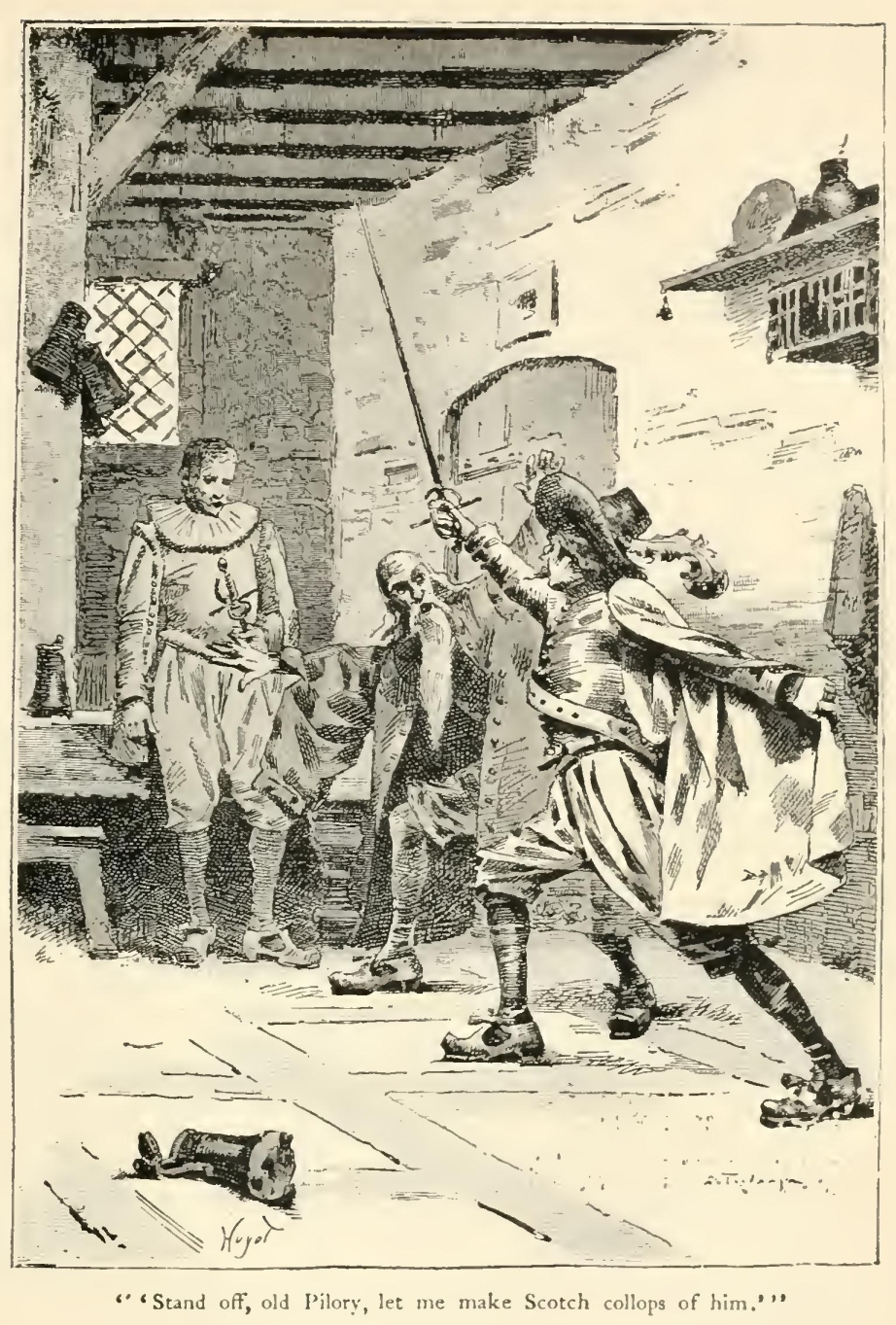
The bold and swaggering Captain Colepepper, from The Fortunes of Nigel by Sir Walter Scott. Nineteenth century, unknown edition.
Not long after, Charles Dickens described a pirate with “the one eye and the patch across the nose” and soon afterward similarly did many writers of popular fiction. However, many of our principle originators or propagators of pirate myths—Robert Louis Stevenson, J. M. Barrie, N. C. Wyeth, for example—do not appear to have bothered with this myth, although Barrie’s Captain Hook probably did encourage other images of pirates missing a vital part such as a limb or eye, and Howard Pyle in The Ruby of Kishmoor equips a pirate, one of the four in the short tale, with an eye patch.
In 1926 Douglas Fairbanks propagated nineteenth century pirate myths, as well as a few he helped create, across the world with his film The Black Pirate. In it he established the modern pirate swashbuckler stereotype, based much on Howard Pyle’s Book of Pirates, Peter Pan, and probably Captain Blood (one of whose characters, by the way, was one-eyed, although he lost the eye at Sedgemoor, not at sea). Around the same time, we begin to see pirate book cover art and other illustrations showing pirates with eye patches. But it would take later films, such as The Black Swan and The Crimson Pirate to make the eye patch an obvious, routine part of the stereotypical pirate costume.

Publicity still from The Black Swan, 1942. An eye-patched Anthony Quinn is on the right.
Sources
Roger Coke. A Detection of the Court and State of England. 4th ed. London: J. Brotherton and W. Meadows, 1719. Vol. 2:472.
Bernal Díaz del Castillo. Historia Verdadera de la Conquista de la Nueva España. Reprint, Madrid: Don Benito Cano, 1795. See vol. 1:213.
Edward Coxere. Adventures by Sea of Edward Coxere. Edited by E. H. W. Meyerstein. London: Oxford University, 1946.
Charles Dickens. “The Perils of Certain English Prisoners.” 1857. Reprinted in Charles Dickens’s Stories from the Christmas Numbers. New York: MacMillan, 1896. Page 144.
Alexandre Exquemelin [John Esquemeling]. The Buccaneers of America. London: Crooke, 1684. Reprint, New York: Dorset Press, 1987. Page 60.
Benerson Little. The Golden Age of Piracy: The Truth Behind Pirate Myths. New York: Skyhorse Publishing, 2016. Prologue.
——. “El Mito Pirata” in Desperta Ferro 17 (August 2015), 52-55.
Heidi Mitchell. “Does Reading in Dim Light Hurt Your Eyes?” Wall Street Journal online, April 8, 2013, http://www.wsj.com.
Mythbusters, Episode 71.
Samuel Pepys. Diary. September 26, 1664.
Walter Scott. The Fortunes of Nigel. Boston: Samuel H. Parker, 1822. Page 255.
The Telegraph. “Nelson didn’t wear eye-patch, says historian.” January 19, 2005.
Copyright Benerson Little, 2017. Last updated February 2, 2023.
Pirates & Earrings

A Dutch seaman in Amsterdam dancing in celebration of the recapture of the city of Namur in September 1695. By Cornelis Dufart, 1695. Rijksmuseum.
Quite often today, reenactors, students of authentic pirate portrayals of the late seventeenth and early eighteenth centuries, aka the “Golden Age of Piracy,” and the makers of any television documentary or drama, or any film, about pirates who wants to be taken seriously will generally drop the pirate earrings and other pirate caricature, or at least minimize them. However, this practice, while avoiding “Hollywood” cliché, has one problem:
There were “Golden Age” seafarers who wore earrings.
The same goes for pirates of the “Golden Age” from circa 1655 to 1730.
As is the case with much of our perception of what is and is not correct and authentic about “pirates,” the myth or reality really applies much more broadly, to seafarers in general, and from there to the question of whether the myth or reality applies across the board to seafarers or only to a specific subset. For example, I was asked during a Reddit AMA a while back about the “crossing the line” ceremony originating from pirates. It doesn’t actually originate with sea thieves, but from mariners in general, unless all mariners were sea thieves. (Of course, some might argue that at least through the Middle Ages all seafarers were potential pirates…) Sea rovers may have practiced the various “crossing the line” ceremonies, just as seamen in general did, but it was foremost a maritime practice, not one specific to piracy. And I say various practices because there were different cultural practices, and different “lines” to cross as well.
So, put simply, were earrings a conventional part of pirate dress, or of maritime dress, in general during the period 1655 to 1730?
I’m going to keep the answer just as simple, for this is not the place to address the variety of seafarers, sea thieves, and their national and local customs and dress.
And the simple answer to both is…no.
Even so, many answers are really not so simple as they seem, and so it is with this one. There are three exceptions to the earring rule, and they apply not only to pirates and privateers, but to mariners in general.

“Matelot de Brabant / Brabantsche Schipper” by Bernard Picart, circa 1690 to circa 1733. Note the single pearl in the earring, apparently common among Dutch seamen. Rijksmuseum.
First is the Dutch exception. Earrings were common in the mid to late seventeenth century and into the eighteenth on many Dutch seafarers, as is clear by the several images I’ve posted here. The seaman in the image above wears an earring in the left ear, and the seamen in the Dufart images below mirror each other, one in the left, the other in the right. From the images it’s impossible to tell if the Dutchmen are wearing an earring on the other ear as well.
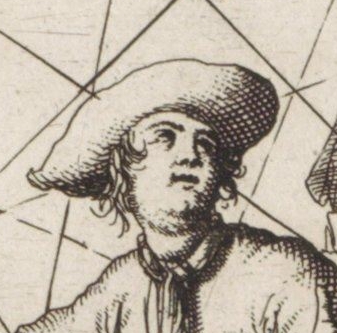
An earring or a wisp of hair? Dutch or possibly Norwegian seaman, late seventeenth century. Pas-keart van de Cust van Noorwegan by Joannes van Keulen.
So, if you want to be a sea rover and wear an earring and be historically accurate, be a Dutch pirate or privateer. That said, many serious pirate and privateer reenactors are opposed even to this out of concern that it gives the wrong impression: either in general, or because most of the early eighteenth century pirates were “Anglo-American,” or because there are only a “few” Dutch images of seafarers with earrings (although a “few” images would well suffice to support “facts” such reenactors are in favor of). For me, fact–truth–should outweigh this. First, given the large number of buccaneers or flibustiers of Dutch origin in the late seventeenth century, it would not be surprising to find earrings on some buccaneers. Second, not all of the early eighteenth century “Anglo-American” pirates were in fact British or Irish derived, and separate from them were French and Spanish pirates whose crews doubtless included some Dutch members.

Detail of a Dutch seaman in Amsterdam dancing with a woman in celebration of the recapture of the city of Namur in September 1695. By Cornelis Dufart, 1695. Rijksmuseum.

Dutch seaman with a rummer (Dutch roemer, a large drinking glass). Note the obvious earring. Jacob Gole, after Cornelis Dusart, after a fairly similar illustration lacking knife, pipe, and earring by Abraham Bloteling, 1670 – 1724. Using other artist’s and engraver’s illustrations as templates was common. Rijksmuseum.
Second is the fop exception. Through much of the seventeenth century, including the last quarter, and into the eighteenth century some French fops, and some English onesas well for they generally followed French fashion, were in the habit of wearing an earring, perhaps even one in each ear. The common assumption is that men’s earrings in England and Scotland went out of fashion after the death of Charles I, but this is not entirely the case. They became less popular, and were restricted largely to the foppish gentleman and would-be gentleman–a more restricted group of “gallants” than in the first half of the century.

“John Hardman the Famous Corncutter.” Hardman was a specialist in corns and bunions, and it is speculated, given the royal device hanging from his waistcoat, that he may have worked on King William III’s feet. Little is known about Hardman, and at least one early nineteenth century writer suggests he was Dutch given the English royal arms he is wearing (the author notes the large number of Dutchmen in London during the reign of William III), but possibly due in part as well to his mustache and earrings, and quite possibly because the author did not want to recognize an Englishman as a possible mountebank. Even so, it remains possible that Hardman was merely a flamboyant Englishman. Although the name’s roots are Germanic, it was and is a fairly common English surname. Note the long earring. British Museum.
References to earrings on men in the second half of the seventeenth century include a letter written by George Fox (of the Society of Friends, or Quakers) in 1654, but not published, I don’t believe, prior to the 1690s: “a company of them playing at bowls, or at tables, or at shuffle-board; or each taking his horse, that hath bunches of ribbons on his head, as the rider hath on his own (who, perhaps, hath a ring in his ear too)…” This isn’t too long after the execution of Charles I, when we might still see earrings (and which many secondary texts say is about the last time Englishmen wore earrings), and is at the beginning of the Golden Age of Piracy, assuming a start date of 1655 with the capture of Jamaica.

Henri de Lorraine, Count of Harcourt (1601-1666), known as “le Cadet la Perle” due to his bravery in battle. Earrings were quite common on military men in England, Scotland, and France in the first half of the seventeenth century, and on artists and others as well: a 1650 self-portrait of Rembrandt shows him wearing a pearl earring and a self-portrait of Ferdinand Bol shows him wearing a small gold hoop. Print by Nicolas de Larmessin, 1663. British Museum.

Goldsmith Louis Roupert, 1668. Print by Louis Cossin based on a painting by Pierre Rabon. Rijksmuseum.
Similarly, note the illustration below. Published in 1653 as part of an appendix satirizing the English gallant and his ostentatious dress and body ornamentation, it does prove that even at this date some English gallants still wore not only one, but two earrings at times. The author, Dr. John Bulwer, compares earring-wearing and other ostentation to that of foreign savages and heathens, or even to pre-Christian Britons, and appears to approve only of plain sober dress, as one might expect during the Age of Cromwell–up with the cropped Roundheads, down with the long-haired Royalists! “Children of vanity” is Bulwer’s disparaging, if also accurate on occasion, term for those who excessively ornament themselves. He also mocks gallants for wearing patches, starched collars (yellowed in fact with starch), flowing locks, mustaches, and so on. He is no less sparing of women. Curiously, Dr. Bulwer’s portrait shows him with flowing locks, a mustache, and goatee.

Illustration from “An Appendix of the Pedigree of the English Gallant” in Anthropometamorphosis: Man Transform’d: Or, the Artificiall Changling by John Bulwer. London: William Hunt, 1653. Dr. Bulwer’s work Anthropometamorphosis, in which he details the great variety of body ornamentation worldwide, is extraordinarily detailed for the era, sophisticated even by modern standards, even if more than a little bit patronizing. Dr. Bulwer is perhaps best known for proposing a system of sign language for the deaf.
Moving on to William Wycherly and The Plain-Dealer (one of my favorite plays), with a reference to the jewel in the ear and gunpowder spot on the hand, circa 1673, in the middle of the age of buccaneers. Originally I had considered the possibility that this might refer to the sea captain and not the fop, but other instances (George Fox above, for example), plus a re-reading, plus the opinion of a professor emeritus of seventeenth century English literature, have persuaded me that fops wore earrings more often than we think (the professor thought so, by the way)—enough to be an obvious reference for the audience. We’ll deal with gunpowder spots in another blog soon.
Head now to The Works of Mr. Thomas Brown: Amusements Serious and Comical, a comical and satirical group of works published in 1700, and we have the following: “I had honestly, deserved a better Reward than a Patch-box, a Toothpicker, and a small Ear-ring amounted to, and therefore need not disquiet my self upon that Score.. Thus you fee, Madam…” The gentleman has received several useful implements (but not what he was seeking) from his inamorata: an ear picker to clean his ears, a patch box for patches (fops wore them), and a single earring. The last might be simply a love token, but to what end if it can’t be displayed–worn, that is?
That French fops wore them is uncontested. By way of a nautical example, in 1704 the comte de Forbin, a famous, and arguably quite pompous at times, commerce-raiding French naval captain refused passage to a French monk who had been authorized travel from Livorno, Italy to France aboard the French warship by Cardinal de Janson. The monk wore a single gold earring with a large pearl, and Forbin specifically notes his foppish airs, that is, that he acted like a “petit-maître“–a fop or dandy. There were at the time a fair number of priests and monks as addicted to trappings of the flesh as to world beyond, if not more. In any case, it didn’t help that the monk was “haughty and arrogant.” In fact, it was probably this behavior that set Forbin off. But the captain’s reply to the monk was that the cardinal’s order said nothing about giving passage to a monk wearing an earring and giving the airs of a fop–so get off my ship.
In sum, if you want to be a sea rover with an earring but don’t want to be Dutch you might considering being a bit of a fop. This isn’t so very far-fetched, for their are examples of pirates wearing jewelry in a fashion that might be considered foppish. Quoting from The Golden Age of Piracy: The Truth Behind Pirate Myths, an overly fashionable pirate “might wear a ‘necklace of pearls of extraordinary size and inestimable price, with rubies of surpassing beauty’ as Captain Nicolas Van Horn did, or a gold chain with a ‘gold toothpicker hanging at it’ as Captain John James did (and many of his crew also wore gold chains), or a ‘gold chain round his neck, with a diamond cross hanging to it’ as Captain Bartholomew Roberts reportedly did.” (Citations to the quotations above can be found in the endnotes to The Golden Age of Piracy. The quotation is from the prologue.)
Even so, I do tend to agree a bit more with reenactors who object to this exception out of concern for the wrong impression. That said, I still would not be surprised to find a foppish pirate wearing an earring. Devotees of the early eighteenth century Anglo-American pirates will argue quite factually that most were seamen. This doesn’t alter the fact that there may have some foppish seamen–I’ve known some modern ones who’d fit this description, although they’re in the minority–and there were a few non-seamen as well who might fit the fop bill, including the dilettante pirate Stede Bonnet. In my experience, both in studying seamen of the past as well as having known and worked with many modern seamen–naval, commercial, tall ship–during my life, mariners as a group are not homogeneous even though they may express attributes common to their profession. In other words, they too have personalities and often express them through their clothing, hair, and other body ornamentation.

Detail from a late sixteenth century watercolor of a Timucuan casique of Florida, by John White. Note the large “earring” or ear piercing. Such ornamentation was common among Native Americans. British Museum.
The third exception is that of Native Americans, Africans, and mixed races. This should be an obvious exception, but the fact that it is so often overlooked strongly suggests an ethnocentric–that is, a “white-centric” or “Euro-centric”–bias in the view of piracy and of the maritime in general. A fair number of English, French, and Dutch pirates and privateers, although not the majority, were non-white. The majority of Spanish pirates and privateers originating in the Caribbean were non-white. Many of these seafarers of color, particularly those of full African and Native American blood, probably wore earrings in one form or another.

Painting by Mexican artist Miguel Cabrera, circa mid-eighteenth century. The man is wearing an earring. The wearing of earrings among blacks and many men of mixed races was also common in the seventeenth century as well.

An African with a sword, quite possibly a West African slave trader. Seventeenth century. Sotheby’s.

Dutch school, a Moor, possibly a West African slave trader, smoking a churchwarden pipe. Seventeenth century. Christie’s.
Many period descriptions and images of Native American males mention or show earrings. Africans, and those of African descent, in European and American context in the seventeenth century are often shown wearing earrings, typically a single one. A large number of seventeenth century Dutch paintings show black servants and slaves wearing earrings, as does a painting of black Moor in North Africa and as does one of a possible West Indian slave trader.
One final note:
Earrings were a fashion statement!
Seamen of this era, including sea rovers, did not wear them to improve eyesight, pay for a funeral, or for any other nonsensical reason, no matter how reasonable such myths may seem when un-examined or otherwise taken at face value. Unfortunately, in spite of the wealth of accurate information readily available on the Internet, it has paradoxically fostered, or perhaps enhanced is more accurate, an intellectual laziness and willingness to believe anything in print.

Dear Cornwell, “From the old fort Blood surveyed Don Miguel’s squadron…,” oil on canvas, 1930, for the magazine serial edition of Captain Blood Returns. Mort Künstler Collection.
So, digressing slightly in order to speak historically about a fictional character, would Capt. Peter Blood actually have worn a large pearl earring as Rafael Sabatini described he did in Captain Blood Returns (aka The Chronicles of Captain Blood in the UK)? Of course he would have, for he meets two criteria: he has had service in the Dutch navy under de Ruyter and is, almost, a fop in his style of dress!
Copyright Benerson Little 2017. First posted July 2017. Last updated July 9, 2019.
Keelhauling, in Living Color
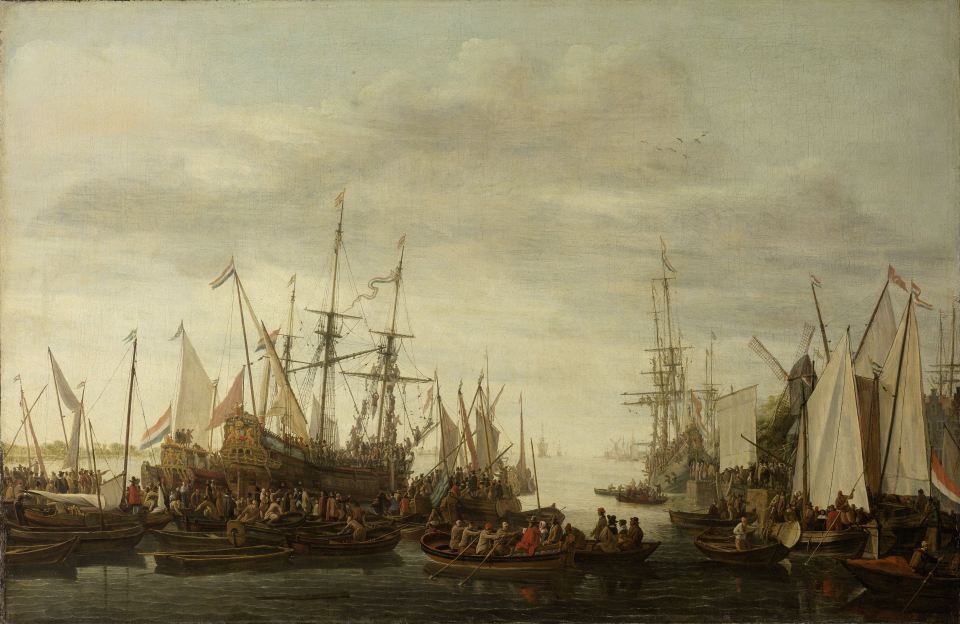
The Keelhauling of the Ship’s Surgeon of Admiral Jan van Nes. Lieve Pietersz Verschuier. 1660 – 1686. Note the enormous crowd gathered for the punishment. (Rijksmuseum.)
As is the case with much pirate history, a great deal of it is wrong, often either anachronistic or culturally mis-associated, or not specifically associated with piracy per se, but with the maritime in general. And so it is with keelhauling, a Dutch practice at first, to which the French and a few other nations later added their small marks.
But keelhauling had little to do with piracy, but this hasn’t stopped it from being including in discussions about pirates and piracy, nor included in pirate fiction and film, most notably and recently in the fourth season of Black Sails. (Full disclosure: I was the historical consultant to Black Sails for all four seasons.)
The original Dutch practice, as described in “A Relation of Two Several Voyages Made into the East-Indies” by Christopher Frick and Christopher Schewitzer, 1700:
“He that strikes an Officer, or Master of the Ship, is without hopes of pardon to be thrown into the Sea fasten’d by a Rope, with which he is thrown in on one side of the Ship, and drawn up again on the other, and so three times together he is drawn round the Keel of the Ship, in the doing of which, if they should chance not to allow Rope enough to let him sink below the Keel, the Malefactor might have his brains knockt out. This Punishment is called Keel-halen, which may be call’d in English “Keel-drawing.” But the Provost hath this Priviledge more than the other, that if any one strikes him on Shoar, he forfeits his hand, if on Board, then he is certainly Keel-draw’d.”
There are several notations of keelhauling and other punishments in the journal of Dutch Admiral Maarten Harpertszoon Tromp in 1639. Typically the keelhauled seaman was drawn three times beneath the ship, apparently not too tightly for he was usually whipped on his “wet bum” with a rope’s end afterwards. For lesser offenses, ducking from the yardarm was employed. In some cases, a seaman convicted of serious offenses might be ducked, keelhauled, whipped, lose his wages, and be discharged. In the case of infirmity due to age or illness, the physical punishments might be stayed, and the seaman discharged instead.

Detail of the victim, from the painting above. The keelhauling line has been rove through a block at the end of the mainyard, and would be similarly rigged on the opposite side. (Rijksmuseum.)

From An Universal Etymological English Dictionary, edited by Nathan Bailey, 1765.
A mid-1850s century French version, described by a former midshipman in the British navy and published in Onward magazine, November 1869, was conducted slightly differently:
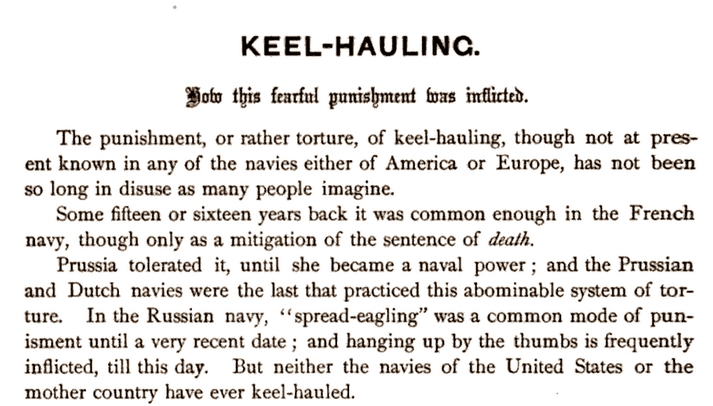
The writer continues with a description of what he witnessed:

Terrible indeed!
N. B. Spanish Keelhauling
I’ve also seen one reference to the Spanish using keelhauling: Gemelli-Careri, describing his voyage aboard the Manila galleon in 1697, notes that he heard tell of a passenger, during the senas ceremony, being made to “facendogli passere sopra il Vascello,” from which event he died. The period English translation gives this as keelhauling, although sopra means over, not under. So, while it might be keelhauling, it might also be ducking, which is more likely given the ceremony of senas, or signs of land. Ducking might be inconvenient, even frightening to some, but wasn’t usually fatal. Keelhauling often was.
N. B. Keelhauling’s Ancient Origin?
A number of web articles and books, both popular and scholarly, note that keelhauling is of ancient origin. However, this is probably not the case. Scholar Henry A. Ormerod in Piracy in the Ancient World (1924) claims that an image on an ancient Greek vase shows keelhauling, and he has reproduced the image as the frontispiece to his book. However, I see nothing in the image to suggest keelhauling per se. Instead, it appears to depict some form of water torture of prisoners who had their hands tied and were thrown overboard, perhaps pulling them back to the surface as they begin to drown. However, the image does not appear to show keelhauling as we define it—the dragging of a victim beneath the vessel from one side to another. In fact, the victims have only one line attached: keelhauling generally requires two.
Similarly, some scholars and other writers note that the Lex Rhodia of 800 BCE describes keelhauling as a punishment for piracy, but there are actually only a few short paragraphs of the Lex Rhodia that still survive and they don’t discuss punishment for piracy, so I’m not sure where this idea originated. It may be a misreading of Ormerod, who suggests that it may have described punishments for piracy. The only line that refers to piracy is in regard to responsibility for paying the ransom of a ship to pirates. This is a common problem in history: the repetition of misinformation or incomplete information as fact.
My thanks to writer Sylvia Tyburski, whose questions to me on the subject caused me to review the facts on the purportedly ancient origin of keelhauling! I’ll post a link to her article as soon as it’s available.
Copyright Benerson Little 2017. Last updated July 10, 2018.
Buccaneer Cutlasses: What We Know

Eyewitness image of a flibustier with captured Spaniards in chains. From the French chart Carte particulière de la rivière de la Plata by Paul Cornuau, probably 1684 based on a nearly identical chart he drew of the River Plate dated 1684. (French National Library.)
EXQUEMELIN’S HEROES & THEIR CUTLASSES
Although the fusil boucanier–the long-barreled “buccaneer gun” of which more blog posts are forthcoming–was the primary weapon of the buccaneer and flibustier, the cutlass was an invariable part of their armament, which also included one or two pistols and a cartouche box (sometimes two) that often held as many as thirty cartridges each. Grenades, firepots, and boarding axes were additional specialty weapons. English/black bills were fairly common aboard English men-of-war of the era (and halberds aboard the French) as well. Some seamen (and we assume some buccaneers) carried broadswords or backswords instead of cutlasses, and English seamen were known as adepts with cudgels and handspikes (see Samuel Pepys re: the latter). In a separate post I’ll discuss broadswords, backswords, cudgels, and handspikes.
Yet in spite of all the romance of buccaneers and their swords–cutlasses usually in reality, but often rapiers in cinema–we don’t know as much about the swords themselves as we would like. Much of what we think we know is based on conjecture, and this conjecture is based on what little we know about cutlasses and hangers of the late 17th century. Unfortunately, the archaeological evidence is for all practical purposes non-existent in regard to demonstrable buccaneer swords 1655 to 1688.
Cinema, the source of much of the popular image of the pirate cutlass, almost always gets these swords wrong. Typically they are anachronistic, often imitations of nineteenth century “soup bowl” hilts (and occasionally authentic 19th century cutlasses) drawn from prop stocks. Money is always a concern in film-making, and it is much cheaper to use existing swords than to make historically accurate ones in large quantities, or, too often, even in small quantities. Good historical consulting and the willingness to follow it is, of course, mandatory, but some filmmakers take the view of “Who cares? Hardly anyone will notice, what matters is that the swords look cool or ‘Rock and Roll’ or otherwise meet audience expectations, and anyway, we don’t have the budget for accurate ones, the actors and computer graphics have consumed it all.” On occasion, though, we do see fairly accurate swords in cinema–just not very often.
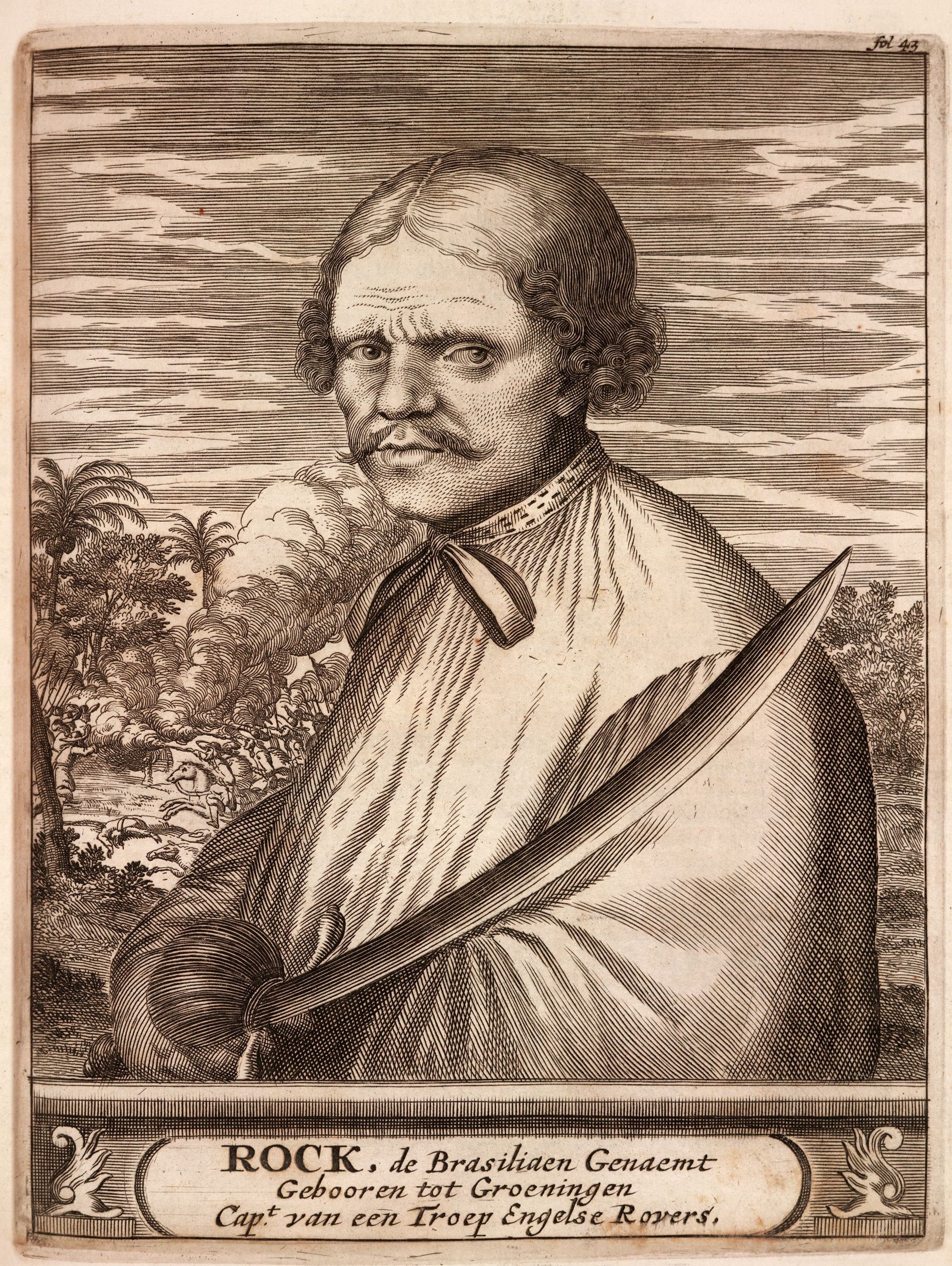
Our typical idea of a “true” pirate cutlass is taken from the illustrations, such as that above, in Alexandre Exquemelin’s The Buccaneers of America. First published in Amsterdam in 1678 in Dutch, the illustrations have been copied to other editions, typically with little or no alteration. Herman Padtbrugge, draftsman and engraver, may have been the illustrator according to the British Museum. It is unknown how much influence Exquemelin had on him, or on whomever was the illustrator. In other words, it is unknown how accurate the physical representations the buccaneers are, nor how accurate their arms and accoutrements. The cutlasses depicted in Exquemelin may simply reflect the illustrator’s Dutch nationality and familiarity with Dutch arms. Notably, the large seashell-like shells of the hilt do have an obvious maritime flavor, and are the perfect arme blanche with which to equip a buccaneer in an illustration.
Even so, the cutlasses are accurate representations of classical late seventeenth century Dutch or German weapons with large iron shell-hilts, manufactured well into the mid-18th century with basically no design changes. Basically, these cutlasses are German-style dusacks with simplified hilts. Similar shell hilts were manufactured by other European nations, albeit typically with somewhat smaller shells. The English, for example, produced some cutlasses or hangers with somewhat smaller but similar shells during the 1660s. The Dutch and German shells are usually quite large and often scalloped, the pommels often heavy for balance, the blades mildly to strongly curved, often with clip points. (Notably, cutlasses or hangers seen in paintings of Dutch naval captains and admirals have only small shells.)
Typically these large shell-hilts may have had a single shell on the outside, with or without a thumb ring on the inside, although usually with one; or a large outside shell and smaller inside shell, both most commonly facing toward the pommel. A thumb ring may be present or absent in the case of two shells. These heavy-hilted cutlasses may have two short quillons with no knuckle bow, or a conventional short or medium upper quillon along with a lower quillon converted to a knuckle bow as in the image below. Pommel style and grip style and material–wood, bone, antler, brass, shagreen (“fish skin,” ray skin), wire over wood, or even iron–vary widely. Blade balance varies just as widely, with some heavy-bladed cutlasses balanced more like cleavers than fencing swords. This is not a criticism: cleaving strokes with a cutlass are quite effective at close range.
The cutlass wielded by Rock the Brazilian above appears, on close examination, to have a single outside scalloped shell, two quillons (although it’s possible the lower quillon might actually be a knuckle bow, but I doubt it is), a heavy pommel, and a thumb ring.
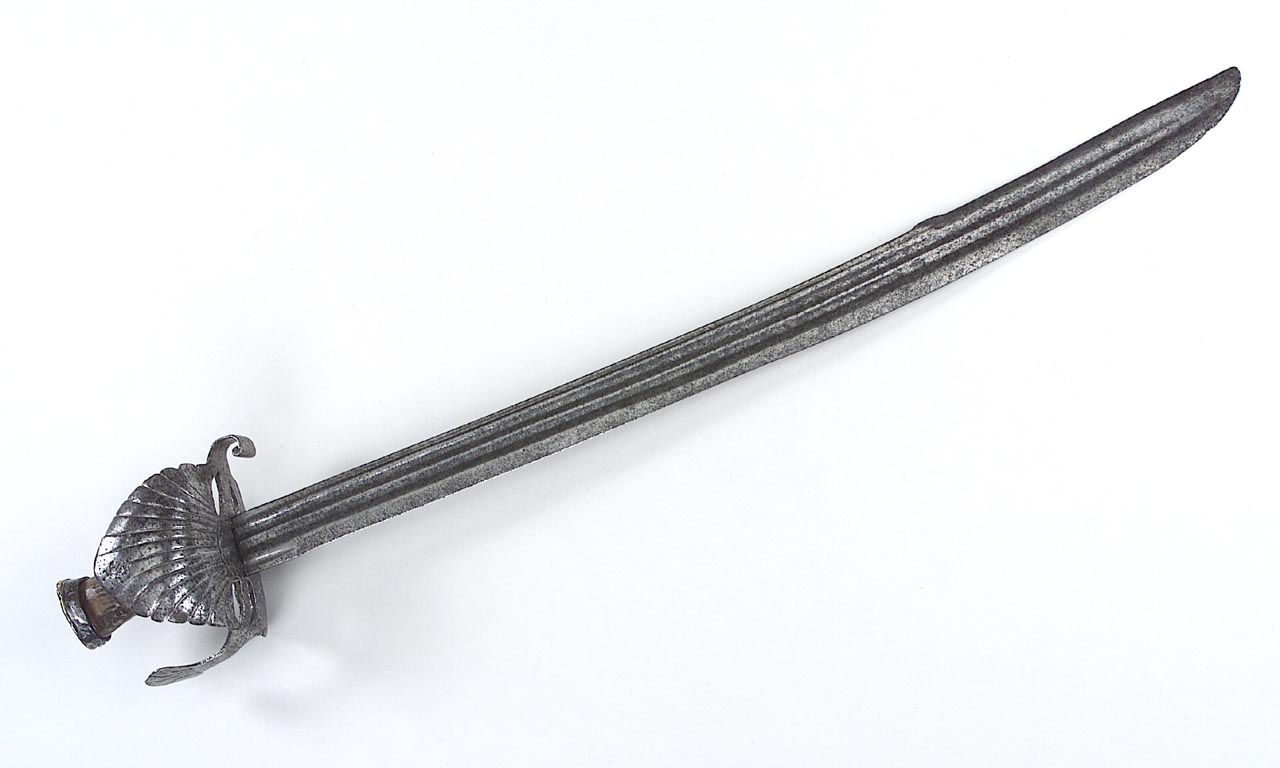
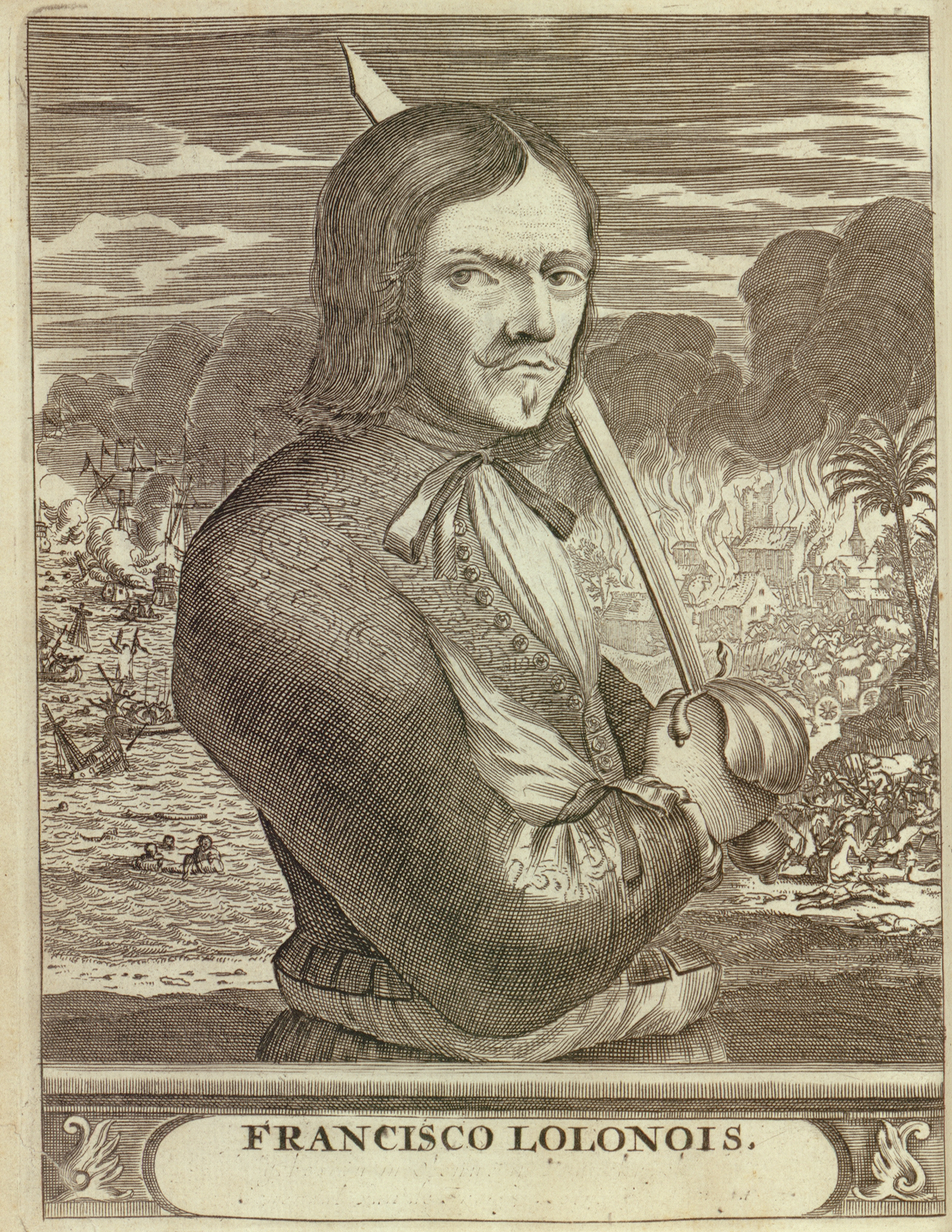
L’Ollonois above holds a typical Dutch or German scalloped shell-hilt cutlass of the late 17th century. Its shell is medium to large, the quillons small and curved, the pommel round and heavy, the blade moderately curved and with a clip point useful for thrusting. It appears it may have a thumb ring or an inner shell, probably the former.



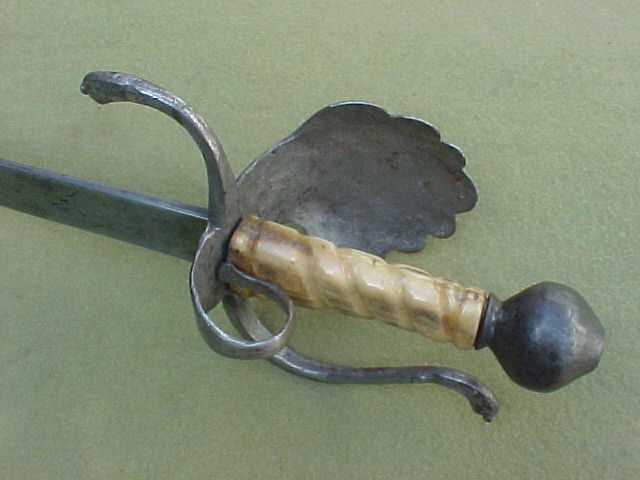
EYEWITNESS IMAGES OF BUCCANEER & FLIBUSTIER CUTLASSES
What we do not know is how common these swords were among buccaneers and flibustiers. Doubtless there at some among them, given how common these cutlasses were. However, the most direct evidence we have of the sort of cutlasses used by these adventurers comes from several drawings of flibustiers in the 1680s by Paul Cornuau, a cartographer sent to survey French Caribbean ports, in particular those of Saint-Domingue (French Hispaniola, modern Haiti). Typically he included local figures flanking his cartouches, and most of these figures are flibustiers and boucaniers. Notably, these are eyewitness illustrations! (See also the The Authentic Image of the Real Buccaneers of Captain Blood: His Odyssey by Rafael Sabatini (Updated) and The Authentic Image of the Boucanier pages for other eyewitness images.)
In the image at the very top of the page, the flibustier holds a cutlass with a small hilt of indeterminate shape, without a knuckle bow, and with a strongly curved clip point blade. There is no baldric: he wears a sword belt of the sort common at the time, with a pair of hangers with loops (one of them is not shown) hanging from the belt itself. None of these period images of flibustiers show baldrics, although they were a common way of carrying a smallsword into the 1680s for civilian use, and prior to this by infantry and other military branches. However, most infantry began abandoning them in this decade, if not earlier, and they remained in use afterward primarily by mounted troops and Scottish Highlanders.
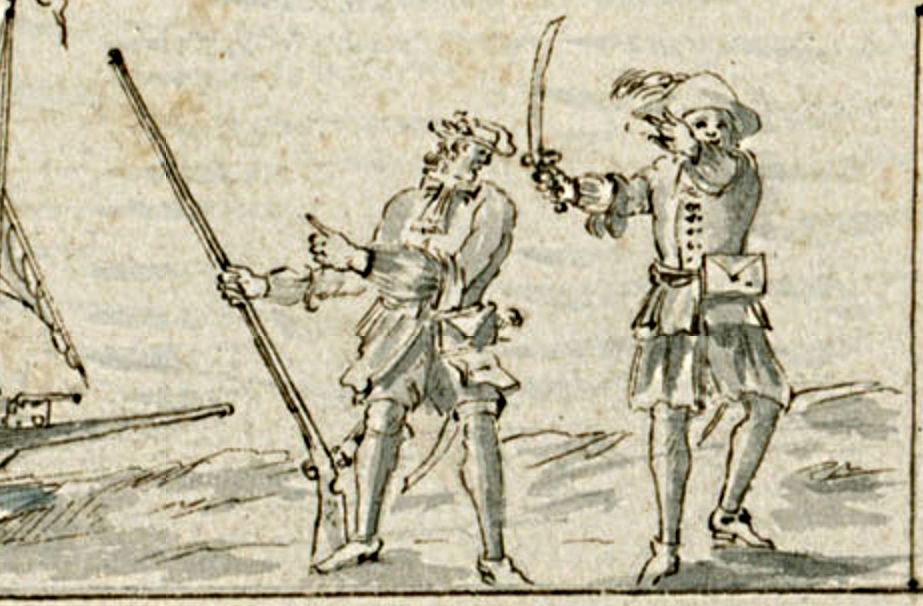
In the image above, we can tell little of the cutlass belonging to the flibustier on the left except that it has a clip point and that it may be of brass, based on its probably monster, beast, dog, or bird pommel, although some iron pommels have a similar profile, and some iron hilts have similar brass pommels. It appears to lack a knuckle bow. Its scabbard is worn from the belt. The flibustier on the right holds a cutlass with a moderately curved blade and clip point. Its hilt has two shells, both small and scalloped. Its pommel may also be of some sort of beast or bird, although we cannot be certain, and there is no knuckle bow. Again, the scabbard is worn from the belt. A similar illustration of a flibustier (on the Authentic Image post, of a flibustier at Île-à-Vache, 1686, from a chart by P. Cornuau) shows only a scabbard with an obvious clip point. It, too, is worn from the belt.
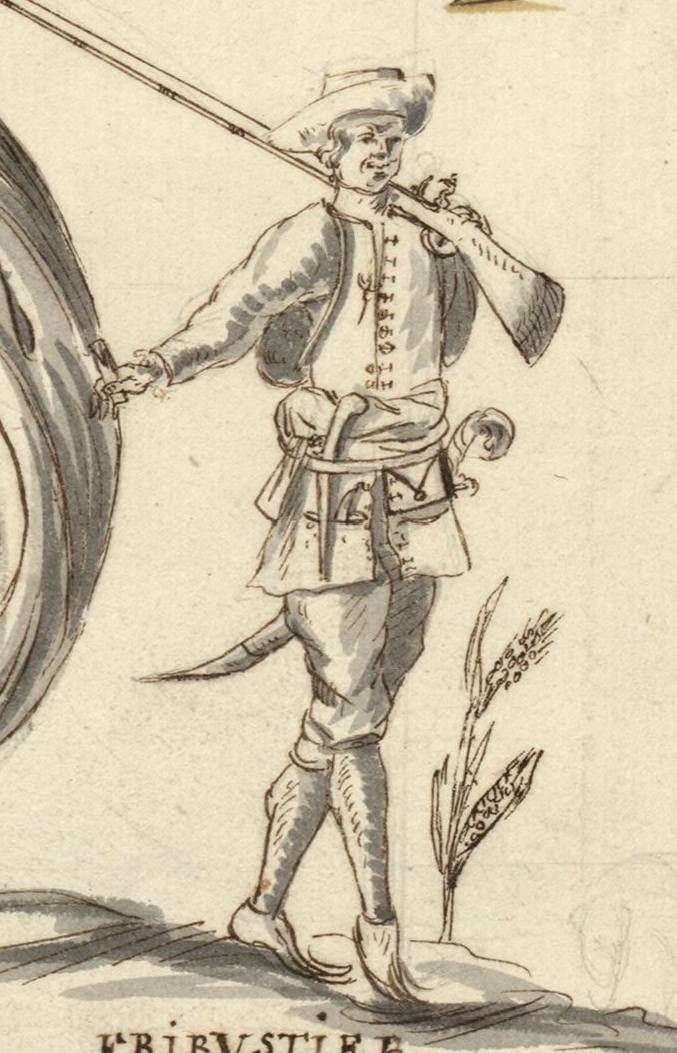
In the image above we have more detail of the hilt. It is clearly of the monster, beast, dog, or bird pommel type, almost always brass. There is a bit of shell showing, but what sort we can’t tell other than that it is scalloped, although if brass we know it is comparatively small. Again, there is no knuckle bow. Notably, the scabbard, which also has a chape (metal protection for the tip of the scabbard), does not necessarily reveal the blade form: it may be with or without a clip point.
So, what would these cutlasses depicted by Cornuau actually have looked like? And what is their origin? For the latter answer, the cutlasses could be of Dutch, English, or possibly French origin. There are numerous English cutlasses and hangers of this form still extant, and of the Dutch as well; the Dutch are often credited as the likely creators of this form. There is less information, though, and few examples, of French cutlasses from this period, although the French may have produced similar arms. There are numerous examples from English and Dutch naval portraits. Most of these swords appear be gilded brass hilts. Although some flibustiers and buccaneers may have carried cutlasses with gilded hilts, most were probably simple brass or iron.
PERIOD EXAMPLES

Starting with brass-hilt cutlasses similar to most of those in the Cornuau illustrations, we see a variety of shells and pommels above, although most grips appear to brass, or possibly wire, twisted in a sharply ascending manner. Pommels include a bird of prey, lions, and one or two indeterminate forms similar to that shown in the illustration above of the flibustier armed and equipped to march against a town or city.
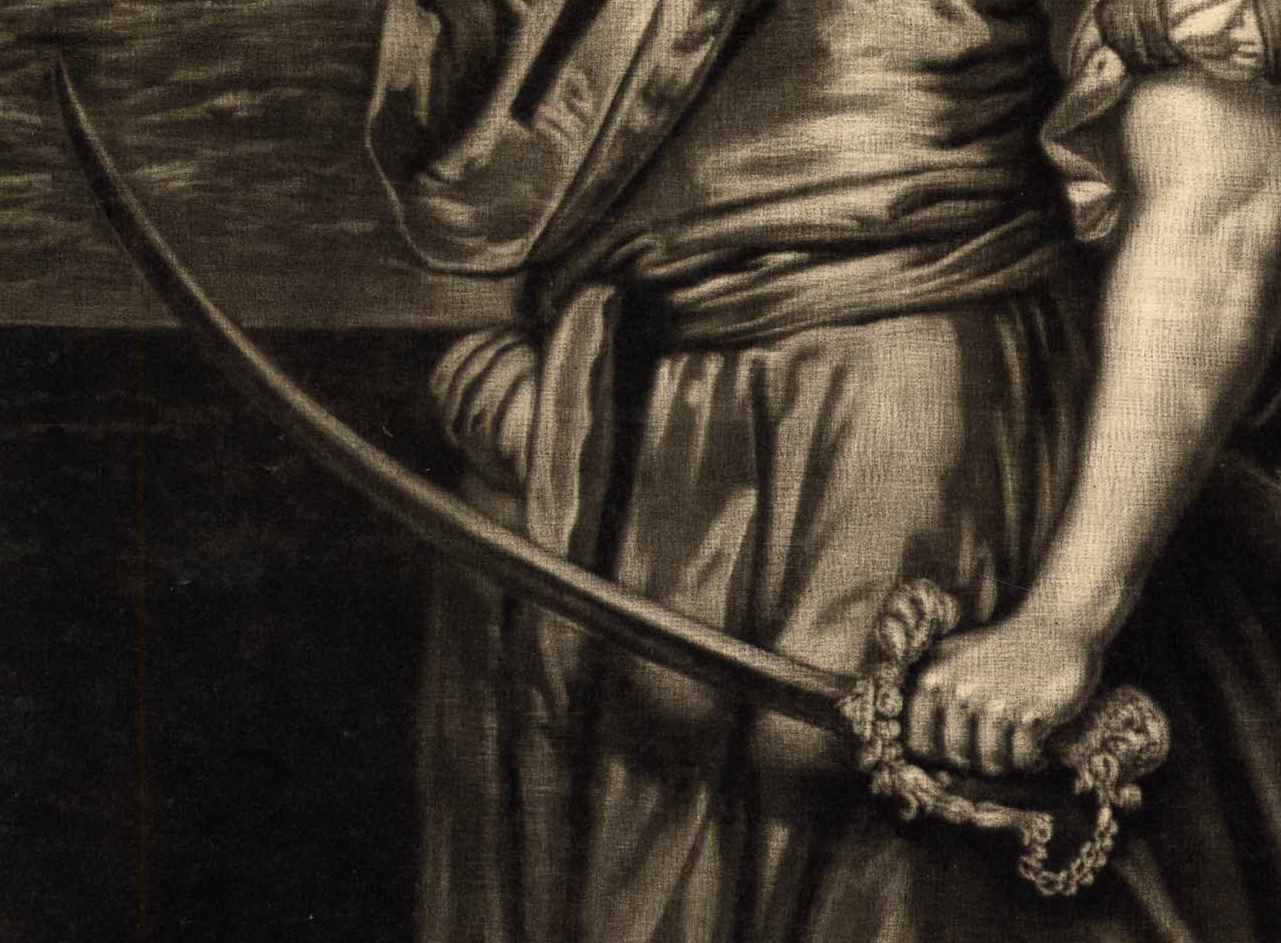
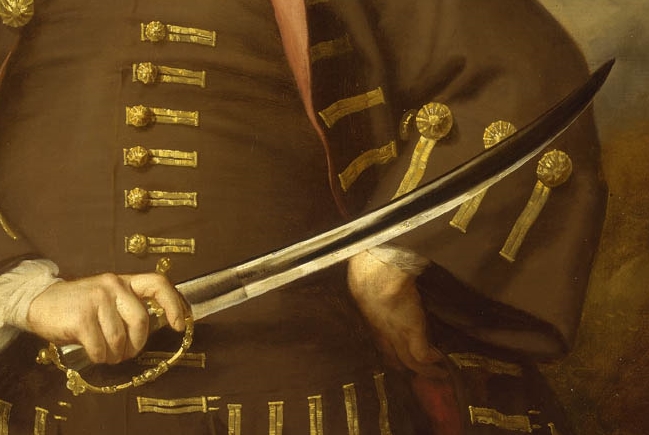

If we consider that this form of cutlass is likely Dutch in origin, it behooves us to look closely at one. The image above is of the hilt of the cutlass of famous Dutch admiral Michel de Ruyter. Note that it too lacks a knuckle bow.
Below are several hilts with a variety of knuckle bows. The 4th from the left looks somewhat like a transitional rapier or smallsword hilt, but it appears it may lack the usual arms of the hilt, plus the sword hangs low from the belt and at a steep angle, making it possible that it is a hanger or cutlass. The last image has a knuckle bow of chain, as if a hunting hanger, which it might well be. Again, we see dog or monster pommels, and also lion pommels.



The hilt shown above may be that of a hanger or cutlass, or other cutting or cut-and-thrust sword such as a broadsword or backsword. The shells, while identical to those of a period smallsword, are, with the form of the knuckle bow, very similar to those found on some late 17th century brass-hilted English naval cutlasses. However, it is impossible to know what sort of blade was mounted in the hilt. The Elizabeth and Mary was ferrying New England militia, who were armed with a variety of non-standard arms.
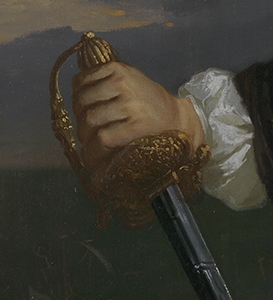
Note the similarity of the sword of Sir Christopher Myngs–possibly a transitional sword with a “rapier” style blade, or a light cut-and-thrust broadsword–to that of the shipwreck hilt.
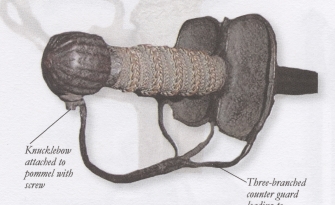
Thankfully, there remain a fair number of extant examples of hangers and cutlasses other than the few shipwreck artifacts, although maritime or naval provenance is often difficult to prove. A few examples are shown below. Note that two of them have iron shells and/or knuckle guards, with brass pommels. Some buccaneer cutlasses could have been of this form.

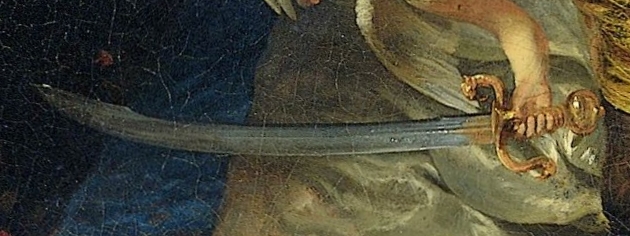

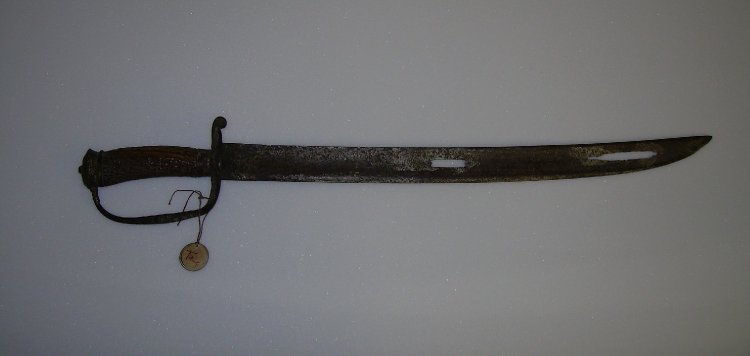
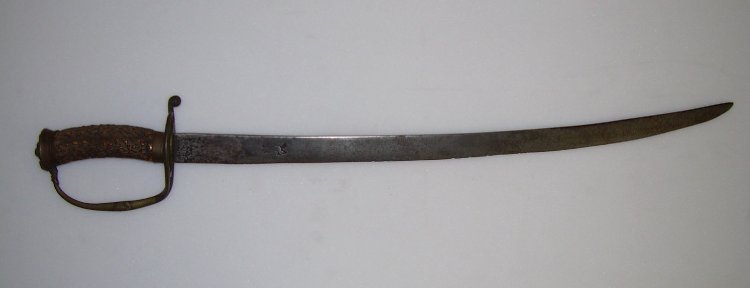
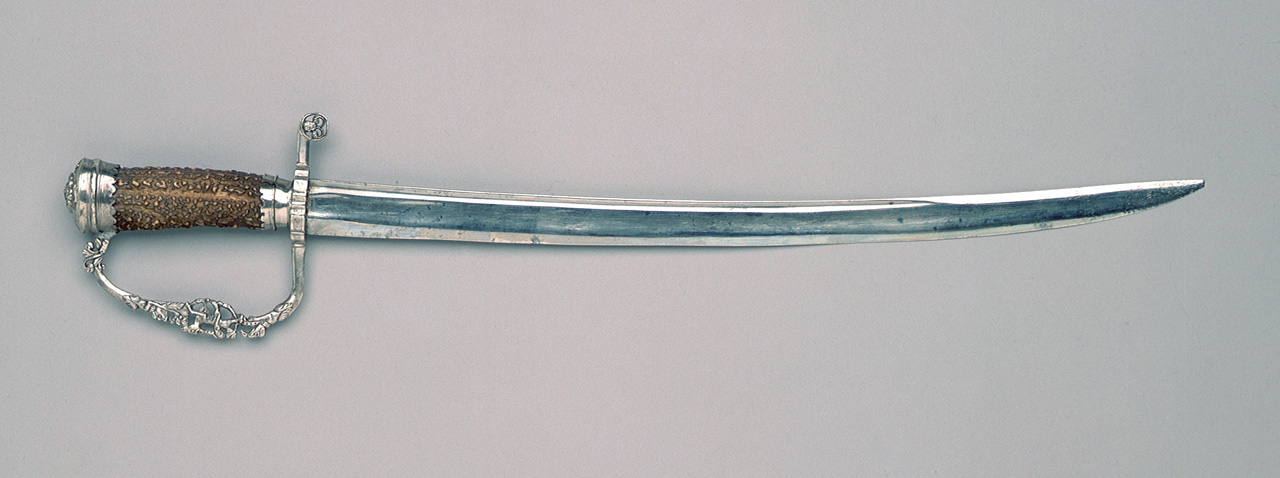
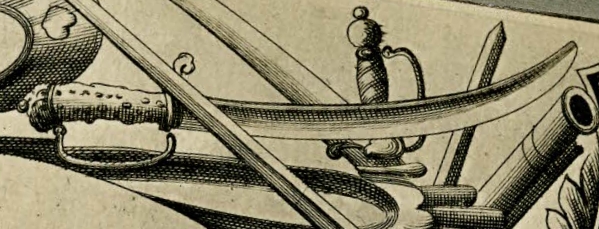


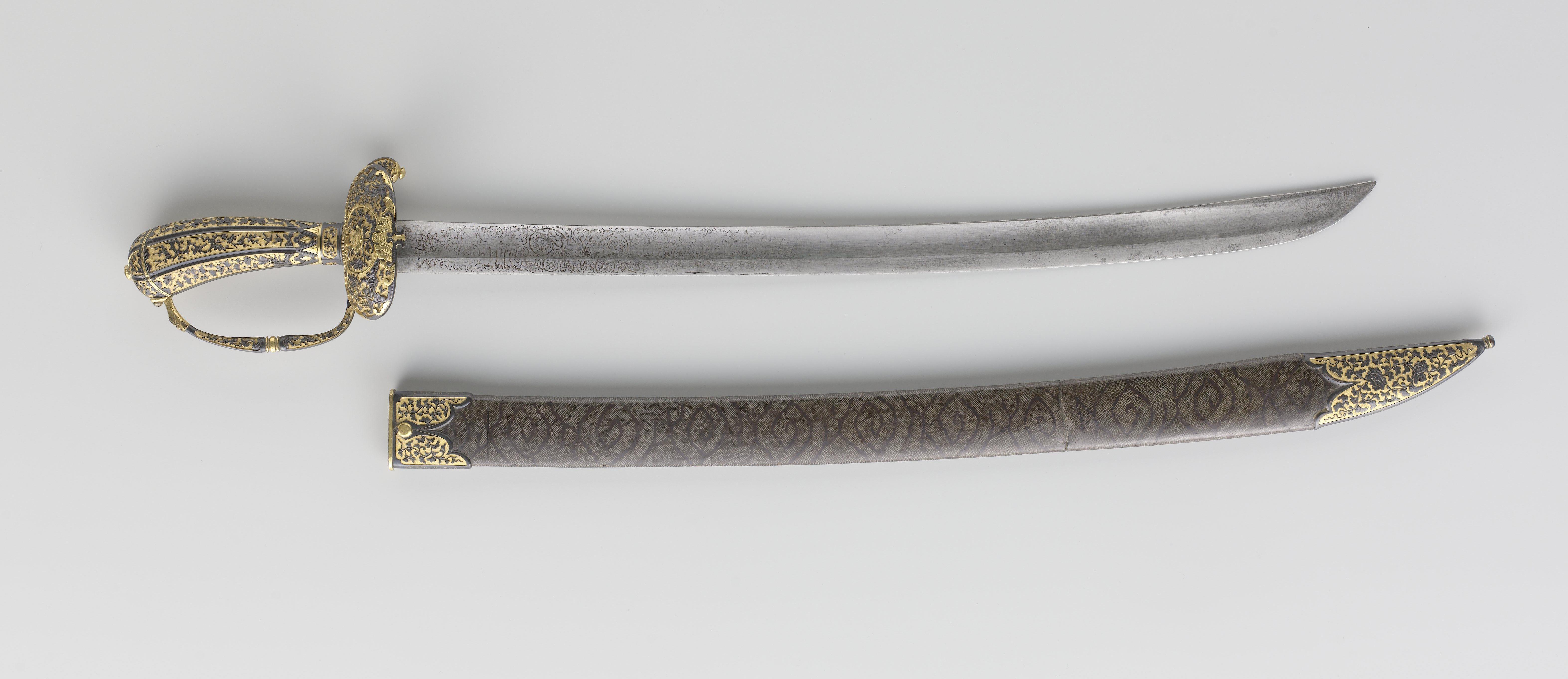

In addition to online sources, several good illustrations of brass-hilt cutlasses, which were typically more ornate than iron-hilted, can be found in William Gilkerson’s Boarders Away, With Steel (Lincoln, RI: Andrew Mowbray, 1991). Images of cutlasses from Harvey JS Withers’s collection for sale and sold can not only be found online, but in his book, The Sword in Britain, volume one. There are other available sources as well, including several additional reference in this blog.
Below is a detail from an illustration of the famous Jean Bart–a Flemish corsaire in French service–showing him with a cutlass. (Several other period images show him armed with a smallsword, but at least in the image below he is on the deck of a ship.) The cutlass has what appears to be a bird pommel, a small outside un-scalloped shell (or possibly a disk shell), an upper quillon, and a clip point. The hilt is probably brass, and, given its owner, might be gilded.
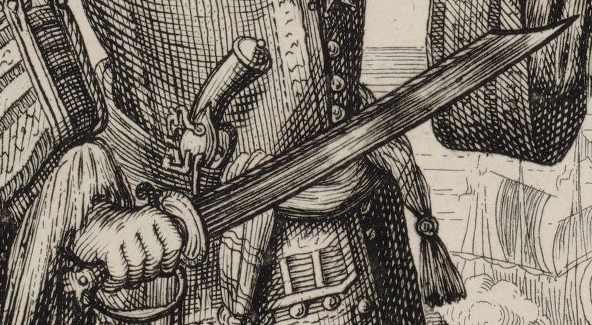
The illustration of Bart’s cutlass may represent a common cutlass carried by French naval and privateer officers, or it may represent Bart’s Flemish nationality. It appears to be a fairly accurate representation of a Dutch or English cutlass or hanger as discussed previously, although, if we look at the pistol in the belt, we may draw some reservations about its accuracy. The pistol, carried as many were, tucked behind the sash or belt on the right side to protect the lock and make for an easy left-handed (non-sword hand) draw, has errors: both the belt-hook and lock are shown on the left side of the weapon, for example, and the lock is inaccurately drawn. The lock should be on the right side, and the cock and battery are unrealistic. It is possible, but highly unlikely, that the pistol represents a double-barreled pistol with double locks.
OTHER CUTLASS HILT FORMS & SOURCES
Other forms were doubtless used, including the Dutch/German discussed above, as well as the very common smaller iron shell-hilt cutlasses as in the example below. Both William Gilkerson in Boarders Away, With Steel (Lincoln, RI: Andrew Mowbray, 1991) and Michel Petard in Le Sabre d’Abordage (Nantes: Editions du Canonnier, 2006) include a fair number of illustrations of common iron-hilted 17th and early 18th century cutlasses. These cutlasses range from a simple outside shell with no thumb ring, to inside and outside shells (the inside typically smaller) with or without thumb rings. On occasion the inside shell faces forward, especially if small. Invariably either an upper and lower quillon exist, or an upper quillon and knuckle bow. Grip material varies as with the Dutch cutlass first described, although wood and bone are the most common materials.

Another common enough form with a pair of bows, one for the knuckles, the other for the back of the hand, is shown below. This form is occasionally seen combined with small shells on brass hilts as well, as in an example above.




Of the late seventeenth century cutlass identified as French, Michel Petard in his excellent Le Sabre d’Abordage describes only one form, shown below. It is iron-hilted and has a single simple outside shell, a small quillon, a knuckle bow carried to an un-ornamented pommel. Almost certainly there were brass-hilted versions of this sword; the French grenadier sword of roughly the same date is identical, except in brass. It’s quite possible, even likely, that some flibustiers carried swords like these, both iron- and brass-hilt versions, but they do not appear to match those in Cornuau’s illustrations.

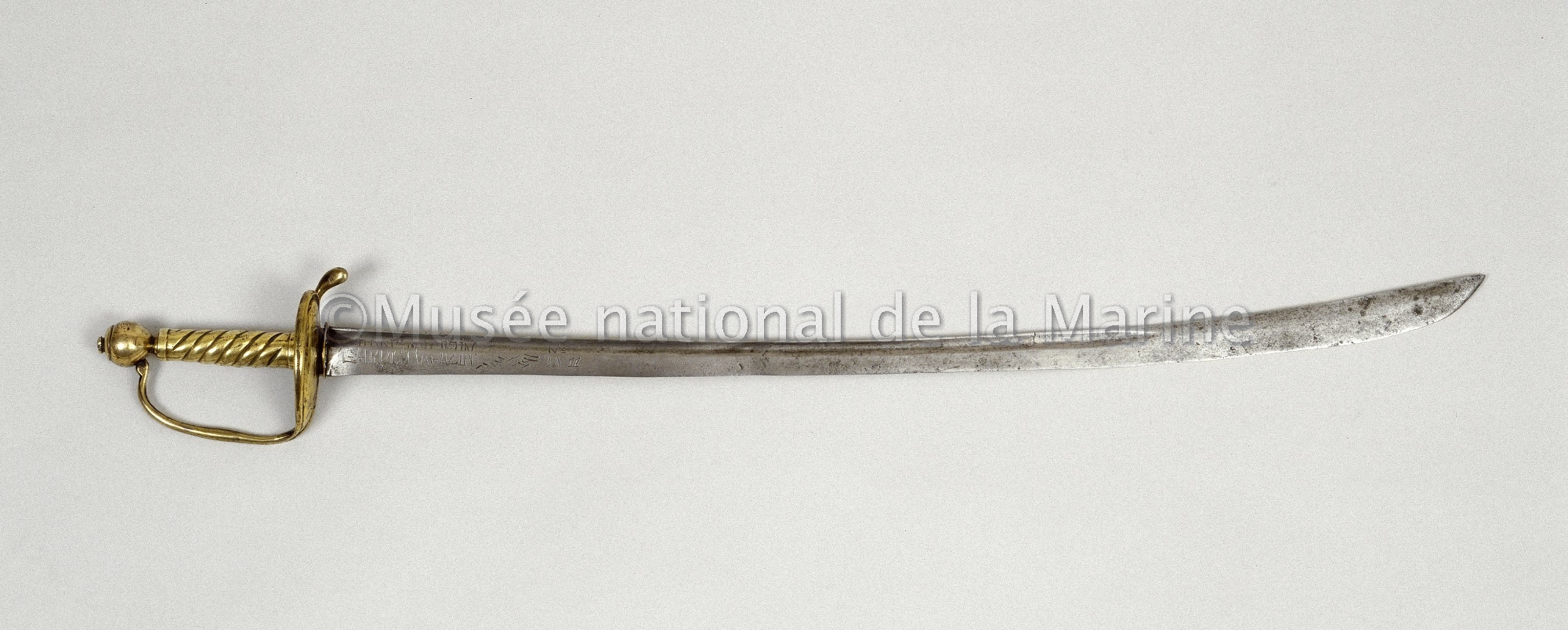
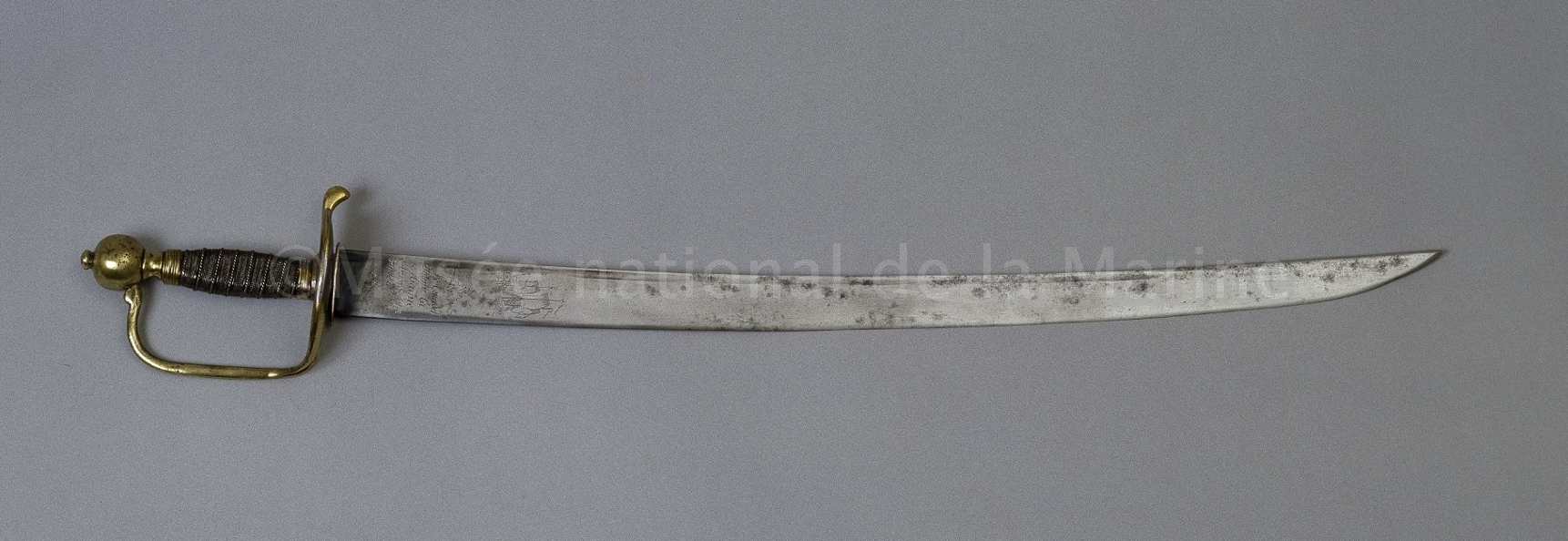


French paintings of admirals and other officers are typically of no help in identifying French cutlasses or hangers. Most of these portraits are highly stylized and show officers in full armor. When swords are shown at all they are typically smallswords (epees de rencontre).

In Cornuau’s allegorical image above, perhaps of France as Neptune or Mars, the swordsman wields a cutlass of indeterminate shell construction (possibly a simple flat disk, as in the case of some 17th and 18th century hangers and cutlasses, see image below, or a crudely drawn double shell hilt), a cap pommel, and mildly curved blade with a sharp, non-clip point and a single fuller along the back of the blade. Again, it is unknown whether this cutlass is intended to portray a flibustier weapon. Similar examples from the 17th and 18th centuries are known, including a Spanish cutlass. In general, these cutlasses consist of a simple roundish shell with a small upper quillon and a knuckle bow, or of a simple roundish shell with a small upper and lower quillon forged from the same piece of iron.



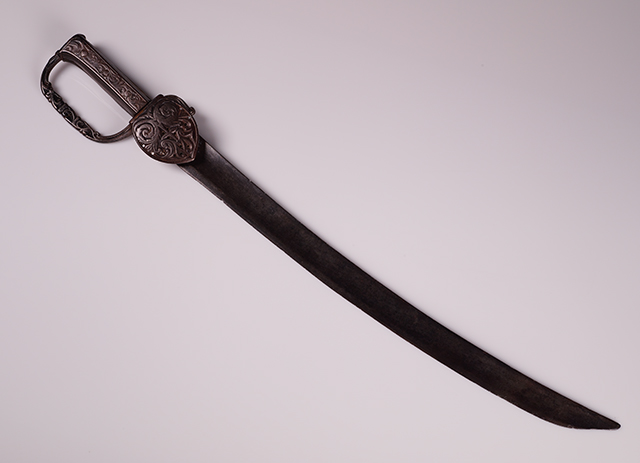
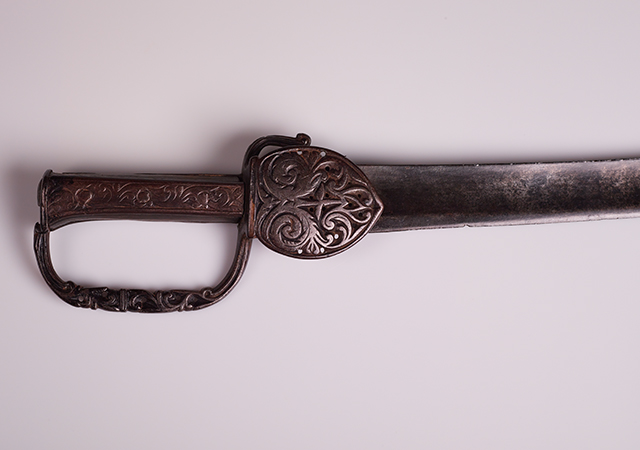
The sword above is identified by the Mariner’s Museum as a 17th century Spanish naval hanger (cutlass, that is). The shell, quillon, and knuckle guard are iron, as are the plates on either side of the handle. The hilt is without doubt that of an espada ancha (wide or common sword) of New Spain from the 17th or 18th century, commonly used by rancheros and mounted troops as both a weapon and tool similar to a machete. Although most had straight blades, the curved blade of this one does not necessarily mark is as maritime, although surely some of these swords were found aboard Spanish vessels in the Caribbean, particularly those sailing from Mexican ports such as Veracruz. A lack of blade markings is common. Chamberlain and Brinkerhoff in Spanish Military Weapons in Colonial America, 1700-1821 note that swords like this are commonly seen from the late 18th to early 19th centuries. In other words, the date may be incorrect.


Another reportedly (by an auction house) 17th century Spanish cutlass above. Iron-hilted, 22″ blade. The design is similar to the previous: knuckle guard, small upper quillion, small shell or outer guard. It too appears to be an espada ancha; I’d like to know how the auction house dated it. Its date too may be incorrect.
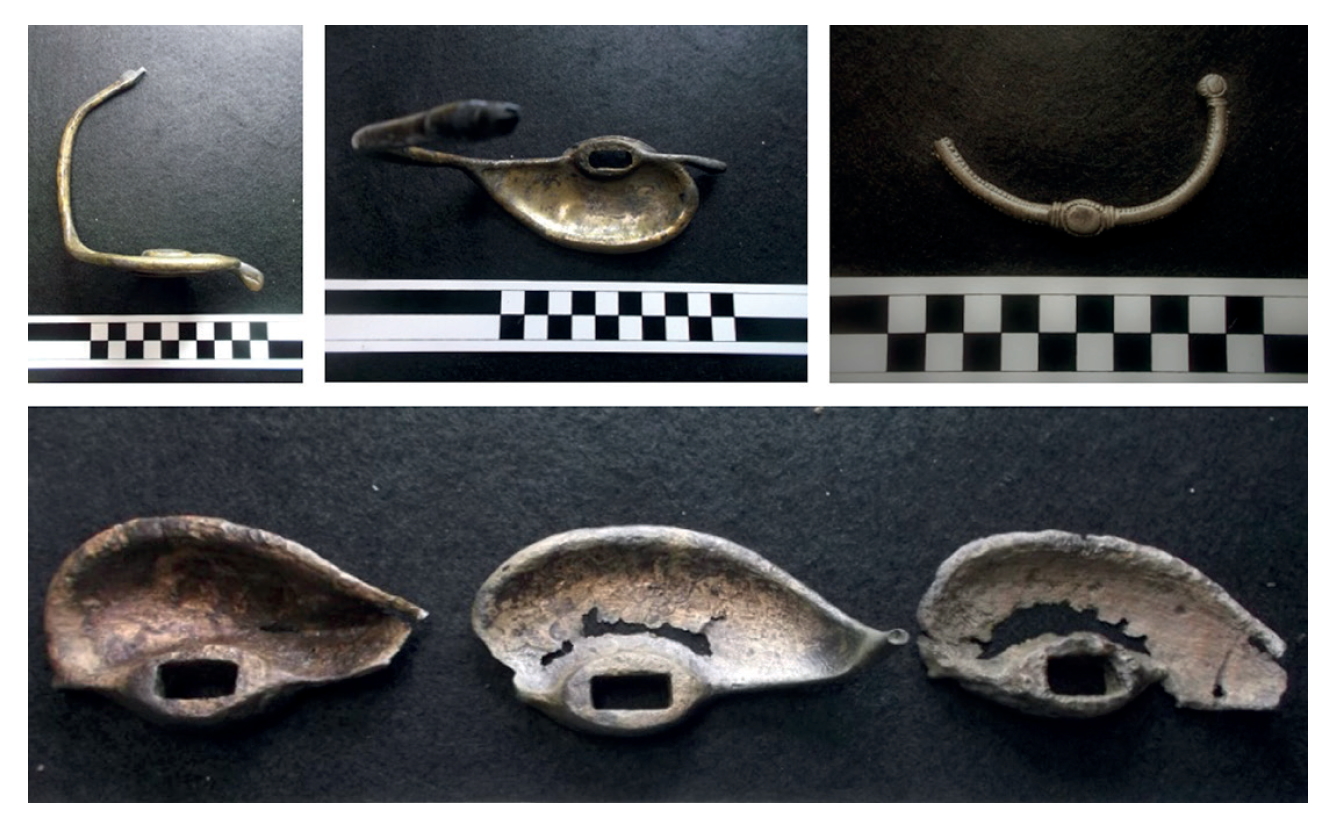
From the first quarter of the 18th century, the Spanish cutlass hilts above were authorized in 1717. The French influence is obvious.
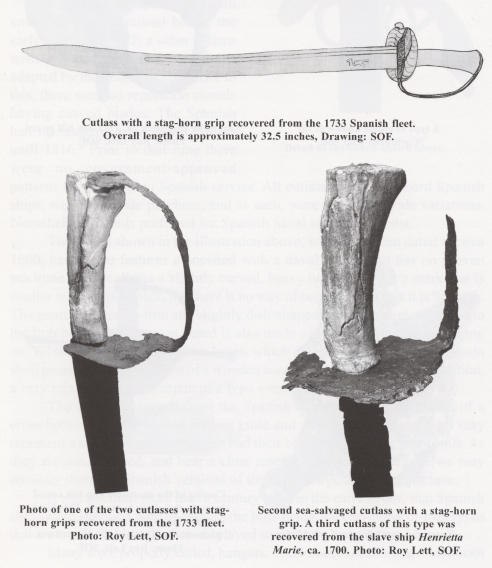
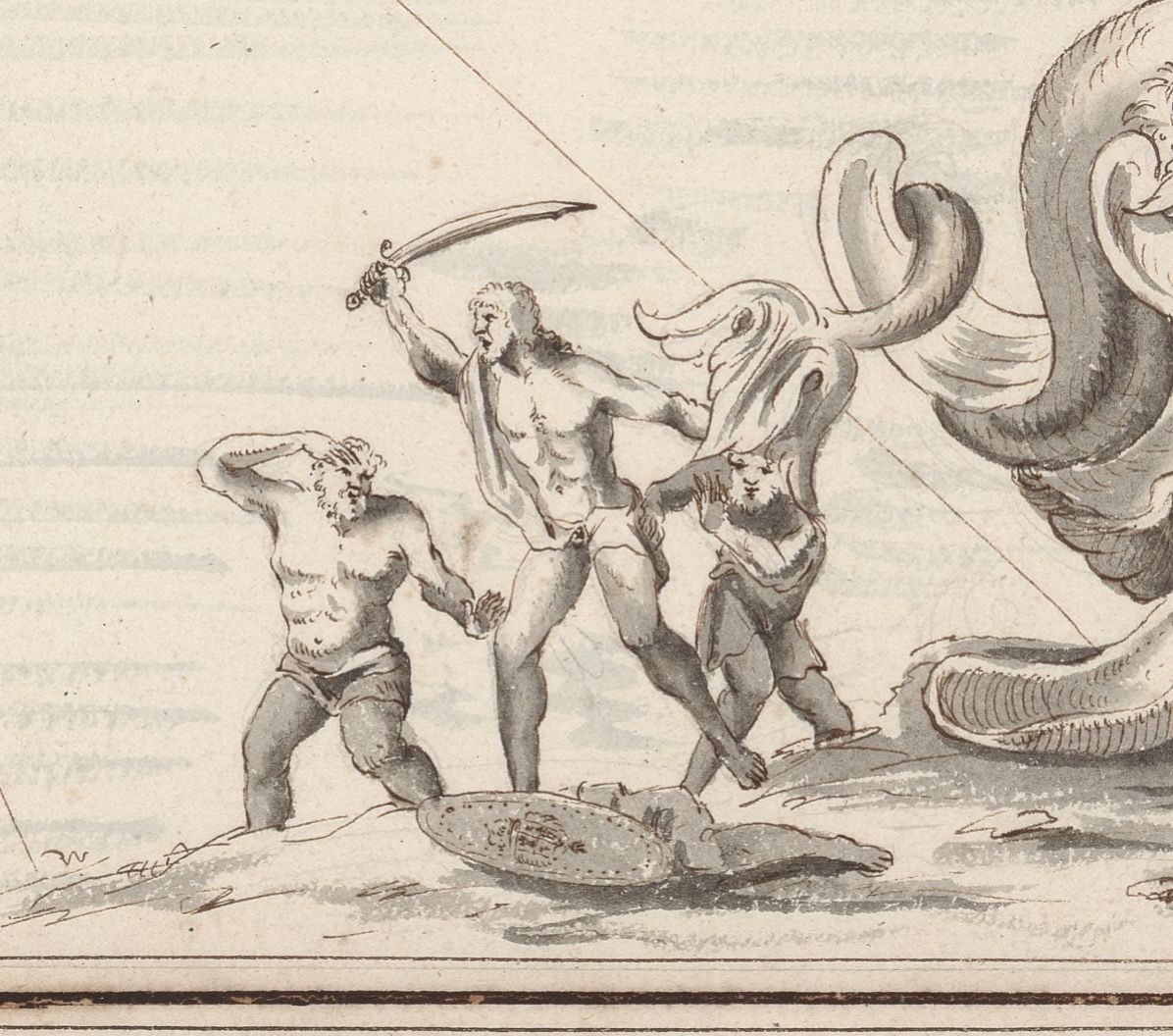
The allegorical image above by Cornuau, shows a man–again perhaps France depicted as Neptune or Mars–wielding a falchion or falchion-like cutlass with a simple hilt, round pommel, and curved blade with clip point. At the man’s feet lies a corpse cloven in half through the torso. It is unknown whether this cutlass is intended to portray a flibustier weapon. That said, there were similar mid- to late 17th century cutlasses and hangers, the one below for example.
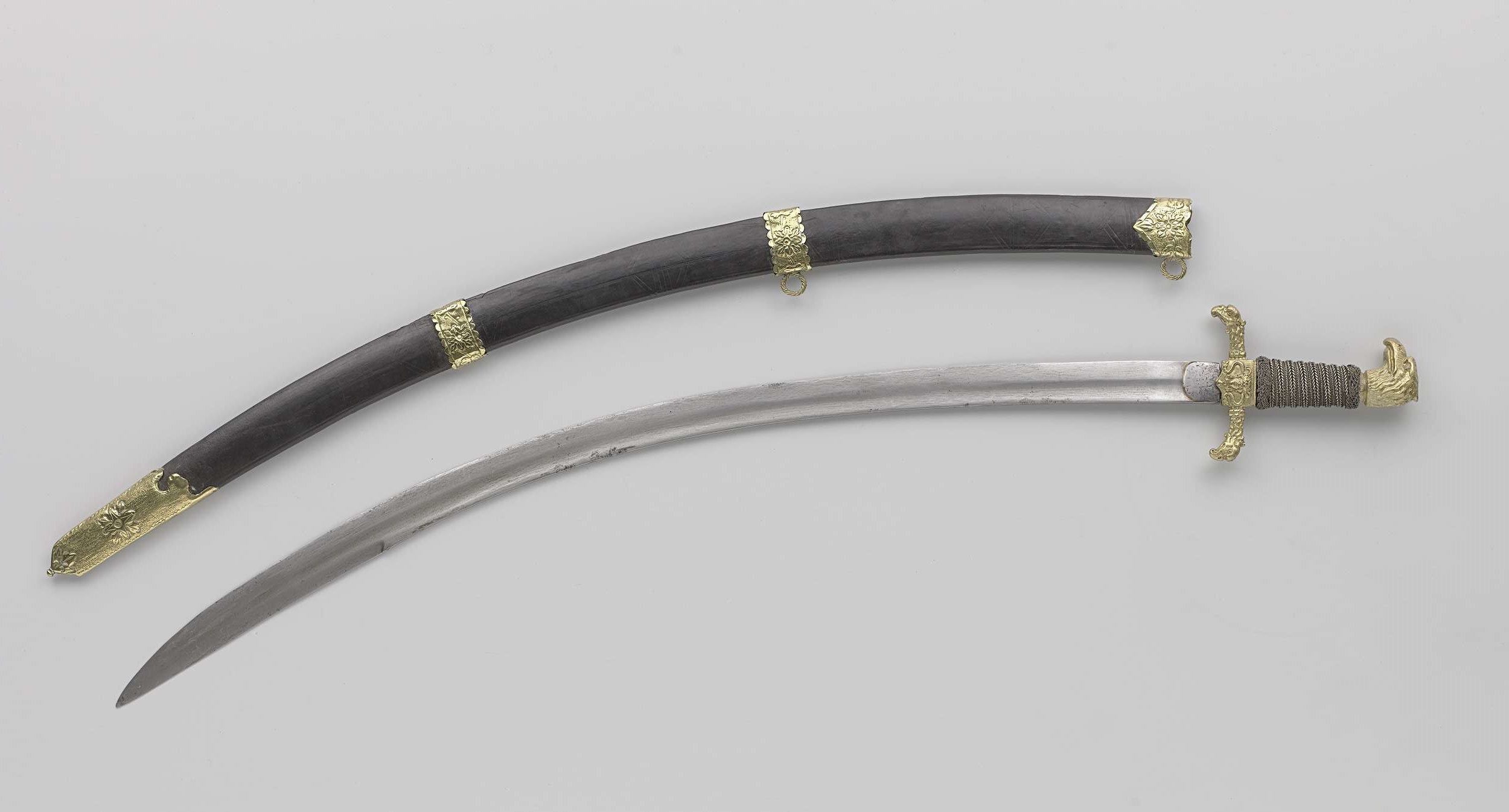
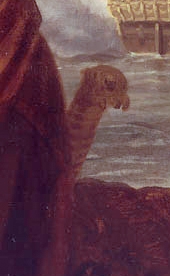
Another form that may have been seen among buccaneers is that of the Eastern European short scimitar or saber, or even long as depicted below.

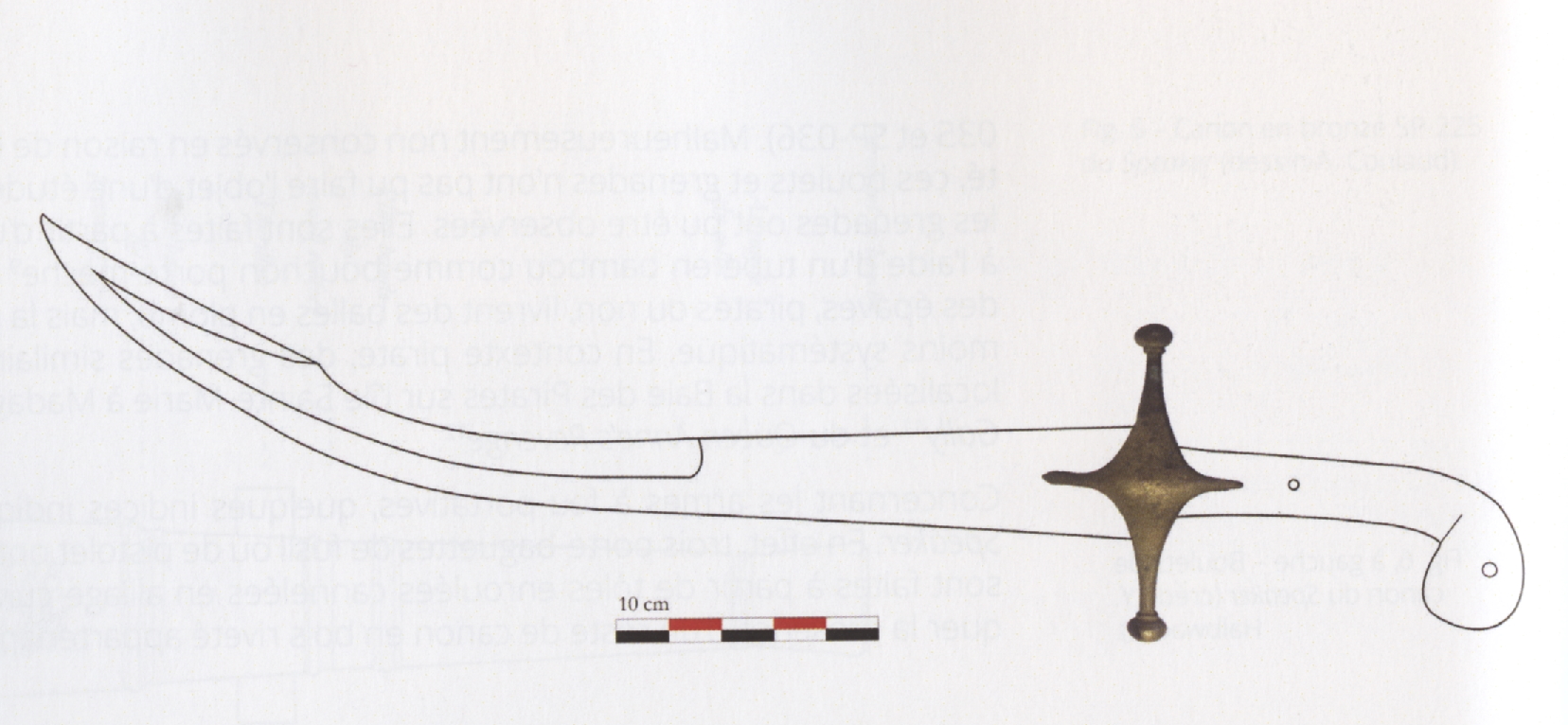
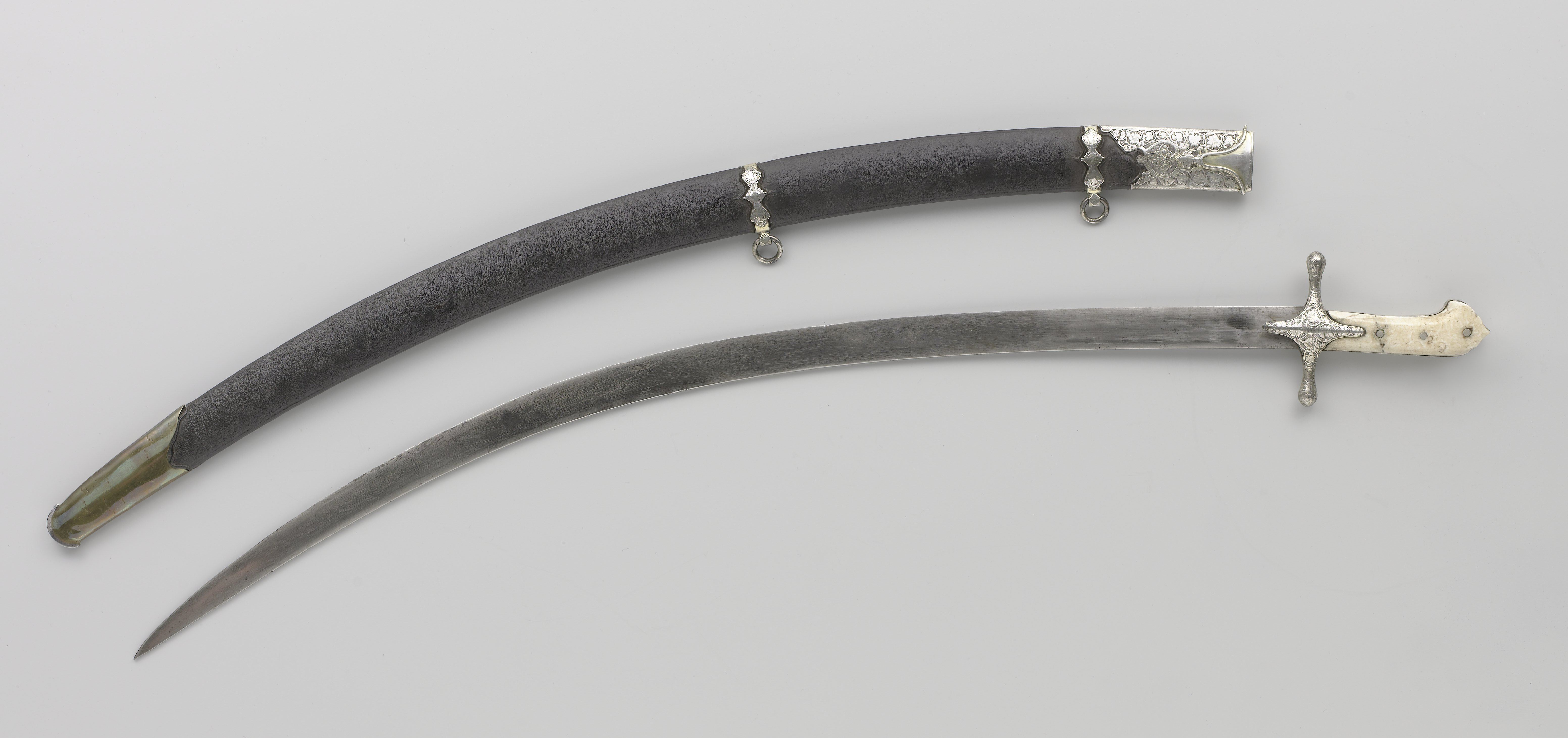


CUTLASS DESIGN AND USE
A few notes on the design and use of the cutlass are in order. Note that a thumb ring serves a very useful purpose in a sword with an unbalanced hilt, that is, one in which the outside shell is significantly larger than the inner, or in which the inside shell is entirely absent: it permits a stronger grip, preventing the blade from turning as a cut is made. If one’s grip is not firm when cutting with an unbalanced hilt, the blade may turn slightly and cut poorly or not at all. In cutlasses with a single large outside shell, any looseness in the grip will cause the cutlass to turn in the hand toward the heavier side.
Ideally, for a cutting blade to cut properly, a “draw” or drawing action must be made if the blade is straight or mostly straight. Some backsword and broadsword texts make obvious note of this, that the blade must be drawn toward its wielder in order to cut. (It may also be pushed away, in the 18th century this was known as a “sawing” cut.) However, the diagonal cuts from high outside to low inside, and high inside to low outside, have a natural “drawing” motion as the arm is brought toward the body. To make a powerful drawing cut is fairly easy: simply draw the elbow toward the body as the cut is made. A lightly laid on cut with a straight edge, one made with small arm movement, will require a deliberate drawing motion.


Sweeping cuts are the most common sort of drawing cuts, but they are dangerous in practice unless one is mounted (and moving quickly) on a horse, or has a shield, targe, or other defense in the unarmed hand. Sweeping cuts are easily “slipped”–avoided–and as such leave the attacker vulnerable to a counter stroke in tempo. They are also subject to counter-attacks in opposition. Tighter cuts may also be made with a natural draw, and this sort of cutting action is generally preferable when fighting without a shield or targe, as is the case in boarding actions. Note that wide sweeping cuts are more likely to injure one’s companions in a boarding action, and to get caught up in rigging and fittings.
In particular, a straight-bladed cutlass or other sword requires a drawing action in order to cut well. A curved blade has a natural cutting action, and the more curve there is the less drawing action must be added–the severe curve suffices. However, the greater the curve the less suitable for thrusting a sword is. A direct thrust made with such a sword (see the two heavily-curved examples of Tromp’s swords, for example) will result not in the tip penetrating the adversary, but with the first inch or two of the edge hitting. It is very difficult to push the edge of a sword deeply into tissue, and most wounds caused this way are superficial. Note that the clip point found on many cutlasses is designed to make a curved blade more effective at thrusting.
I am going to devote only a few words to the popular misconception that a heavily-curved sword, such as a scimitar, can be used to thrust effectively. Its true thrusts must be hooked, and the typical example one finds in discussions by self-appointed “experts” is that of a hooked (aka angular) thrust made after one’s adversary has parried quart (four, inside). In theory, the attacker can roll his hand into tierce (pronated), and slip around the parry with a hook thrust. This will only work if the attacker also has a shield or targe in his (or her) unarmed hand, or is wearing a breastplate: otherwise there is nothing to prevent the adversary’s riposte. In other words, try this with a curved cutlass, and while you may be able to make a thrust (which may or may not penetrate ribs) as an arrest or stop hit against a riposte, you will almost certainly also be on the receiving end of a powerful cut. In other words, try this at your peril in the 17th century.
I can think of only one exception to this advice: Andrew Lonergan (The Fencer’s Guide, 1777) notes that the Hussar saber, with its curved blade, has a natural cavé or angulation against quart, tierce, or prime parries (or any other parries, in fact). Notably, he’s referring to action on horseback with horses typically moving at speed–the rider, executing the natural angulation with the saber, can escape the riposte as he rides by, while simultaneously cutting or thrusting with cavé, which at speed will push not the point but the edge through neck or arm. This is much more difficult to do with a simple thrust or thrust with lunge, and, as noted lacks the protection of riding past. “The bent of their swords will afford them an unavoidable Quarte-over-the-arm, or a Cavè [sic: the wrong accent is used on cavé in the original text].” N.B. a thrust, or rather, a thrusting cut can be made with the edge at the tip, but requires great force (i.e. from horseback at a canter or gallop) and is, as Lonnergan notes, primarily effective against the soft tissue and joints of the arms and neck.
One of the most effective cuts with the cutlass is a powerful drawing cut, vertically high to low, the hand drawn down and backwards, from close quarters distance, or even when grappling if the blade is free. It is a highly effective cut: I have cut through twelve inches of brisket with it.
All this said, cleaving–non-drawing–blows can cut through skin and muscle, and even break bones. One need only to test this with a common kitchen cleaver to see the efficacy of such blows, although they are generally inferior to those made with a natural drawing action. Also, a cleaving blow, even with a dull blade, can still break bones. Getting hit on the head with a heavy cutlass would be akin to getting hit with a steel rod.
The grossly exaggerated Thomas Malthus edition of Alexandre Exquemelin’s The History of the Bucaniers (1684) notes the following of the cutlass in buccaneer hands:
“Never did the Spaniards feel better carvers of Mans-flesh; they would take off a Mans Arm at the shoulders, as ye cut off the Wing of a Capon; split a Spanish Mazard [head or skull] as exactly as a Butcher cleaves a Calf’s Head, and dissect the Thorax with more dexterity than a Hangman when he goes to take out the Heart of a Traitor.”
But this may not be much of an exaggeration. Of an English seamen put in irons aboard a Portuguese carrack circa 1669 out of fear he might help lead a mutiny, passenger Father Denis de Carli wrote:
“He was so strong, that they said he had cleft a man with his cutlass, and therefore it was feared he might do some mischief in the ship, being in that condition [drunk for three days on two bottles of brandy].”
Cutlass balance determines how well the cutlass may be wielded in terms of traditional fencing actions, and which forms of cuts work best. A heavily-balanced cutlass, with much of its weight forward around the point of percussion (that is, near the end of the blade), makes for very effective cleaving and close cutting actions, and will cut well with even crude swings. However, it is less effective for skilled fencing. A well-balanced cutlass–less point or tip heavy–is a more effective fencing sword, in that it permits quicker actions such as cut-overs, but requires a bit more training or finesse to cut well. In other words, give a cleaver to an unskilled seaman, but a better-balanced cutlass to one with reasonable skill at swordplay. All this said, a skilled “complete” swordsman or swordswoman can fence pretty damn well with anything.
Switching to a discussion of how the cutlass is held, the cutlass grip, like that of period broadswords and backswords, is a “globular” one–the thumb is not placed on the back of the grip or handle. Placing the thumb on the back of the handle, assuming there is even room (typically there is not), given the weight a cutlass and its impact against its target, may result in a sprained thumb, possibly a broken one, and at the very least the thumb being knocked from the grip, thus losing control of the weapon. The “thumb on the back of the handle” grip is suitable for lighter weapons only.
Shells are quite useful–mandatory, in my opinion–to protect the hand. A single outside shell, especially in conjunction with an upper quillon and a knuckle bow, provides merely adequate protection to the hand. The inside hand and forearm remain vulnerable to an attack or counter-attack (best made in opposition). The addition of an inner shell, typically smaller, goes far to maintain adequate protection to the hand. As already noted, inner shells were usually smaller, given that the inner part of the hand (the fingers, basically) is smaller than the outer, typically 1/3 to 2/5’s of the entire fist. Again, though, differently-sized shells, especially if the difference is significant, will unbalance the weapon, making a thumb ring useful for gripping well and preventing the edge from turning and thereby not cutting.
But perhaps the cutlass’s greatest virtue, and what would have made some of its technique unique as compared to the broadsword and saber (from which late 18th through early 20th century cutlass technique was drawn), was its utility at “handy-grips.” I’ve covered this subject elsewhere, but besides the close cleaving or drawing cut described above, pommeling would have been common, and “commanding” (seizing the adversary’s hilt or blade) and grappling would have been common as well. F. C. Grove in the introduction to Fencing (London: Longmans, Green, and Co., 1893) wrote: “One of us once saw a sailor of extraordinary strength seize a cutlass close to the hilt, where the edge is blunt, and break it short off.” This was an extraordinary example of a surely commonplace tactic.
There are few descriptions of the cutlass in action, but of those that exist, they are quite illustrative. Of a fight between English slavers and Africans on the Guinea Coast in 1726, William Smith wrote:
“[F]or they press’d so upon us that we were Knee deep in the Water, and one of them full of Revenge, and regardless of his Life, got out into the Water behind me, resolving to cleave my Skull with a Turkish Scimitar, which Ridley perceiving, leap’d out of the Canoe, and just came time enough to give him a BackStroke, which took the Fellow’s Wrist as Was coming down upon my Head, and cut his Hand off almost. Ridley with the violent Force of the Blow at once snap’d his Cutlass and disarm’d the Negroe, whose Scimitar falling into the Water, Ridley laid hold’of, and us’d instead of his Cutlass.”

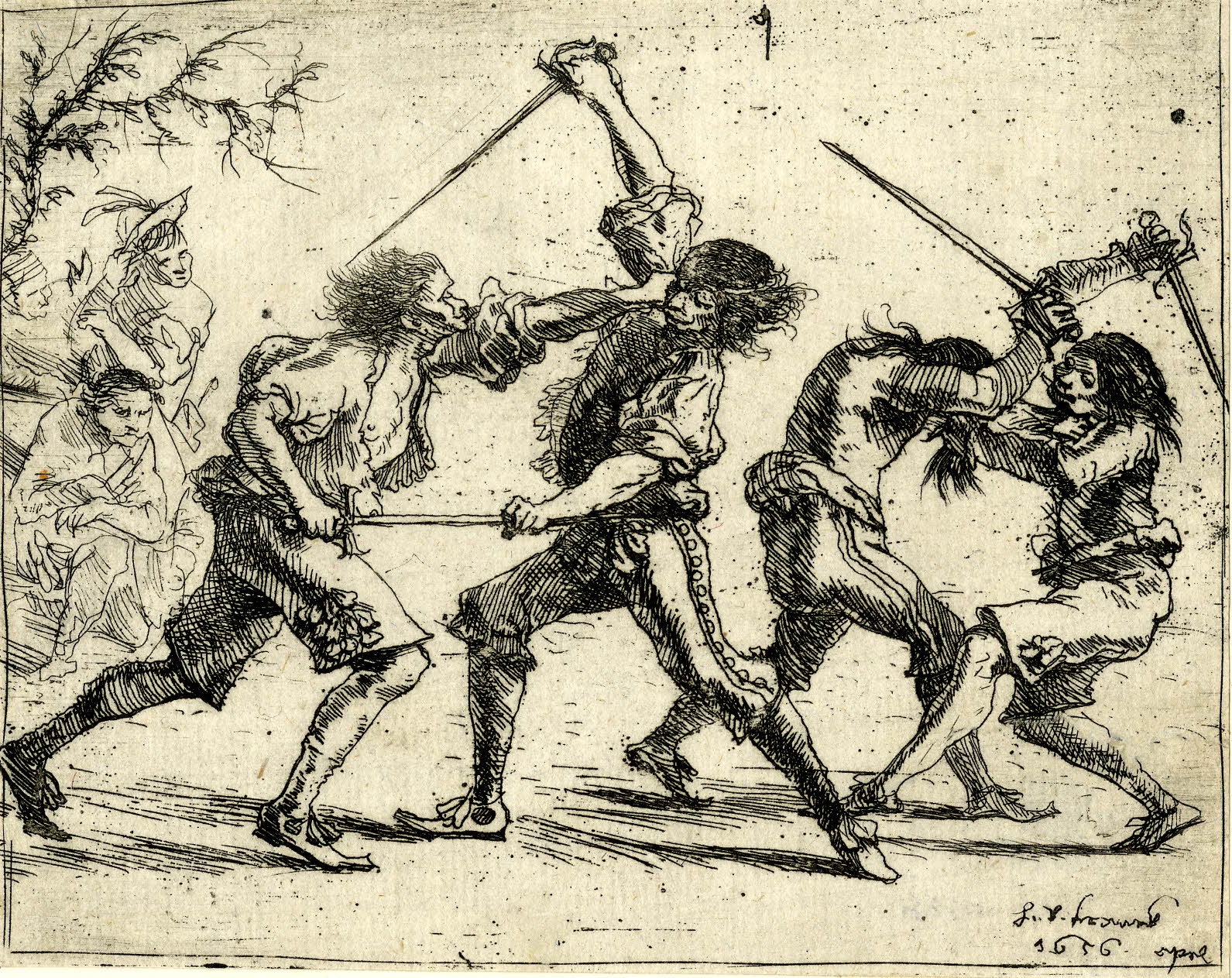
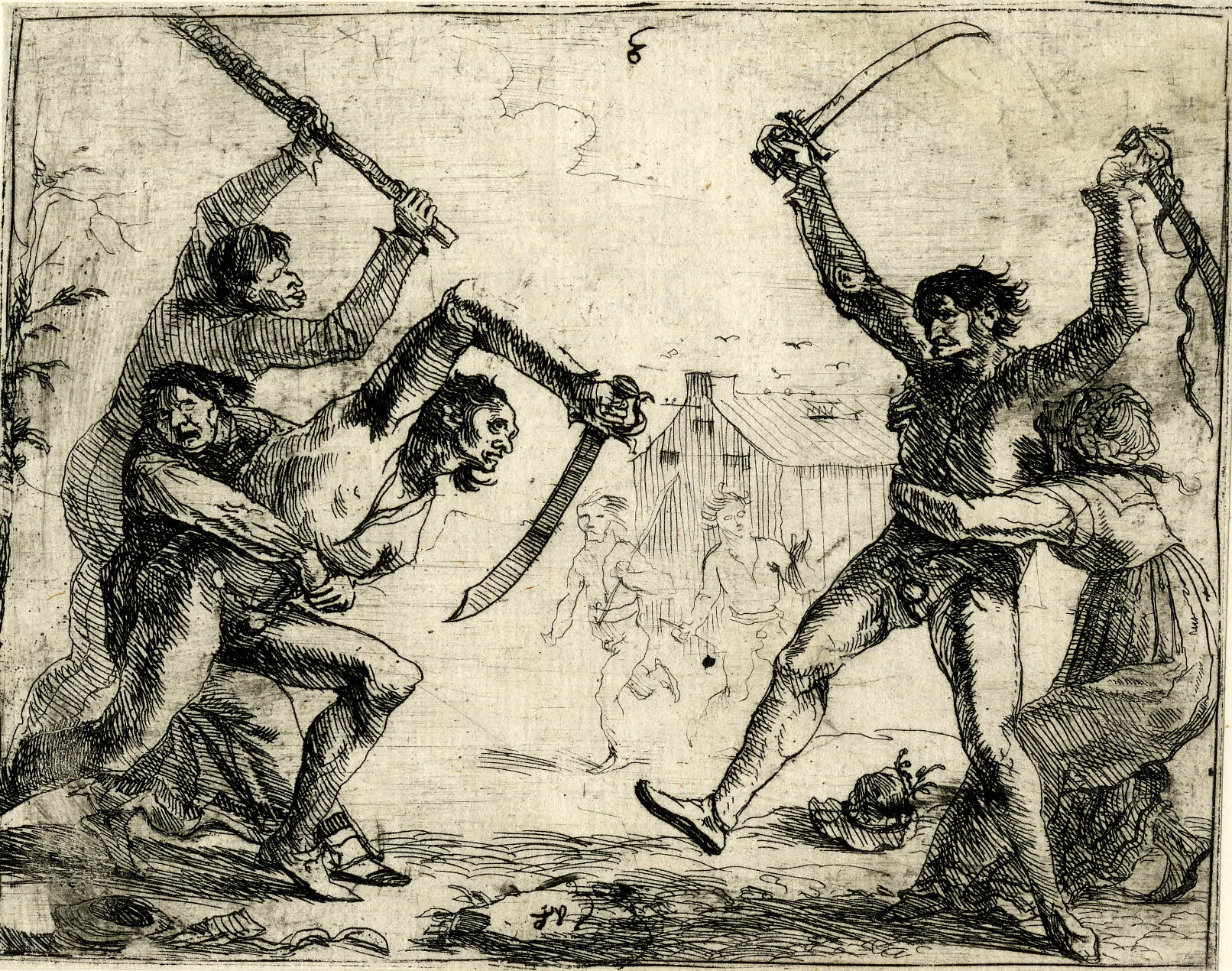

There are unfortunately no cutlass texts dating to the age of the buccaneer, and few fencing texts discuss even related weapons until the 18th century. The only 17th century exception I can think of offhand is Francesco Antonio Marcelli’s treatise on the rapier (Regole Della Scherma, 1686), in which he devotes a few pages to saber versus rapier, noting quite correctly that the saber, and therefore also falchion, cutlass, &c., is a killing weapon even at very close range. See below. In The Golden Age of Piracy I discuss to a fair degree what we know from period accounts about how the cutlass may have been used.

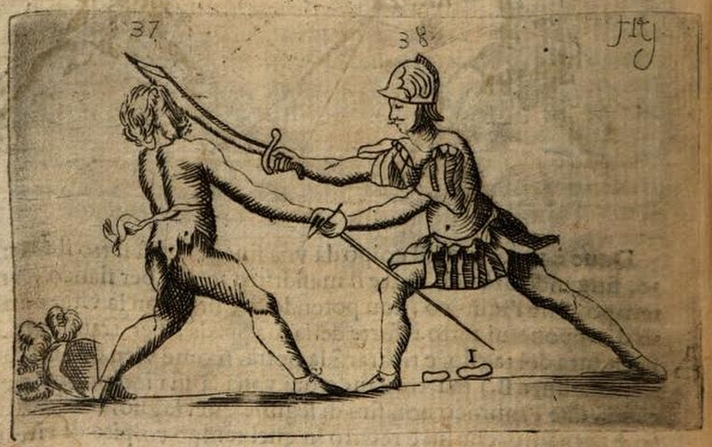
I’ve discussed training in the cutlass elsewhere, including a few notes in my Fencing Books For Swordsmen & Swordswomen post. In Sea Rover’s Practice I note that there was clearly some instruction at sea, although it may have often been ad hoc as was often the case ashore. Late seventeenth century French privateer captain Duguay-Trouin hired a fencing prévôt (assistant to a fencing master) to help school his crew in swordplay (and later found himself in a rencontre, swords drawn, with the man in the street), and mid-eighteenth century English privateer captain “Commodore” Walker had training sessions aboard his ship, the officers practicing with foils, the seamen with singlesticks.
The only pirate captain we know of who was said to have held swordplay practice aboard ship is John Taylor in the Indian Ocean in the early 18th century, according to prisoner Jacob de Bucquoy (Zestien Jaarige Reize Naa de Indiën, Gedaan Door Jacob de Bucquoy, 1757, page 69). Taylor’s pirate crew reportedly held practices, as Commodore Walker would later do, with foils and single-sticks. I am a bit leery of this report, however. Although it certainly may be true, it is tied to a criticism of Dutch East Indiamen captains and crews, with de Bucquoy suggesting that the pirates were more disciplined and trained in a manner that the East Indiaman crews were not. Most historical accounts show a great deal of indiscipline among pirate crews.
However, it is impossible to maintain proficiency in arms without practice, thus it is likely that pirates practiced swordplay. The question is to what degree, and whether the practice was formal or informal. Further, there is the question of whether or not pirate captains deliberately outfitted their vessels with foils and single-sticks or “cudgels” as they were commonly known. Doubtless Duguay-Trouin and Commodore Walker did, but, assuming the Taylor account is correct, Taylor’s were probably from captured stocks. That said, singlesticks are easily crafted (but not so foils). Please note that real weapons were not used for fencing practice! This would soon enough destroy their tips and edges, not to mention that it would be very dangerous even with protection. Fiction and film have, for ease of plot not to mention laziness or ignorance, given many the false idea that swordplay was practiced with real swords. A single-stick or cudgel, by the way, differs from a real sword “only that the Cudgel is nothing but a Stick; and that a little Wicker Basket, which covers the Handle of the Stick, like the Guard of a Spanish Sword, serves the Combatant, instead of defensive Arms.” (Misson’s Memoirs and Observations in His Travels Over England, 1719.)


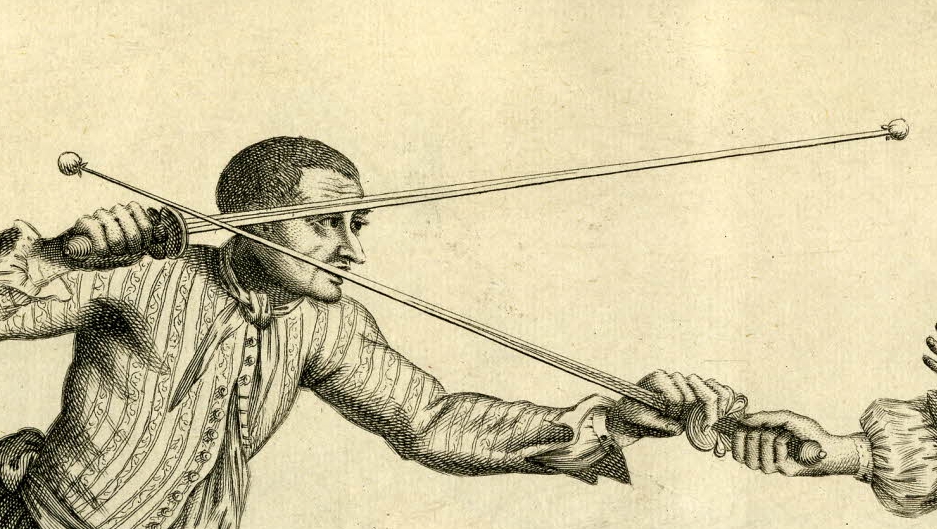

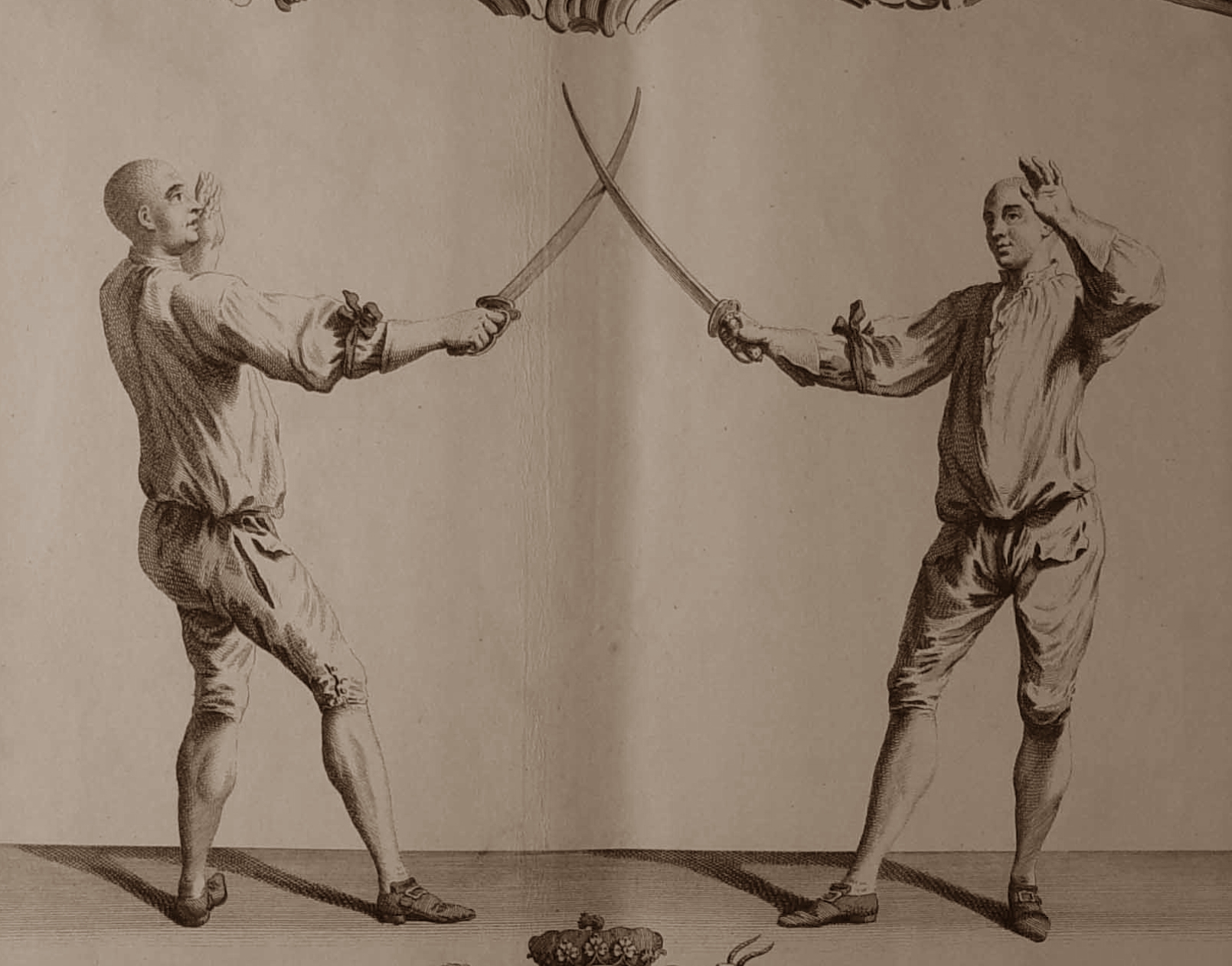

Possibly one of the more practical texts, and even then incomplete, is that of Lieutenant Pringle Green in manuscript in the National Maritime Museum, Greenwich. He discusses boarding actions and associated combat, with some ideas of his own. Although more than a century later than our period, there is likely a fair similarity between the two eras. See the images below.

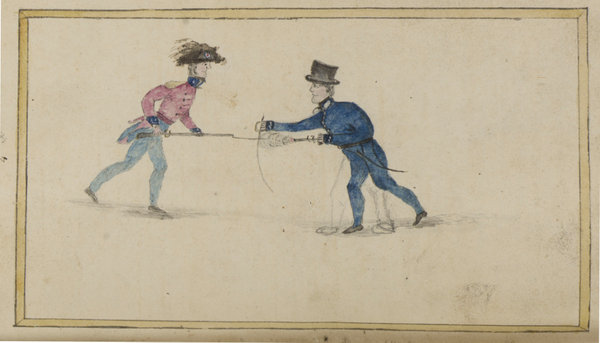
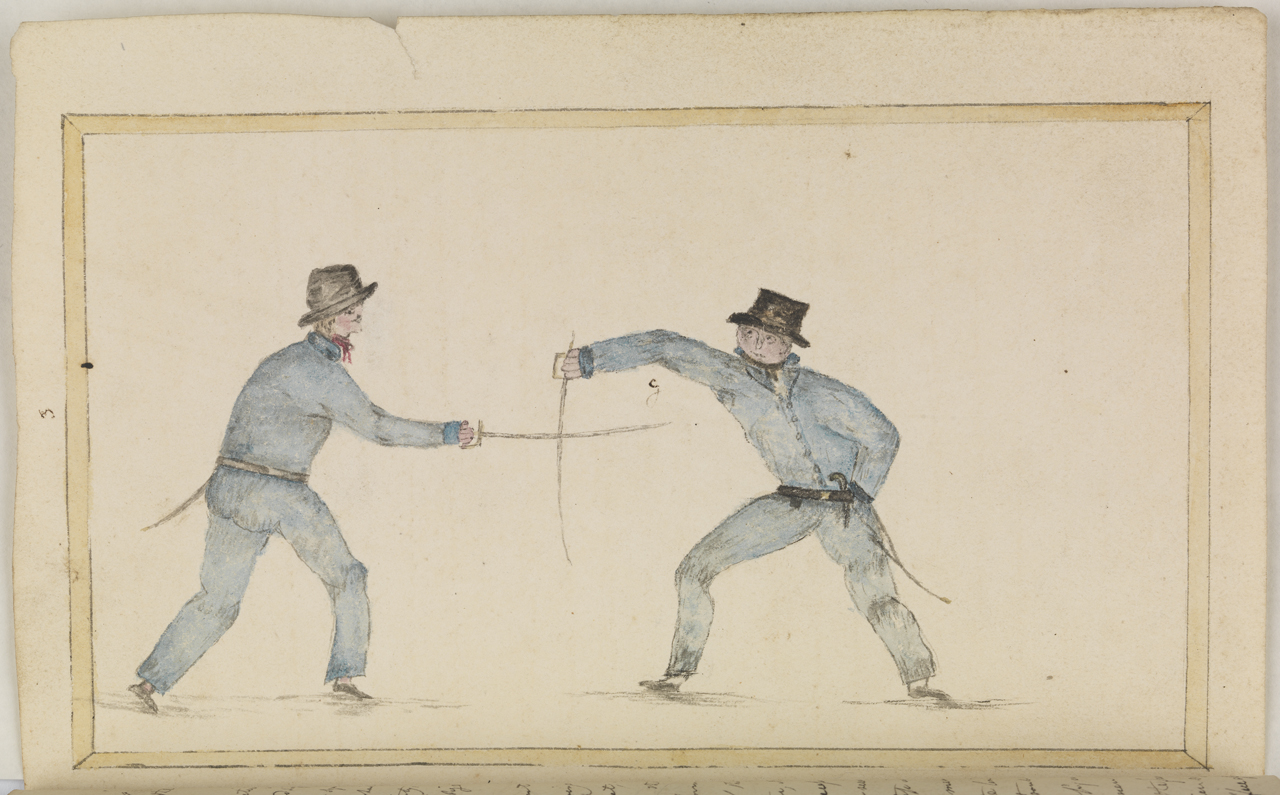
Lieutenant Green’s text makes a few important notes. First, the seaman armed with a cutlass must know more than just protect left (inside, quarte), protect right (outside, tierce), protect head (St. George, modern saber quinte), and cut & thrust. High seconde and prime–“falloon” or hanging guards–are useful for parrying, and are mandatory to parry a musket, as he illustrates, as also half-pikes (Girard illustrated this with the smallsword in the mid-eighteenth century). The low seconde and prime parries are just as important. Second, the pistol can be used to parry when reversed along the forearm. In fact, even when holding the pistol by the grip a parry can be made, and also a forehand blow with the barrel. However, it is well to remember that Pringle Green’s text is not an exposition of hand-to-hand naval combat in actual practice, but his ideas on how it might be done better. Caveat emptor.
I’ll also point out here a rather irksome issue on occasion, that some students of historical swordplay still attempt to argue that parries with cutting swords were made with the flat rather than the edge. This is nonsense. There are some forms of swordplay, Filipino escrima and some Caribbean and Central American machete practice for example, that parry with the flat. Notably, these weapons do not have guards, and if parries are not used sparingly, and made carefully, fingers will be lost (which is almost certainly why serious sparring and actual combat with these weapons is often either in “absence of blade” and emphasizes tempo actions, or involves grappling and other manipulations in order to control the adversary’s blade). However, the forms of cutting swordplay with Western battlefield weapons–saber, broadsword, backsword, hanger, cutlass–all show the use the of the edge for parrying in texts, illustrations, and other accounts. The objection is that a parry will damage the cutting edge. And so it will. But typically the forte is used for parrying, which is seldom sharp, and even if it is, is seldom used for cutting. Moreover, those who argue for the flat rather than the edge, in spite of overwhelming evidence to the contrary, forget one thing: each time the adversary parries your blade, it will be nicked. A blade is going to get damaged in combat. In fact, there are plenty of historical accounts of swordsmen proudly noting their “saw-toothed” blades as proof of just how desperate the combat was. It is also much easier to control a heavier weapon in the parry when parrying with the edge, and more powerful parries may be made this way.
THE TERMS HANGER VERSUS CUTLASS
In regard to the myth that ‘hanger’ was the sole term used to refer to the common cutting sword at sea–to the cutlass, in other words–in the 17th century, and that ‘cutlass’ was only an eighteenth century term, I’ve excerpted the following from a Mariner’s Mirror article I wrote a few years ago (“Eyewitness Images of Buccaneers and Their Vessels,” vol. 98, no. 3, August 2012). I added it to the original draft after a pre-publication editorial reader for the journal suggested I may have used the term cutlass in error. I had to prove I was correct.
From my article: “Still debated today are the issues of whether hanger or cutlass is the more appropriate English name for the short cutting sword or swords used by late seventeenth century mariners, and whether the words refer to the same or different weapons. Hanger and cutlass (also cutlash, cutlace) are each found in English language maritime texts of the mid to late seventeenth century. In some cases there appears to be a subtle distinction made between them; in others they are used interchangeably.
“The English 1684 Malthus edition of Exquemelin’s The Buccaneers of America refers only to ‘cutlace’ or, more generically, sword as the buccaneer’s arme blanche. There is also at least one reference in the Calendar of State Papers, Colonial, dating to the 1680s, associating the term cutlass with Caribbean pirates.[1] The 1684 Crooke and 1699 Newborough editions of Exquemelin refer to both hanger and cutlass, and use the terms interchangeably in reference to the sword of the notorious buccaneer Jean David Nau, better known as l’Ollonais. (Hanger once, cutlass twice, as well as a note that his men were armed with cutlasses.)
“It is possible that the description of l’Ollonais’s use of his sword to mutilate and murder prisoners may have given first rise to the reputation of the cutlass as the arm of the romanticized ‘cutthroat pirate’, a reputation enhanced by Charles Johnson’s pirate history forty years later, and then by Robert Louis Stevenson and other nineteenth century novelists. Even so, the cutlass already had a sanguine reputation, doubtless inspired in part by its descriptive, alliterative name: ‘by the bloudy cut-throat cuttleaxe of swaggering Mars’ wrote Thomas Coryate in 1611. By the eighteenth century, cutlass was the predominant English term for the seaman’s short-bladed cutting sword.”[2]
In the British colonies in America, the term cutlass was often used rather than hanger in lists of militia and trade arms as well: Caribs “well armed with new French fuzees, waistbelts and cutlasses” (August 3, 1689); “100 cutlasses” (Maryland, February 4, 1706); “100 cutlaces with broad deep blades” (Maryland, June 23, 1708); “2,000 cutlasses” (South Carolina, July 8, 1715). That said, some colonies used the term hanger instead in the same period. (All citations from the Calendar of State Papers, Colonial, America and West Indies.)
The earliest Caribbean reference to cutlasses I’ve found to date is in “The Voyages of Captain William Jackson (1642-1645),” a first-hand account describing Jackson’s most famous plundering voyage from one end of the Caribbean to the other: “The Armes delivered out to each company were, Muskitts, Carbines, Fire-locks, Halfe-pikes, Swords, Cutlases, & ye like offentius weapons…” Notably the term “hangers” is not used. English naval inventories of the 17th century tend to list “hangers” and “swords” as the two sorts of swords carried aboard, sometimes listing both, sometimes only one, confusing the issue. (And no, for the occasional “expert” who wants to argue, the term hanger in naval inventories at this time refers to short cutting swords, not sword hangers.) Worse, I’ve seen “swords and cutlasses” listed among the arms of various merchantmen. Almost certainly swords other than cutlasses and, among some officers, smallswords, were commonly carried aboard ship. Certainly they were aboard Spanish men-of-war, which had a large proportion of soldiers aboard: perhaps the earliest “Bilbao hilt” cutting sword, popular in the 18th century, dates to the 1660s and was found aboard a Spanish wreck. [See Sydney B. Brinckerhoff, Spanish Military Weapons in Colonial America, 1700-1821, regarding the Bilbao hilt. Jackson’s journal was published in Camden Miscellany vol. 13, 3rd series vol. 34, 1924; the quote refers roughly to September-October 1642.]
There are plenty of other seventeenth century references to the cutlass as the predominant maritime sword or term for maritime cutting sword, as opposed to the hanger: a July 1667 report of a Dutch descent on the English coast describes the attackers carrying muskets and with cutlasses drawn; there are at least two references in the papers of Charles II to Biscayners and Dunkirkers (privateers) assaulting English merchant captains with cutlasses; the 1682 inventory of the English merchantman St. Christopher of South Carolina included “ten swords & Cutlases;” mariner Robert Everard noted a cutlass among the arms of a dying French pirate who had boarded his ship, the Bauden, in 1686 (another witness referred to it as a scimitar, a generic term for a sword with a curved blade); the 1690s broadside ballad “A Satyr on the Sea-Officers” included the line, “With Monmouth cap, and cutlace by my side…,” clearly denoting its naval use; and witnesses to the fight between the Dorrill and the pirate ship Mocha in 1697 noted that the pirates were armed with “cutlashes”; and an authority-abusing Scottish captain, part of the Scottish expedition to Darien, was described thusly: “Capt. Drummond sent his men with drawn cutlasses on board a ship, Adventure, John Howell, master, and bade deponent, who was piloting her, to anchor her under the guns of his ship.” In the Deposition of William Fletcher, May 2, 1700, the said ship master described being his beating by pirates “with the flat of the Curtle-axes.” See also the endnotes below for other seventeenth century cutlass references associated with pirates and sea rovers.
It is quite possible that the distinction between cutlass and hanger was originally determined by the blades: a broad bladed weapon with a short blade length used by soldiers and seamen was originally defined as a “curtle-axe” (Shakespeare even uses the word) or cutlass, while one with a narrower blade was a hanger. Cutting blades heavy “at the tip” are excellent for cleaving cuts even at close distance: anyone who’s used a cutlass with such a blade for cutting practice will recognize this immediately, as will anyone who’s used a Filipino bolo knife. I’m speculating, of course, but the cutlass may have found preference at sea due to its greater ability at close quarters. Clearly, swords by both names were used, but the name cutlass stuck perhaps due to its greater efficacy.
This theory of cutlass versus hanger is supported by the French definition of coutelas from the 1694 edition of Le Dictionnaire de l’Académie française: “Coutelas. s. m. Sorte d’ espée courte & large, qui ne tranche que d’ un costé. Coutelas bien tranchant. coutelas de Damas. un coup de coutelas. il luy a fendu la teste de son coutelas, avec son coutelas.” That is, a kind of sword with a short wide blade, which cuts only one side. A 1708 Maryland arms list notes “100 cutlaces with broad deep blades” (cited above), suggesting that the term had become associated more broadly with short cutting swords in general.
Further, to those who still insist that “hanger” was the more common word, note that the 1678 English translation of Louis de Gaya’s treatise of arms does not translate “coûteau de chasse” as “hunting hanger” but as “hunting cutlass.”
It bears repeating that longer swords were often carried in addition to cutlasses, given that we find accounts of “cutlasses and swords” and “hangers and swords” in ship inventories (although the occasional ignorant Internet pedant, more often than not a re-enactor) will attempt to assert that the term hangers refers only to sword-belts.
An associated trivium is in order: the French term hassegaye (from Old French azagaie, Arabic az-zaġāyah, etc.) derives from an old word meaning “short spear,” and in the nineteenth century meant a short boarding pike. However, in the late seventeenth century it’s described as the word for the cutlass a ship’s captain wielded in action by holding it aloft, usually to inspire the crew as well as to intimidate the enemy. By waving it, the captain was demanding surrender, that is, ordering enemy colors and topsails “amain”–lowered, that is. “C’est un coutelas que le Capitaine tient en la main au bras retroussé pendent le combat.”
In any case, I leave you with a quote from a witness to de Ruyter’s raid on Barbados in 1665: “I did see him [de Ruyter] on the poope, with a cane in one hand, and a cuttle axe in the other, and as he stayed [tacked] I did see most part of his quarter carried away.” The cutlass may even have been the one whose hilt is depicted above. [From “A True Relacion of the Fight at the Barbados Between the Fort and Shipping There…,” in Colonising Expeditions to the West Indies and Guiana, 1623–1667,” edited by V. T Harlow (London: Hakluty Society, 1925). The “cane” was almost certainly de Ruyter’s long admiral’s baton.
MORE INFORMATION
For more information on the use of the cutlass at sea and ashore 1655 to 1725, in particular on its effectiveness as well as on its use in dueling, see The Golden Age of Piracy: The Truth About Pirate Myths, chapter 8. (My publisher won’t appreciate my repeating the information here; by agreement I am not supposed to.) Both The Sea Rover’s Practice and The Buccaneer’s Realm also include information on the cutlass and other swords; the latter has an entire chapter devoted to associated late 17th century swords and swordplay. In sum, there’s a bit more information. For example, Bras de Fer missing his Spanish adversary and cutting through his hat instead, then tripping over a root as he attempted to renew his attack; the possibility of techniques similar to those used with the dusack (e.g. grazing and yielding actions in a single tempo); &c.
That said, I will add a note to dueling here even though far more information is in The Golden Age of Piracy (including the only confirmed description of a duel fought between buccaneer captains). Although it’s unlikely that duels were regularly, or even occasionally, fought aboard ships, for reasons and evidence discussed in The Golden Age of Piracy, it doesn’t mean there weren’t occasional affrays with swords aboard ship. Peter Drake, an Irish officer, one of the so-called “Wild Geese” who left Ireland after the defeat of James II, describes how in 1701, as he joined a Dutch regiment in Dublin and waited aboard a Dutch ship to sail to the Netherlands, “Among the recruits we had two prize-fighters, who, getting drunk, fell to quarrelling; the company declaring, each for the one whose cause he espoused, an uproar ensued, and several strokes were exchanged.” But this was a brawl more than anything else, and among soldiers, not seamen. Note that prize-fighters fought primarily with various swords, as well as with quarterstaff, and occasionally with fists. (Peter Drake, The Memoirs of Peter Drake [Dublin: S. Powell for the Author, 1755]. Stanford University reprinted the memoirs in 1960, edited by Paul Jordan-Smith.)
SUGGESTIONS ON PURCHASING REPLICA BUCCANEER CUTLASSES
If for whatever reason — historical research, reenactment, swashbuckling flair for your wall, modern piracy — you want a reasonably historically accurate cutlass replica, you’re sadly and mostly-but-not-entirely out of luck. There are only a handful of sword-makers who forge what can be termed historically accurate functional cutlasses, and they’re typically priced at US$500 to $1000 or more. Few typically have stock on hand; most are commissioned orders that may take months or years for delivery. Loyalist Arms stocks a small variety of cutlasses suitable to the era. Likewise, At the Royal Sword periodically stocks a few mostly historically-accurate cutlass and hanger replicas suitable to the buccaneer and early 18th century pirate eras. Cold Steel has a hunting hanger and a “pirate” cutlass (the latter is a recent release and somewhat difficult to find as of December 2022) that are suitable, if not as accurate as might be desired. In particular, the “pirate” cutlass is more of a dusack; removing the side rings would make it more appropriate to the buccaneer era. Even so, it is something of an homage to the shell hilt cutlasses of reality and Hollywood, a “sea beast” of a cutlass, yet with beautiful balance, as might have been carried — we imagine — by Alexandre Bras de Fer, “Rocky” the Brazilian, or the infamous l’Ollonois. It and the hunting hanger with small shell are quite functional and nice pieces for the price. Note that most cutlass replicas on the market are historically inaccurate, anachronistic, or pure fantasy (some have elements of all three); many are wall-hanger junk that could not be used for actual combat.
NOTES
[1] CSPC, 1681-1685, no. 1509. January 19, 1684. “A Relation of the capture of Providence by the Spaniards. On Saturday, 19th January, about 3 o’clock, Juan de Larco with two hundred and fifty Spaniards came down the harbour and landed at Captain Clarke’s, half a mile to east of Charlestown. Captain Clarke being out of doors near the waterside, some men in ambush shot him through the thigh and cut his arms with a cutlass, and then they marched away with all haste to the town, firing into some houses as they went…”
Another instance described in CSPC, 1677-1680, no. 1624. December 30, 1680, deposition of Robert Oxe.”The Spaniards killed two men and cruelly treated the deponent, hanging him up at the fore braces several times, beating him with their cutlasses, and striking him in the face after an inhuman cruel manner.” The Spanish pirate hunters were commanded by Captain Don Felipe de la Barrera y Villegas. Under his command were Juan Corso and Pedro de Castro, two captains noted for their reprisal cruelty against English and French seamen.
[2] Thomas Coryate, ‘Laugh and be Fat’ in Coryat’s Crudities (reprint London, 1776), vol. 3:n.p. Regarding foreign terms for cutlass, the original Dutch edition of Exquemelin’s work (1678) uses sabel (saber), as does David van der Sterre’s 1691 biography of Caribbean sea rover Jan Erasmus Reyning, but a 1675 English-Dutch dictionary notes kort geweer as the Dutch term for cutlass. Exquemelin’s Spanish edition (1681) uses ‘alfange’ (alfanje), whose root is the Andalusian Arabic alẖánǧar or alẖánǧal, from the Arabic ẖanǧar, a dagger or short sword, which some scholars have suggested is the origin of the English word hanger. The OED (2nd ed.) doubts this and derives it instead from the Dutch hangher. Although the Spanish connection to the Low Countries, and thus a connection to the Dutch term, appears suggestive, the English use of hanger predates Spanish rule. Alfanje is typically translated as cutlass, hanger, or scimitar. Exquemelin’s French editions (1686, 1688, 1699) refer to both coutelas and sabre, noting that flibustiers were armed in one instance with a good coutelas, in another a coutelas or sabre. Labat, describing the early flibustiers, notes each having a well-tempered coutelas among their arms. Most etymologists consider cutlass to be derived from coutelas. Saber, sabre, and the Dutch sabel derive from the German sabel, with authorities noting the term’s Slavic origin.
Regarding the various spellings of cutlass in the mid-seventeenth to early eighteenth centuries: cutlass, cutlace, cutlash, curtlass, curtelass, courtlass, courtelass, and curtle-axe are all common.
Copyright Benerson Little 2016-2018. Originally published December 31, 2016, last updated June 6, 2023.
Walking the Plank: An Associated Image

“Kapitein Lambert Hendrikszoon laat 125 zeerovers ophangen aan de ra’s van zijn schepen of in zee gooien voor de haven van Algiers, ca. 1619, Jan Luyken, 1682 – 1684.” (Rijksmuseum.)
In The Golden Age of Piracy: The Truth Behind Pirate Myths, I’ve devoted an entire chapter to this myth of walking the plank. The image above is of a Dutch flotilla commanded by Captain Lambert Hendrikszoon circa 1619 harshly negotiating a peace treaty with Algiers, notorious for its “Barbary corsairs.” Note that a corsair was a privateer, not a pirate, although often the Barbary corsairs were referred to as pirates–after all, they were not “Christians.” Even so, they were lawfully commissioned and were pirates only if they went to sea without a commission to hunt prey. A major part of Barbary corsair plunder consisted of prisoners–Christians, often–taken as slaves. This was naturally an objectionable, heinous, barbaric (note the origin of the word) practice. Yet Europeans often hypocritically failed to note the irony that Barbary corsairs were enslaving people who themselves engaged in the slave trade of Africans, Native Americans, mixed races, and sometimes even of Asians–and, at least to the early 18th century, North Africans.

Detail. (Rijksmuseum.)
In the detail below, Algerine prisoners are being murdered in reprisal, in this case via “walking the plank”–but clearly no plank was necessary.
An Early Skull & Crossbones at Sea, and More
Invariably as one of my books is published, my continued research uncovers relevant information ranging from corrections to supplementary material. In the past I have posted this information in a pdf file, often quite lengthy, but for this book I intend to post on the book’s page (GAoP above) and also especially on this blog.
And for my first supplement, a painting by Jacob Gerritsz, mid-seventeenth century, of an allegorical ship representing the Holy Roman Catholic Church. The painting is intended as anti-Calvinist propaganda demonstrating that Calvinists and other “Reformers,” including Calvin himself firing a musket at the ship, cannot harm the Holy Church. One of the banners the ship flies is a skull and crossbones, the earliest I’ve seen to date. The flag is merely a symbol here, representing death, but could the painter have been aware of the flag flying for real somewhere?

“Das Schiff der Kirche” by Jacob Gerritsz, circa 1640 to 1649. Copyright DHM/Museum Catharijneconvent Utrecht.
Probably not, for why would the Church depict a ship (one of decidedly Spanish design) representing the Church flying a pirate banner? This is hardly the message the Vatican would like to present as an argument against Calvinism. More likely would be Calvinism, in the Roman Catholic Church’s eye, flying the flag of piracy.
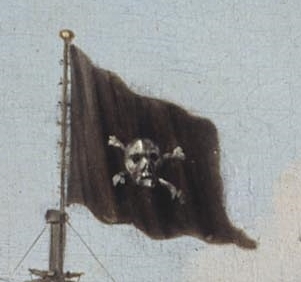
Detail from “Das Schiff der Kirche” by Jacob Gerritsz.
The fact is, although the skull and bones was used extensively as a mortuary symbol, and may have been flown at this time by some Barbary corsairs, it does not appear to have been regularly flown, with extensive attached symbolism, until the coming of the Anglo-American pirates in the early 18th century. Details, of course, are discussed in The Golden Age of Piracy: The Truth About Pirate Myths.
The same black flag with skull and crossbones is similarly used in an allegorical poem of the early 18th century, prior to the American pirates who flew the skull and bones, to represent the banner of Charon, ferry-master of the Styx in Hades.
The death’s head in the painting above has a frightening three dimensional aspect, which would take a talented pirate to replicate with paint and brush. Most, we imagine–and we can only imagine, having no existing pirate flags from the Golden Age from 1655 to 1725, only written descriptions–would be simple fabric cutouts or simple painted images. However, in The Golden Age of Piracy I do discuss the flag of Jean Thomas Dulaien who sailed shortly after the period, for which we have a written description, as well as images of a purported drawing and of a purported woodblock made from the drawing. All are similar but none exactly matches the other. The original flag was reportedly destroyed on the order of Louis XIV.
Except for a skull and bones flown on a red field–a flag of no quarter–by French flibustiers in 1688, and perhaps before and after, we have no evidence of their use among pirates and other sea rovers of European origin until the early 18th century, the first in 1700, and the rest circa 1715 and afterward. They may have been in use prior to this time by some of the Barbary corsairs. Details can be found in the first chapter of The Golden Age of Piracy: The Truth Behind Pirate Myths.
Banners with skull and bones have reportedly been around a long time, although depictions of them in art prior to the eighteenth century are difficult to find. Below is one by Hulderich Froelich of Basil, Switzerland, part of his 1588 Todtentanzes or “Dance of Death” series, one of which is Zwen Todentäntz, deren der eine zu Bern. Charles Hill, in his Episodes of Piracy in the Easter Seas, 1519 to 1851, published serially in the 1919 and 1920 editions of The Indian Antiquary, points this illustration out. Froelich’s “Dance of Death” along with others, is discussed in fair detail in here.
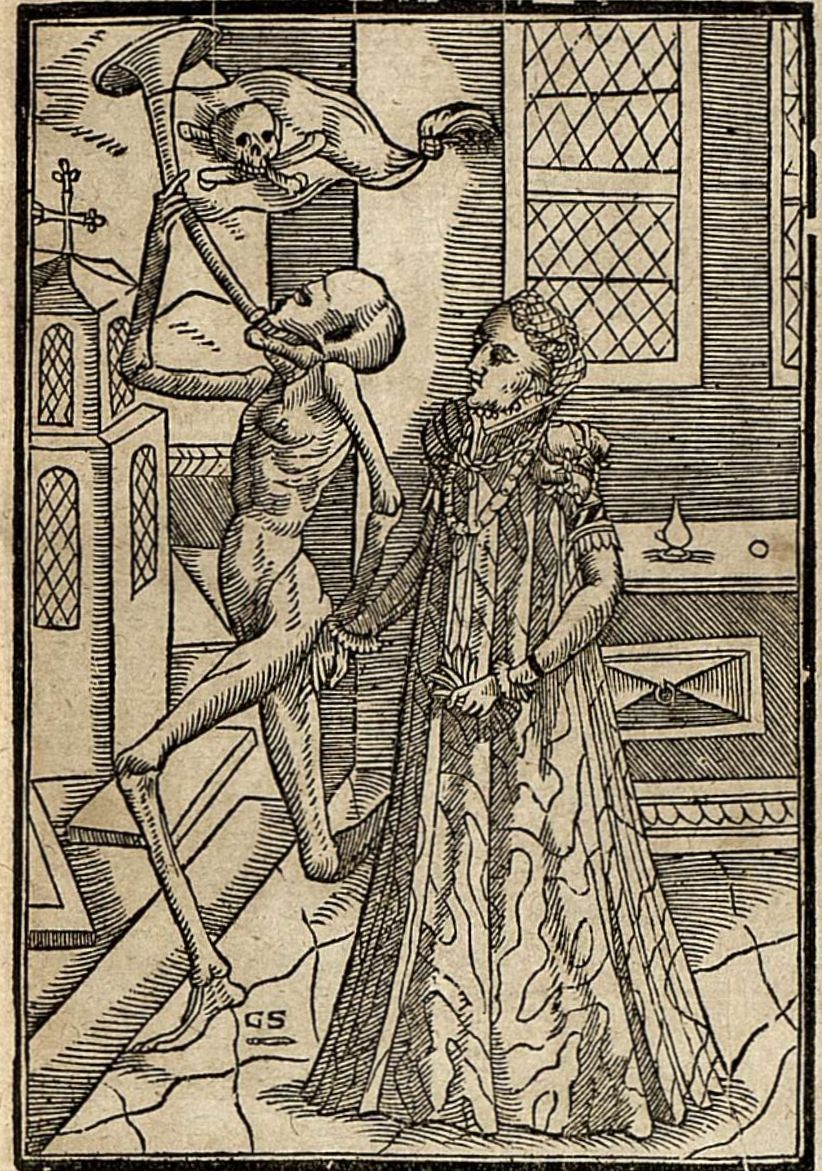
For the curious, what might the skull and crossbones, or skeleton, have looked like on real pirate flags of the early 18th century? We have only one likely authentic example of one, and it’s only a purported drawing of the flag of a French pirate, and of a woodcut believed to have been made from the drawing. More on them in a moment. The following are skulls and bones taken from a few late seventeenth century image showing various representations.

Detail from a portrait of Ernst Eberhard Friedrich, Count of Hohenlohe-Langenburg. Circa 1671. After Johann Georg Kreutzfelder, print made by Jacob von Sand. British Museum.

Detail from the Dance of Death series. After Abraham van Diepenbeeck (border), after Hans Holbein the Younger, print made by Wenceslaus Hollar. 1651. British Museum.

Detail from the Dance of Death series. After Abraham van Diepenbeeck (border), after Hans Holbein the Younger, print made by Wenceslaus Hollar. 1651. British Museum.
As for the one real “Golden Age” pirate flag we have an image of (there are no existing examples of real pirate flags from this era), it just barely makes it into the era, as at 1729 it’s late for the period that generally is regarded to end at 1725 or 1728. It’s also not the flag of a pirate of an Anglo-American pirate, but a French one, from France and returning to France. The pirate in question is Jean-Thomas Dulaien, whom I’ve discussed along with his flag in The Golden Age of Piracy. The first image below was reportedly created from the original flag, which was reportedly destroyed by order of Louis XIV; the second is of a woodblock or woodblock print made from the image.

The purported Dulaien original, copied from the actual flag. Clearly, if the image is accurate (there’s no reason to believe it is not), the skull, bones, and man with cutlass and hourglass was painted on. The original flag was, according to reports at the time, destroyed.
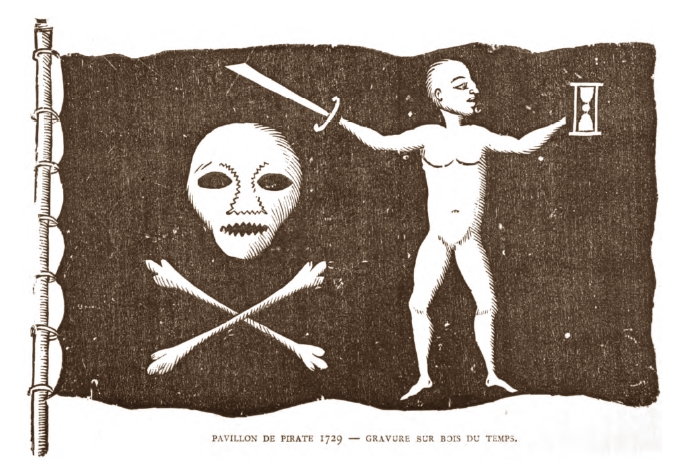
The purported woodcut image made from the original illustration. Clearly it is only a representation of the original image, and not an entirely accurate reflection.
Likewise, since publication I’ve also identified earlier images of the red flags of the Islamic corsairs, one dating to 1711, the others probably 1707 to 1711. Clearly these sea-going flags were around prior to the Anglo-American pirates who used similar flags, as were others I’ve noted in the book itself.
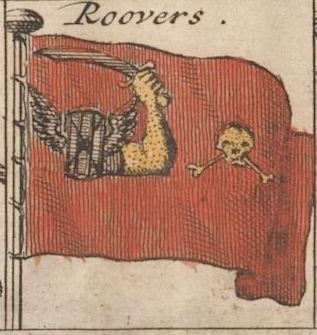
Schouw-park aller Scheeps-vlaggen des geheelen Water-Waerelds, 1711. The flag is shown among Barbary and Turkish sea flags. This flag is popularly, and incorrectly, attributed to the pirate Christopher Moody. (Rijksmuseum.)

Ottoman corsair flag from Nieuwe Tafel van alle de Scheeps Vlaggen des Gehele Water-Waerelds op Nieus Vermeerdert en Verbeeterdt, probably dating 1707 to 1711, possibly slightly later, based on some of the English flags shown. The Rijksmuseum incorrectly dates it 1650 to 1700.

Algiers red banner with death’s head, from Nieuwe Tafel van alle de Scheeps Vlaggen des Gehele Water-Waerelds op Nieus Vermeerdert en Verbeeterdt, dated as immediately above.
And last, a note on the purported flag of Blackbeard. Historian Ed Fox has pointed out that, according to The Mariner’s Mirror (1912, vol. 2, no. 3) the horned Blackbeard flag first appears in The Book of Buried Treasure by R. D. Paine (Ralph Delahaye), 1911. The book was reprinted in 1981 by Arno Press. The drawing is fanciful but is based on a legitimate period description of a pirate flag. A later artist or publisher ascribed it, with minor modification emphasizing devil horns, to Blackbeard.

Copyright Benerson Little 2016-2018. Originally published December 19, 2016, last updated December 9, 2018.






